Need to know the way to construct a gaming PC with your individual alternative of parts, however don’t know the place to start out? Whether or not you’re new to the great world of PC constructing, otherwise you’re just some years out of the loop, you’ve come to the fitting place, as our information will take you thru each step of the method.
In the event you’re not sure which PC parts try to be utilizing, take a look at our information to the finest gaming CPU to search out the most effective processor to your wants and finances, and likewise learn our greatest graphics card information. When you’ve chosen the specs that finest meet your wants, learn on to learn how to place all of it collectively.
Right here’s the way to construct a gaming PC, step-by-step:
1. Get the fitting instruments
It’s actually essential to have the fitting instruments for the job – when you don’t, that extremely anticipated Friday night of PC constructing you may have deliberate will come to an abrupt halt when all of the outlets are shut and Amazon can’t ship till the subsequent day. That is our listing of important objects you’ll want.
Cable ties
Many PC circumstances embody cable ties, and even useful Velcro ties that assist to collect cables into neat teams. Nevertheless, almost all circumstances lack an sufficient variety of cable ties to anchor down all of the cables in a typical PC. A pack of 100 prices round $5-10, and it’s undoubtedly value having a few dozen at hand, so you may have sufficient ties to do an honest job of cable tidying. Seize some cable ties on Amazon to get began.
Mini screwdrivers
There are cases the place your common screwdriver isn’t sufficiently small. You’ll want a mini screwdriver set to cope with smaller screws, similar to these in M.2 SSD slots. These units solely value just a few quid and can be found from most {hardware} shops.
Needle-nose pliers
Chunky pliers have their place, however you’ll want a extra delicate set of pliers for PC constructing. Needle-nose pliers provide you with extra management and accuracy when coping with fan clips, enlargement slot covers, and different objects that want a little bit of drive to take away, however will mince your fingers when you attempt to do it along with your palms.
Thermal paste
Most processor coolers embody thermal paste, however some have it pre-applied or solely embody pitiful quantities. In the event you mess up the primary software, you’ll be able to find yourself with out the means to correctly apply extra thermal paste. It’s cheap and a small spare tube is an important merchandise in any PC fanatic’s toolbox. If it’s your first time constructing a PC, we suggest utilizing a ceramic paste, similar to ARCTIC MX-4.
Facet cutters
Facet cutters are perfect for shortly trimming cable ties when you’ve mounted them in place. They’re frequent in most toolsets, but when you must purchase a pair they solely value just a few kilos and are important for tidying your PC – scissors are sometimes a bit too blunt and unwieldy for the job.
No.2 Phillips screwdriver
This screwdriver will match the vast majority of screws in your PC, that are often fairly giant and require affordable drive to screw into place. Keep away from utilizing an electrical screwdriver, as they’ve an excessive amount of torque and might simply strip screw threads. You probably have one with a torque setting, solely apply it to a really unfastened setting.
Having a magnetic screwdriver is important too, as many PC screws have been misplaced at nighttime corners of PC circumstances, by no means to be seen once more. A number of PC screws are additionally secured horizontally, and can merely fall off your screwdriver if it’s not magnetic, or will no less than require you to make use of each palms to get it in place. If you have already got a screwdriver, nevertheless it isn’t magnetic, then you’ll be able to simply magnetize it with the assistance of (yep, you’ve guessed it) a magnet.
You probably have some magnets mendacity round the home wherever, even when they’re simply ones sticking novelty souvenirs to the fridge, place one onto the screwdriver shaft closest to your hand after which transfer the magnet right down to the tip of the screwdriver. Pull it off then repeat this course of ten occasions. It is best to now discover the screwdriver is magnetic and can maintain onto your screws itself.
Thermal paste cleaner
Thermal paste cleaner makes eradicating previous thermal paste a lot simpler by breaking it down and cleaning the surfaces prepared for the contemporary paste to be utilized. It will possibly additionally assist take away any paste that you simply get in your palms or garments, so it’s helpful to have some at hand. There are particular thermal paste cleaners out there, however isopropyl alcohol works simply as properly and might be cheaper too.
Microfiber fabric
Utilizing the fitting cleansing fabric is essential for PC constructing for a number of causes. You don’t need to use a fabric that sheds fibers, as this may create mud that may cling to thermal paste and hamper cooling.
Customary kitchen towels or family tissues have to be prevented, and you must guarantee the fabric is lint-free too, as lint can construct up static expenses. Lint-free microfibre towels are good for a number of jobs with PCs, from cleansing thermal paste off your CPU to sharpening glass facet panel home windows.
2. Know your ports and connectors
It’s typically not possible to plug a cable into fully the mistaken port relating to PC constructing today, so when you’re afraid of one thing blowing up, you’ll be able to relaxation assured this gained’t occur.
Nevertheless, some connectors are extra applicable than others for sure jobs, and it may be helpful to know what every connector appears like, and the place you put in them.
Energy provides (PSUs) include dozens of various connectors to cater for various configurations of {hardware}. You don’t want to verify each cable in your PSU is related to a part – you’ll nearly definitely have some left over. Beneath you’ll discover a listing of the frequent cables and connectors you’ll come throughout, on each your PSU and your different parts.
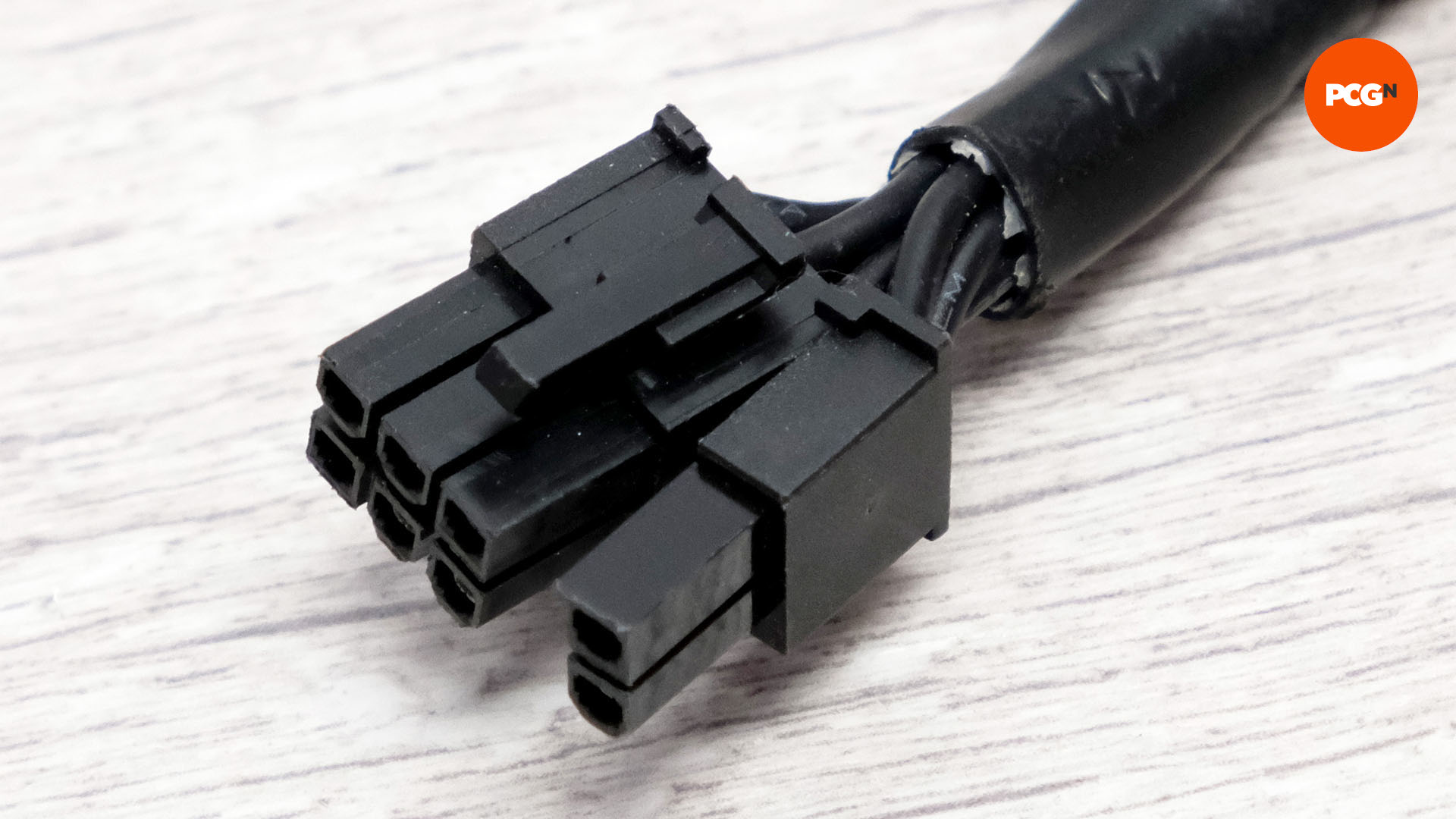
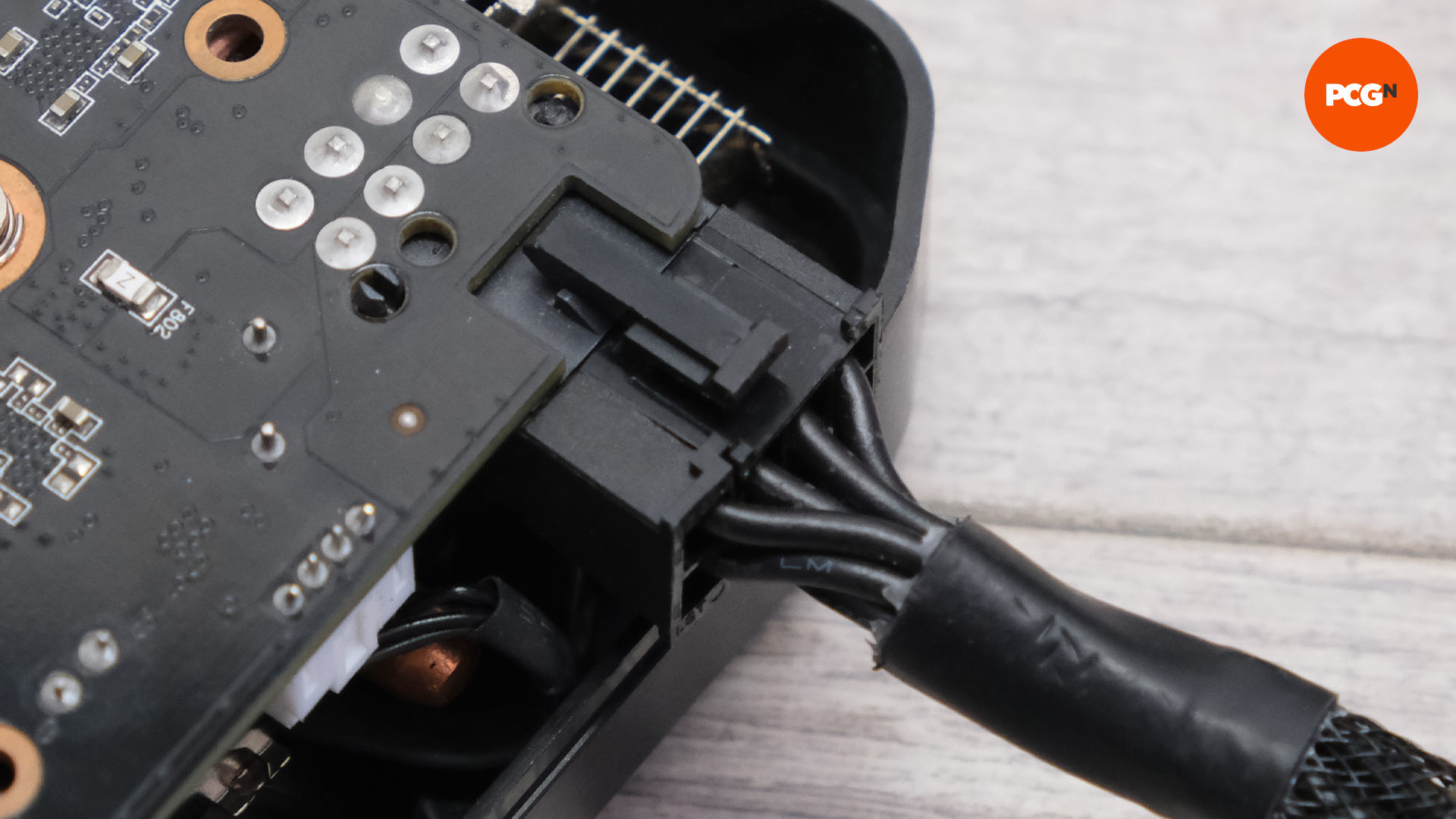
PCIe energy connector
This powers your graphics card and often comes cut up into two items, with one 6-pin connector and one 2-pin. Graphics playing cards have both 6-pin or 8-pin ports, so along with your PSU providing a number of of those connectors, you’ll be able to energy virtually any graphics card. The one means you’ll come unstuck is when you’ve got a really lowly PSU that doesn’t have sufficient of them, however most PSUs have no less than two, and solely probably the most huge and costly graphics playing cards have greater than this variety of energy connectors.
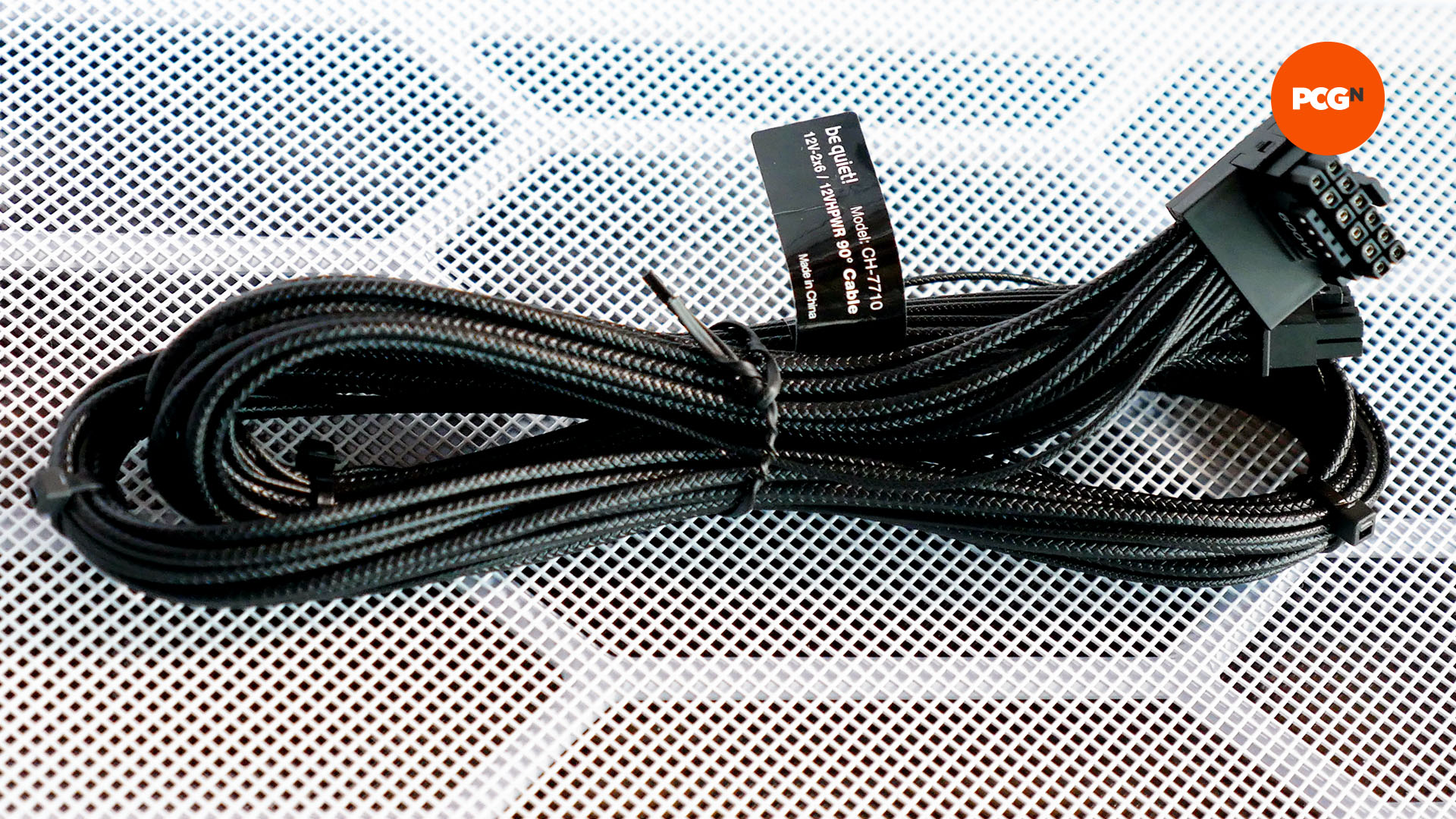
12VHPWR energy connector
This new 16-pin energy plug was primarily popularized by Nvidia when it launched its Ada GPU lineup, beginning with the RTX 4090. Your PSU might have a devoted cable for this plug, otherwise you may need to make use of an adaptor that plugs into the usual PCIe plugs proven above. The latter will come bundled along with your graphics card if it’d want one.
Keep in mind that insecure connection of those plugs of their sockets has been linked with melting graphics playing cards, so be sure your connection is tightly secured with a full click on earlier than you turn in your PC.
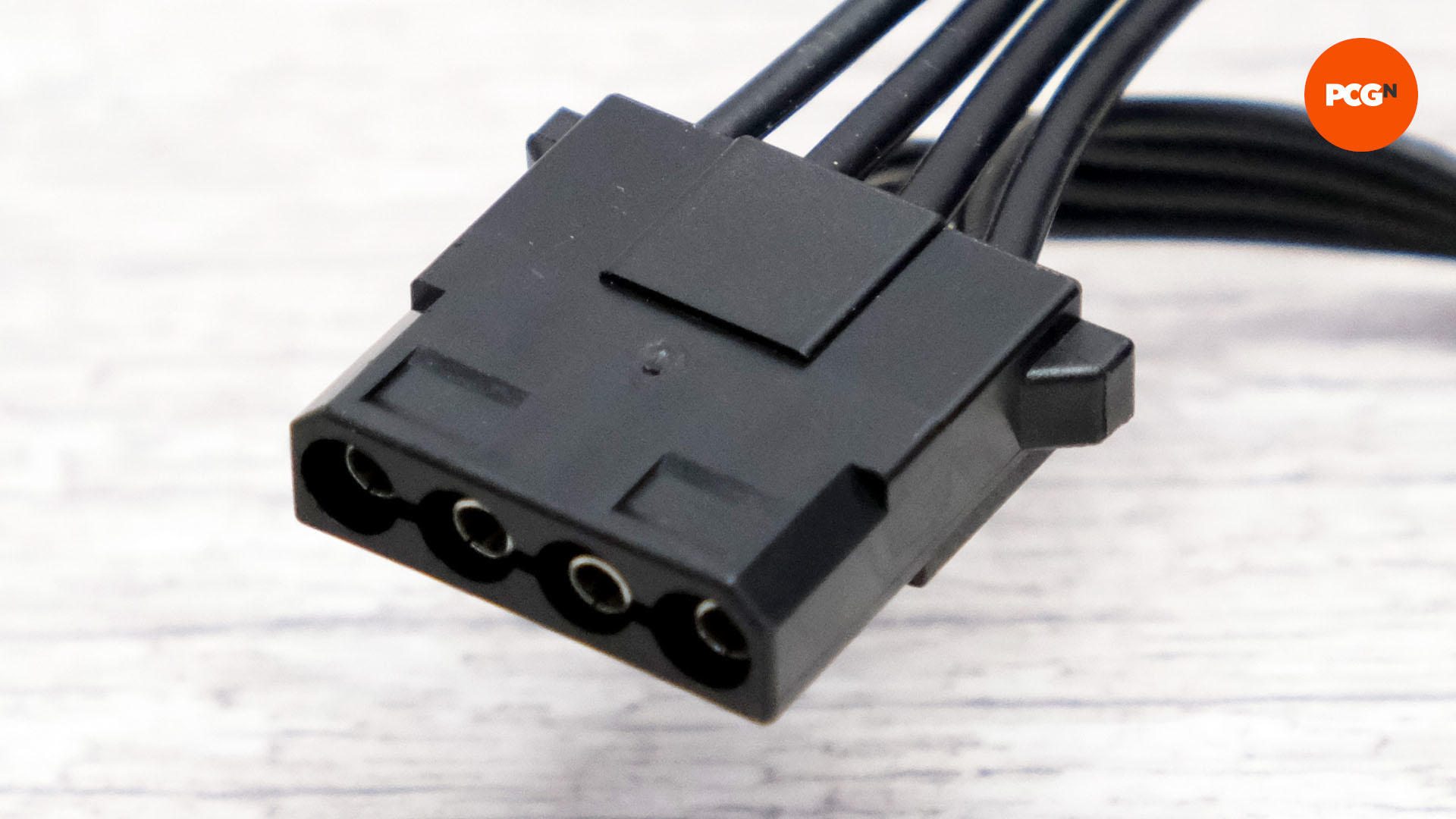
Molex connector
Hardly ever used at present, since SATA connectors do the identical job and are simpler to put in. Today, Molex connectors are sometimes used for followers or water-cooling pumps.
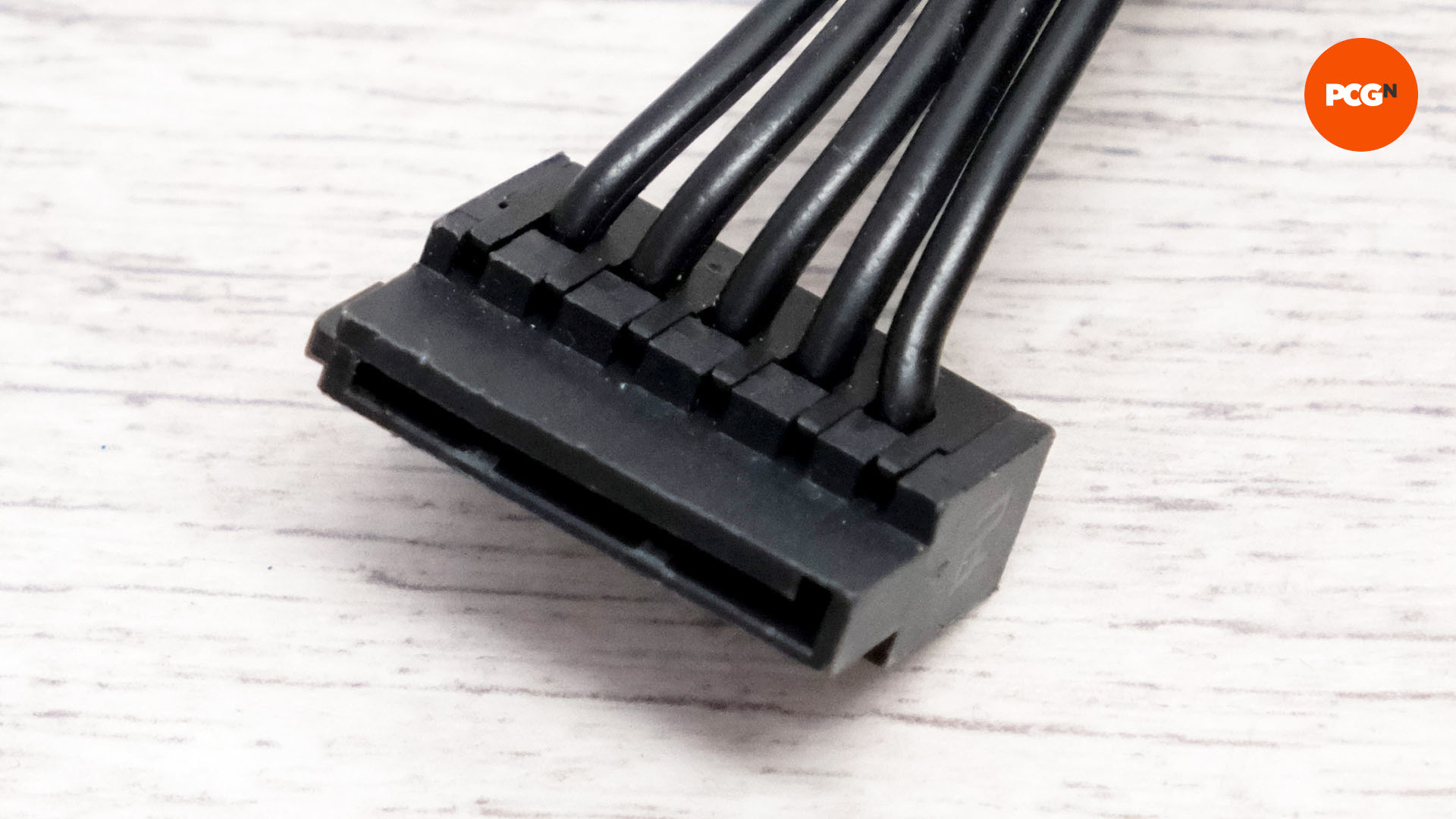
SATA energy connector
In the event you’re utilizing a 2.5-inch SSD and/or a 3.5-inch exhausting disk, you’ll must energy them utilizing a SATA connector. Many liquid coolers additionally use them. You’ll discover a number of on a single cable in your PSU, which might pose a cable-tidying problem.
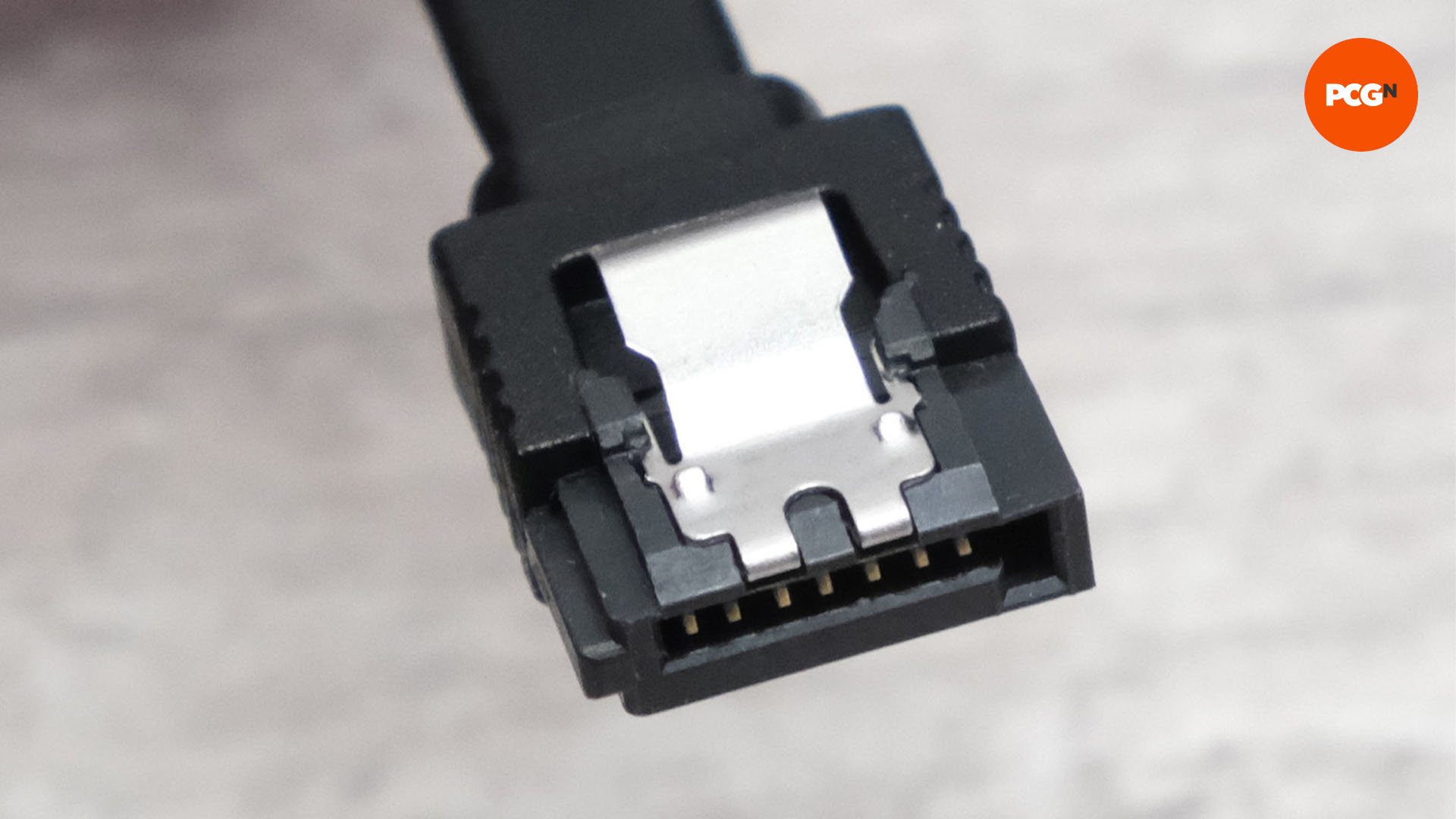
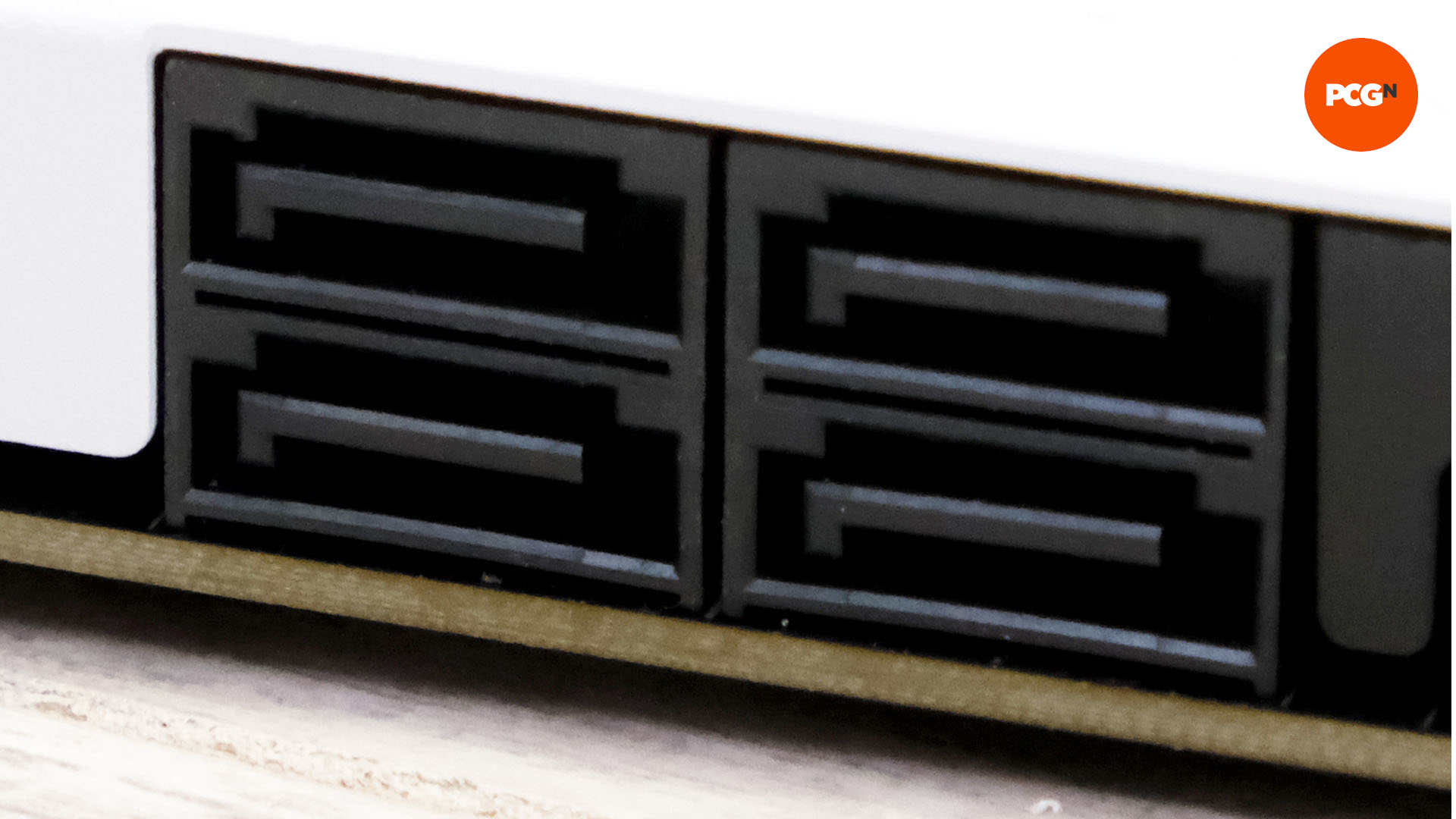
SATA information connector
Arduous disks or 2.5-inch SSDs have to be related to your motherboard to permit the back-and-forth switch of knowledge, requiring a SATA information cable to attach the 2. Motherboards have no less than two of those ports, with 4 or six ports being the commonest.
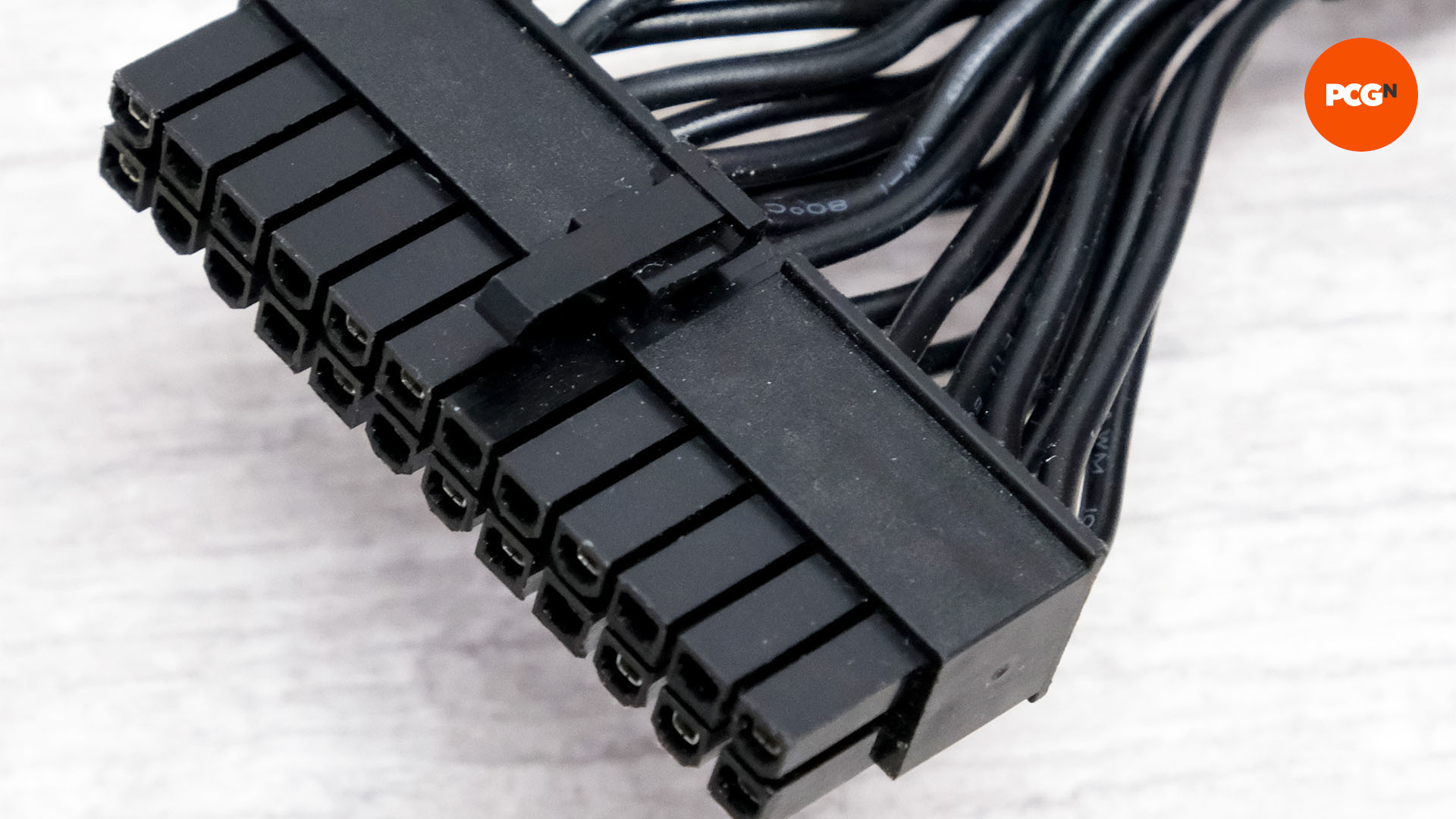
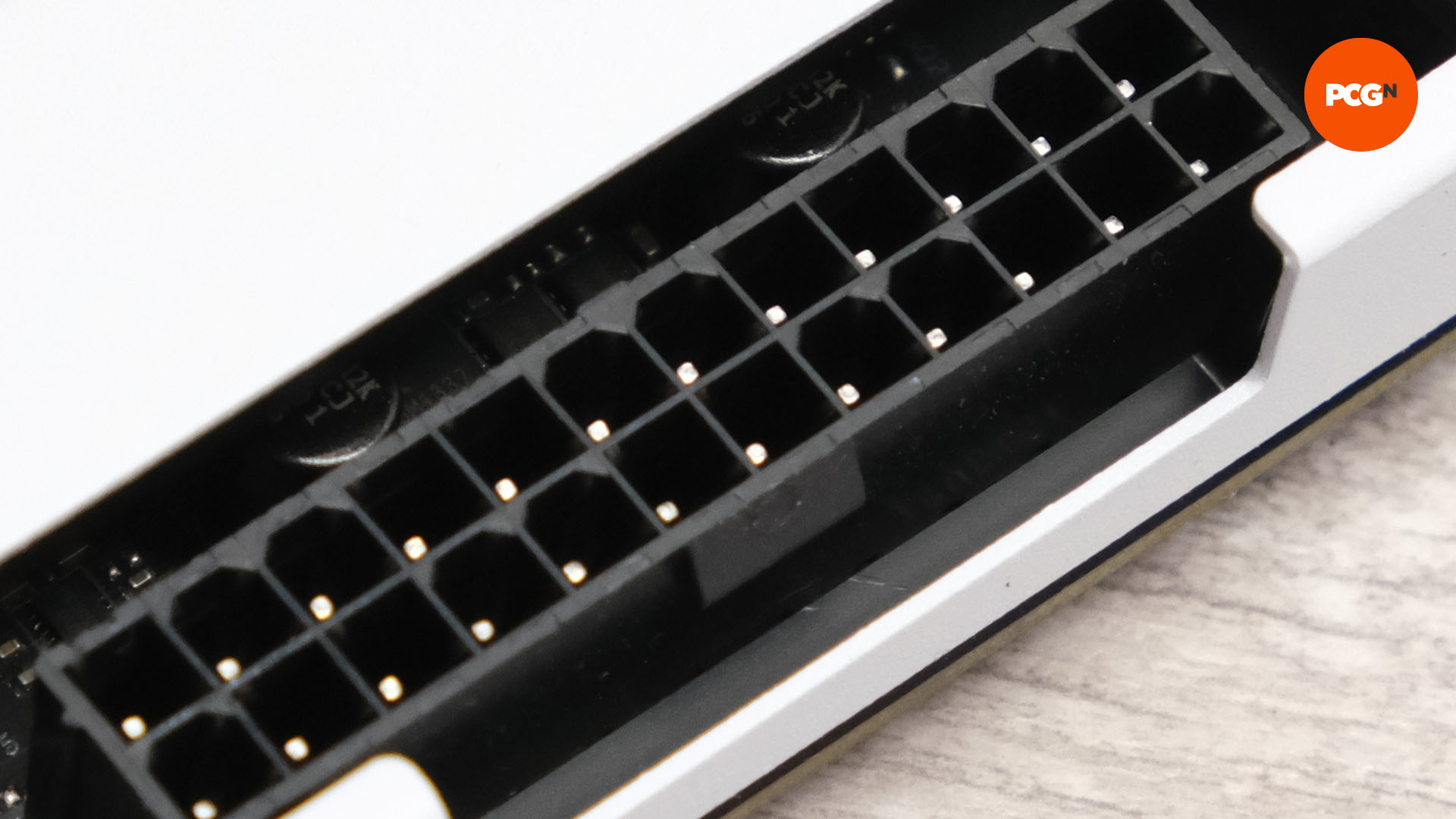
24-pin ATX connector
That is the largest port in your motherboard with a corresponding connector in your PSU too. It offers energy to parts and ports in your motherboard.
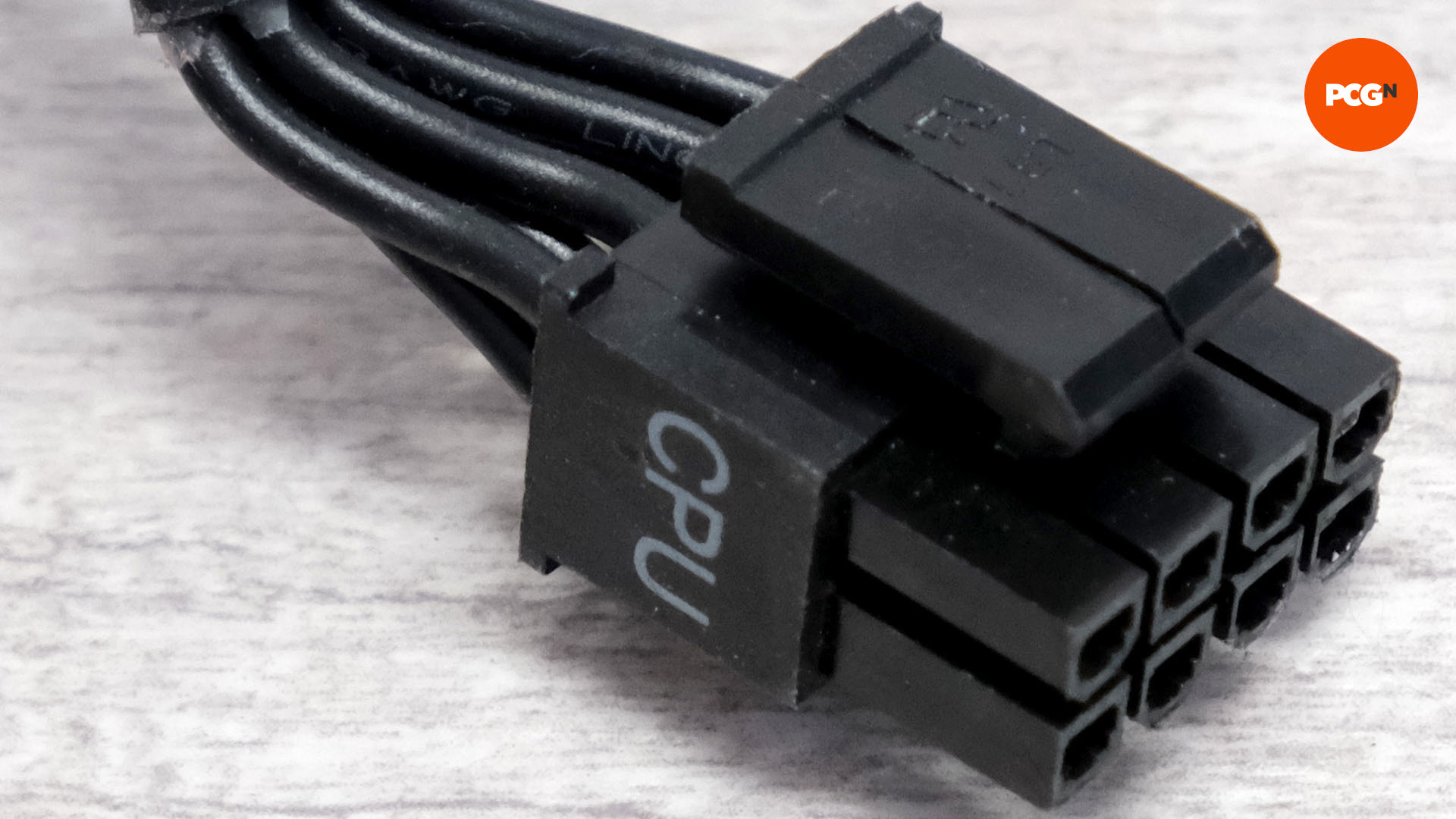
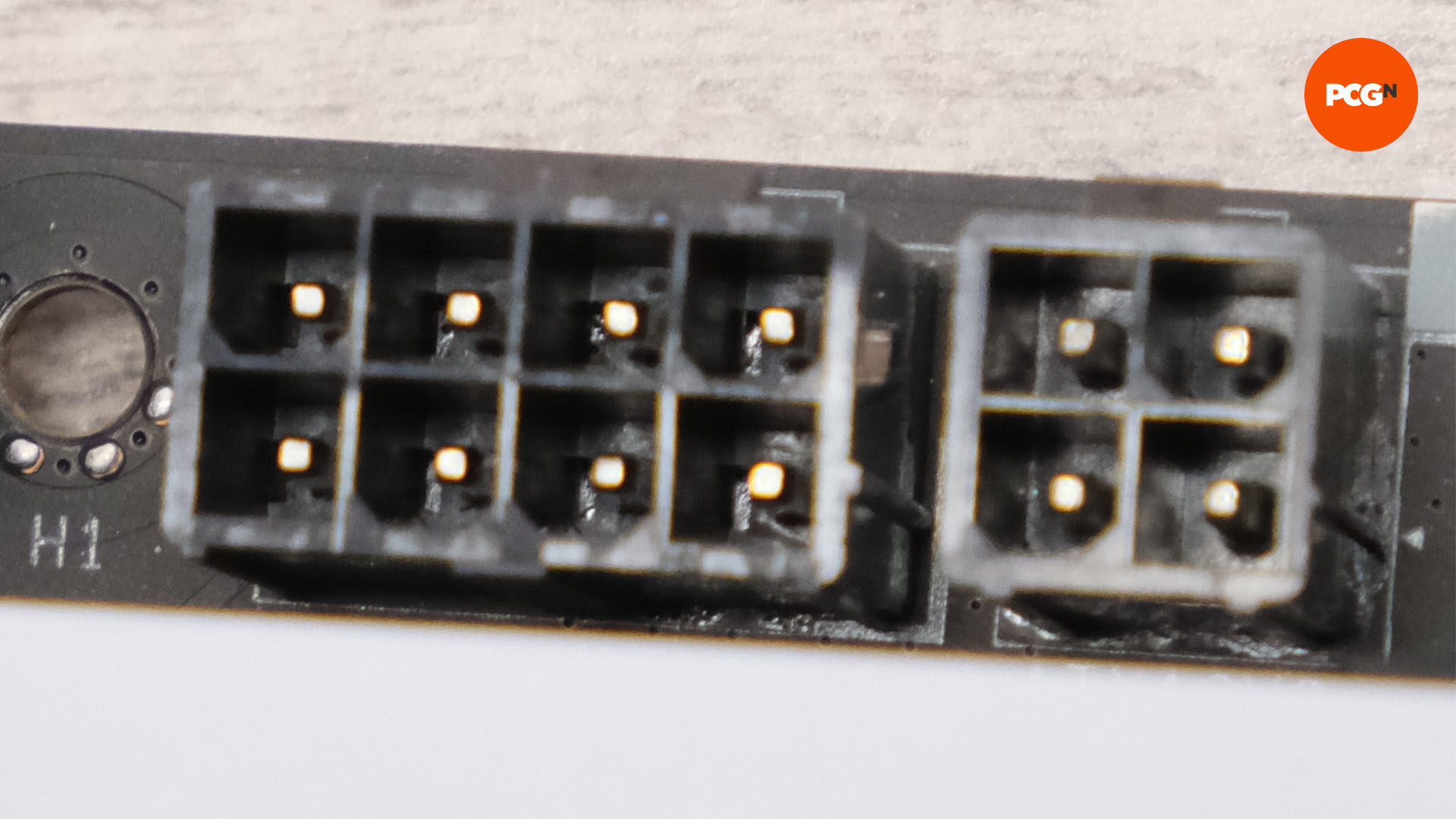
8-pin EPS 12V connector
This offers energy to your CPU. Low cost motherboards sometimes have simply 4 of the eight pins, requiring you to make use of simply one-half of the connector. Some high-end motherboards have greater than a single 8-pin connector too, however that is solely wanted when you’re an excessive overclocker constructing a really highly effective system.
Within the overwhelming majority of conditions, you simply want to attach the 8-pin connector out of your PSU to the corresponding socket in your motherboard, which is often positioned above the CPU socket.
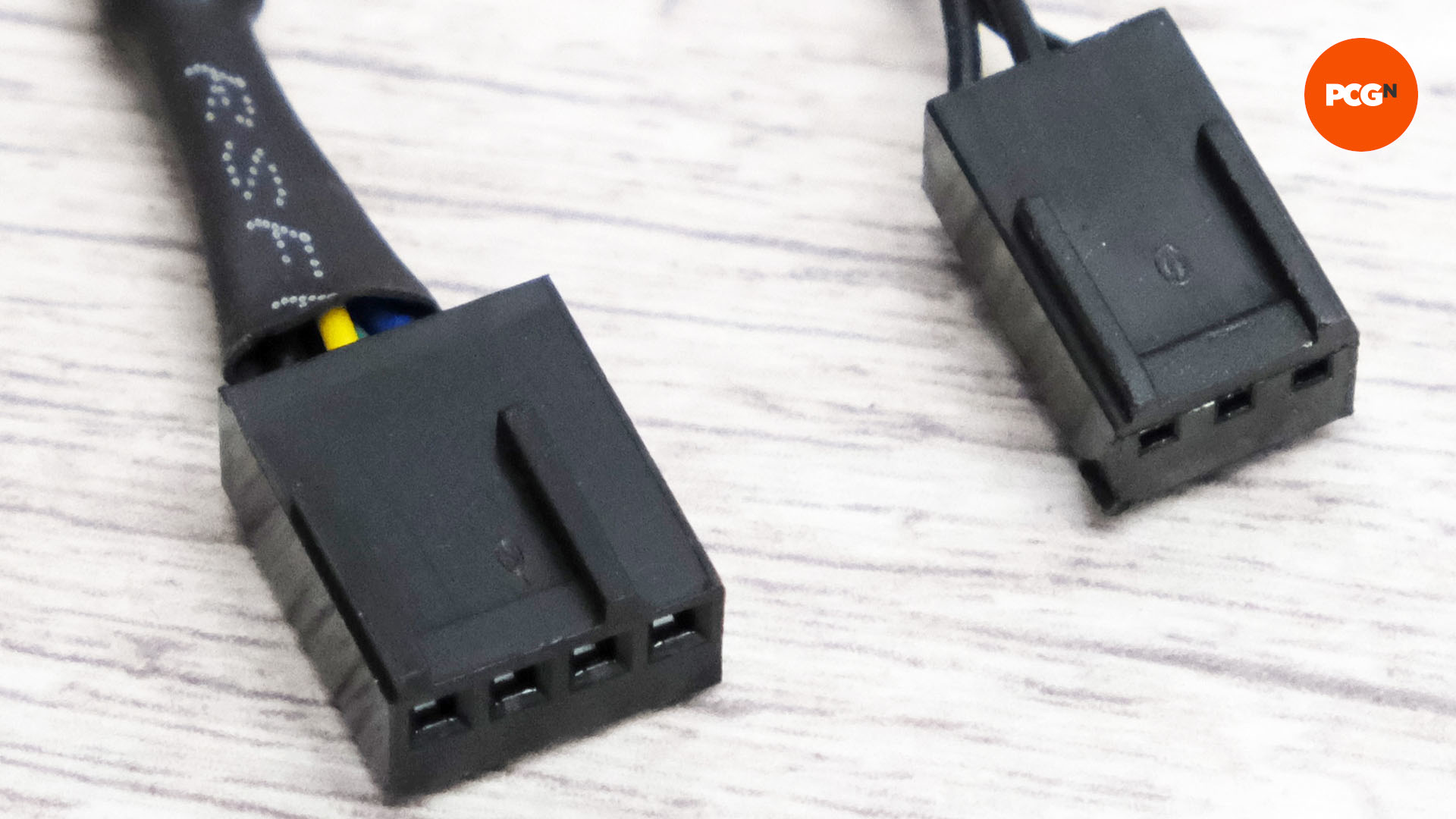
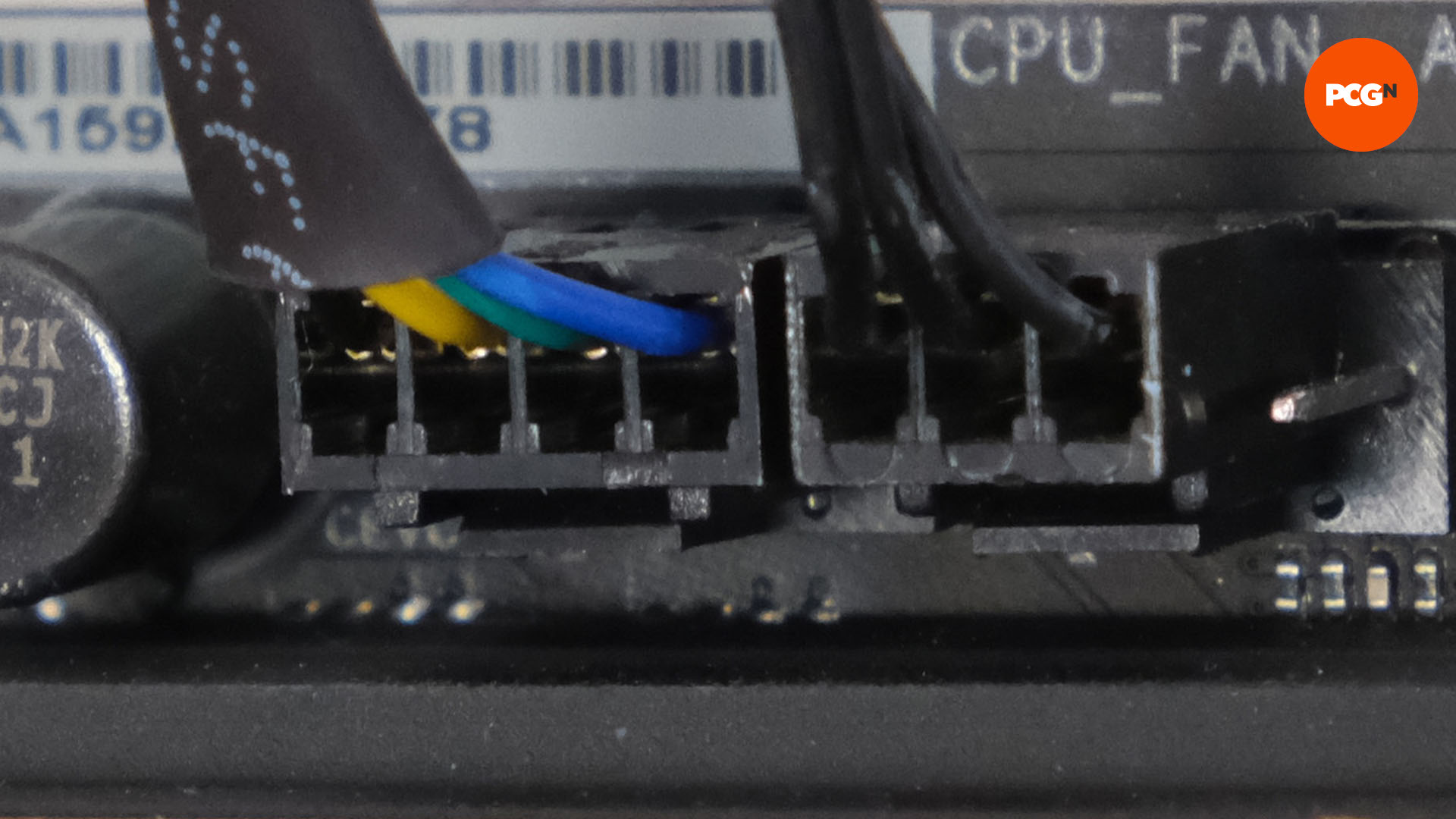
3-pin and 4-pin fan connectors
Your case’s followers (and radiator followers when you’re utilizing liquid cooling) will in all probability have considered one of these two energy connectors on the tip of their cables, however each of them connect with the identical kind of energy header in your motherboard – you too can plug a 3-pin plug right into a 4-pin header if essential.
The three-pin connector offers energy and that’s it. In the meantime, a 4-pin connector has a intelligent further pin that gives what’s often called a PWM or pulse width modulation sign to your motherboard. This could enable the motherboard to regulate the voltage, and therefore the pace, so you’ll be able to run it at decrease than default speeds, making it run barely quieter.
USB headers
Understanding USB isn’t straightforward today with so many speeds and ports out there, however you’ll must familiarise your self with three forms of headers in your PC, so you will get all of the USB ports in your case working correctly.
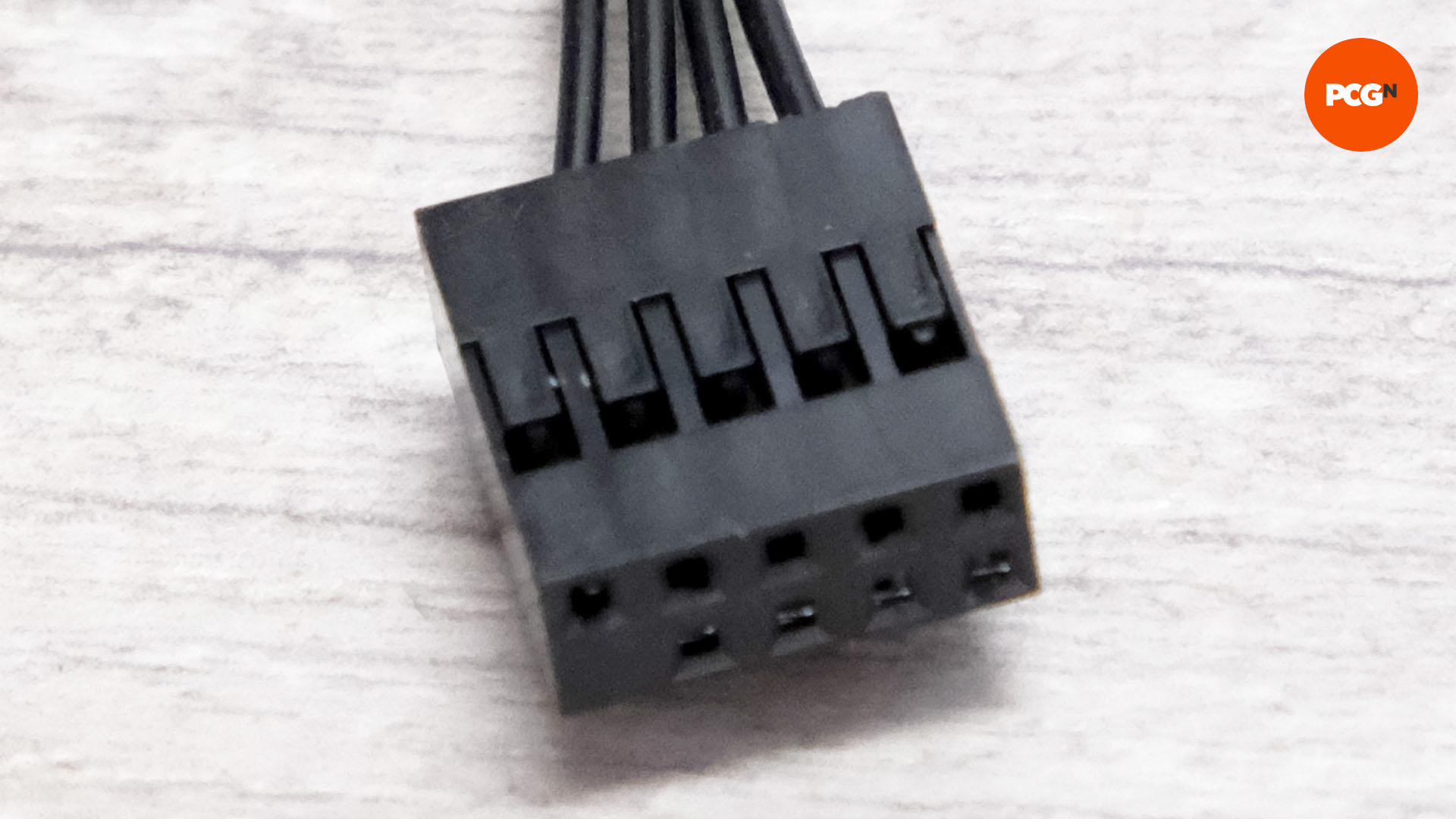
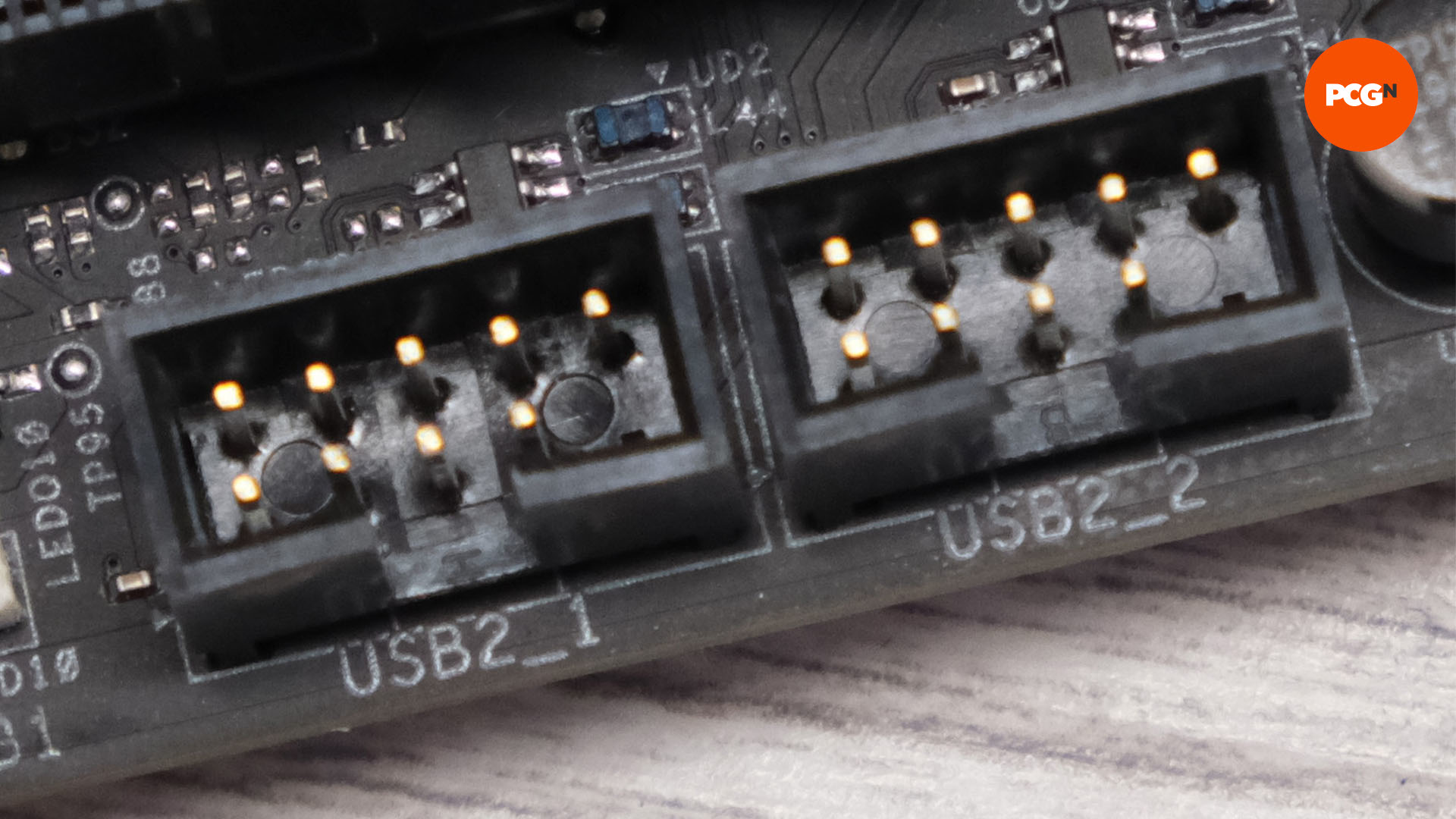
There are cables coming from these ports inside your case that have to be related to headers in your motherboard. The USB 2 header offers information and energy to your case’s USB 2 ports, and is pictured above.
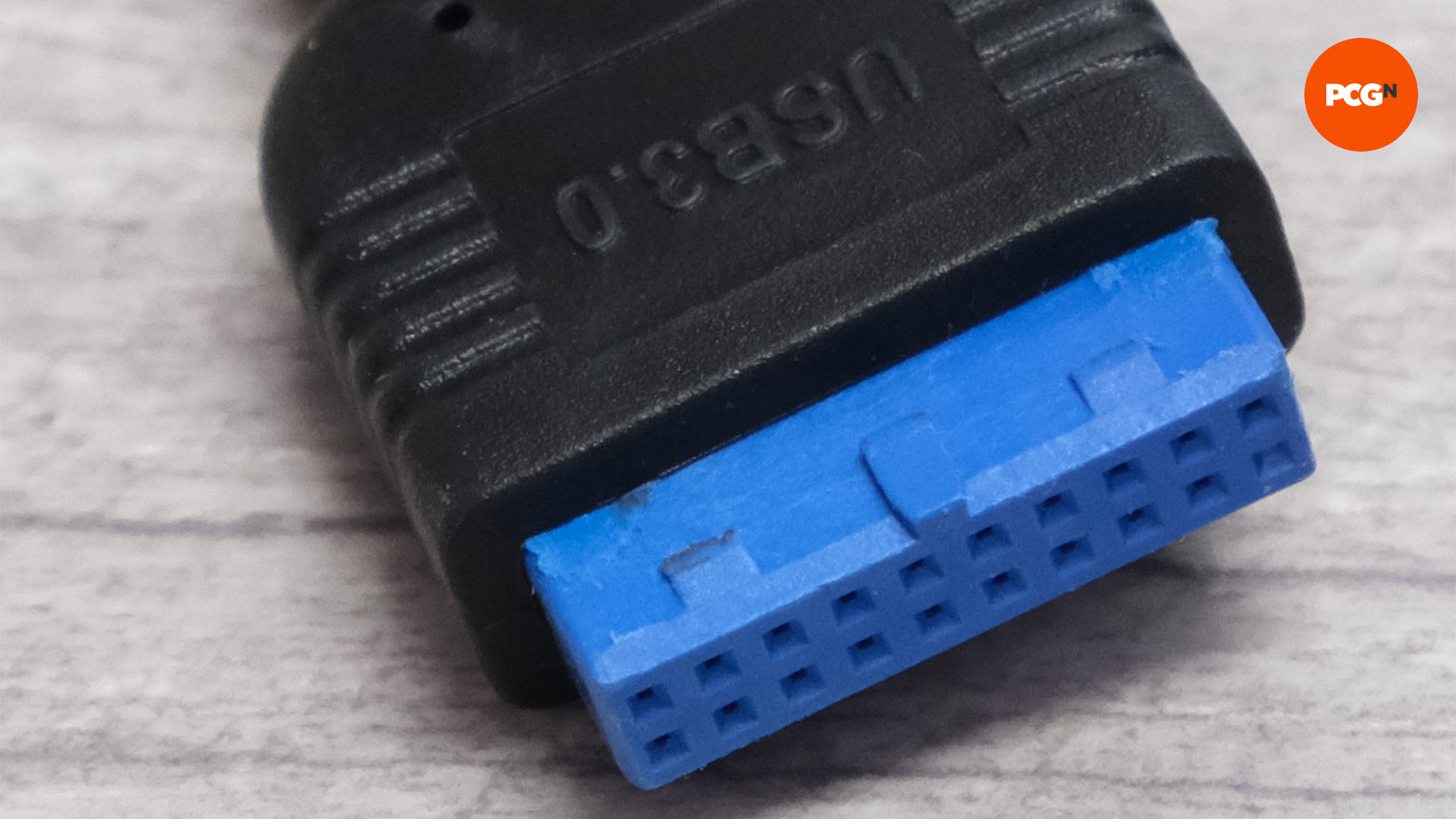
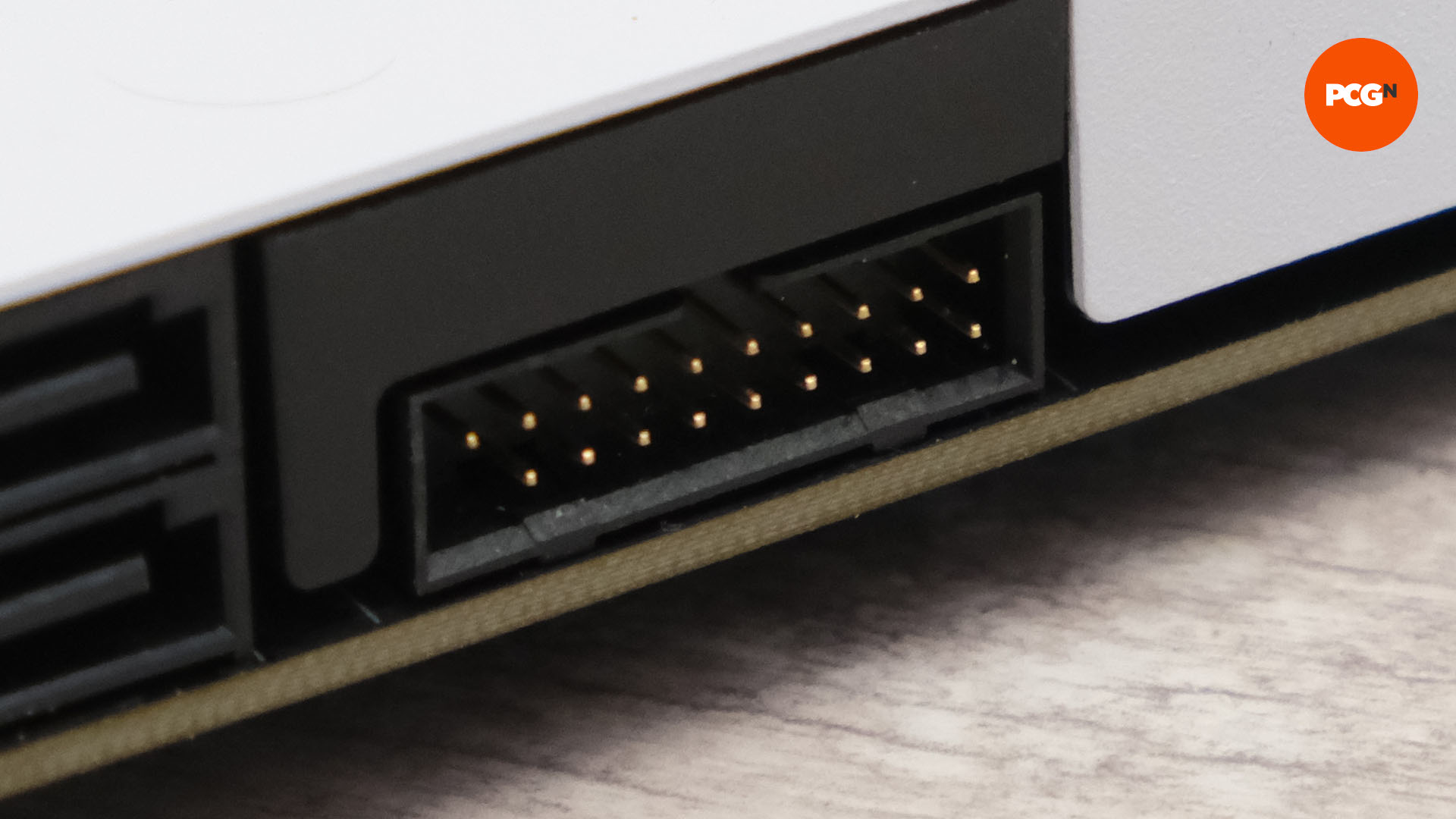
Subsequent there’s the USB 3 header, which is pictured within the two pictures above, and does the identical because the USB 2 connectors, however for quicker USB 3 ports.
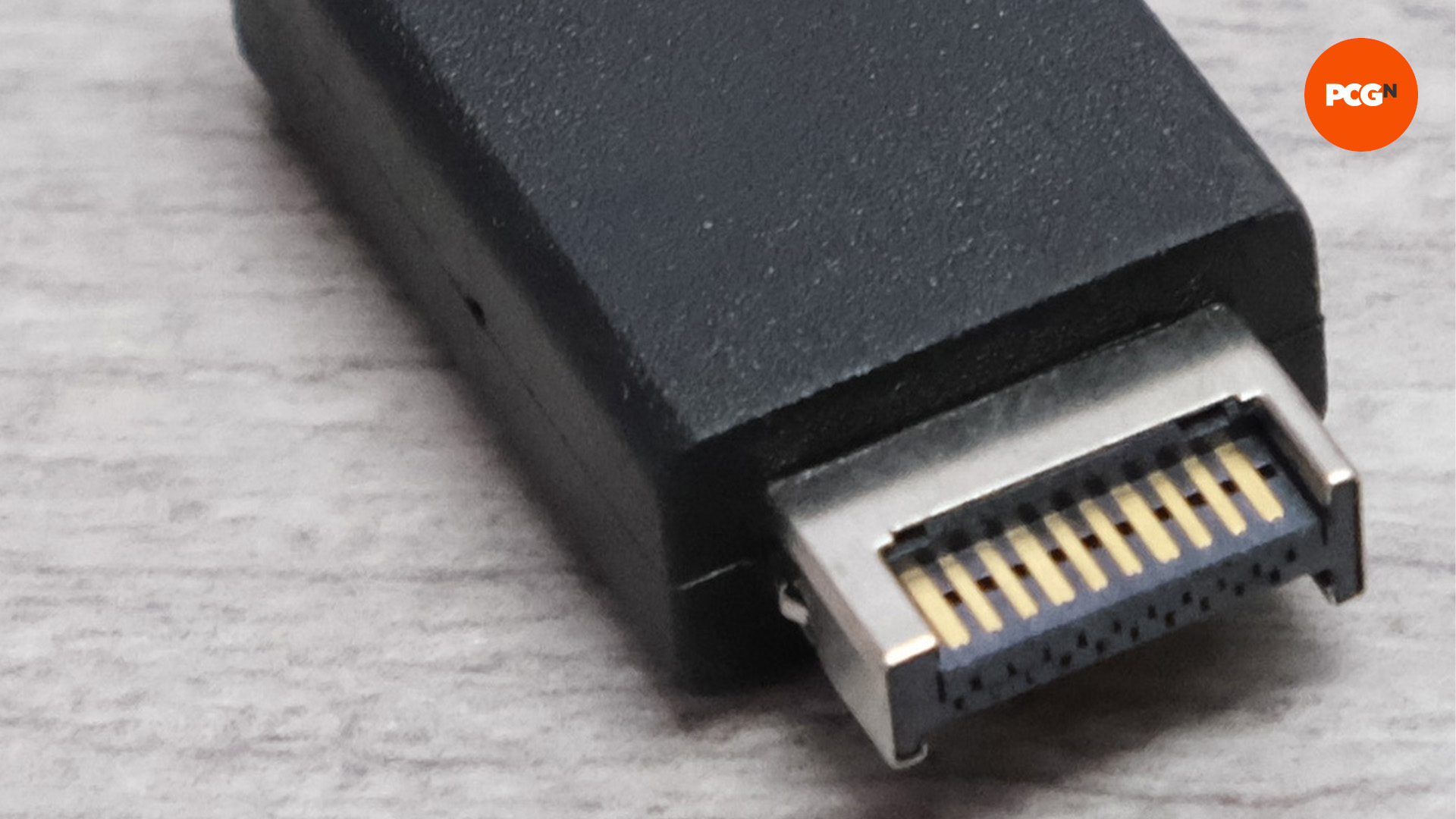
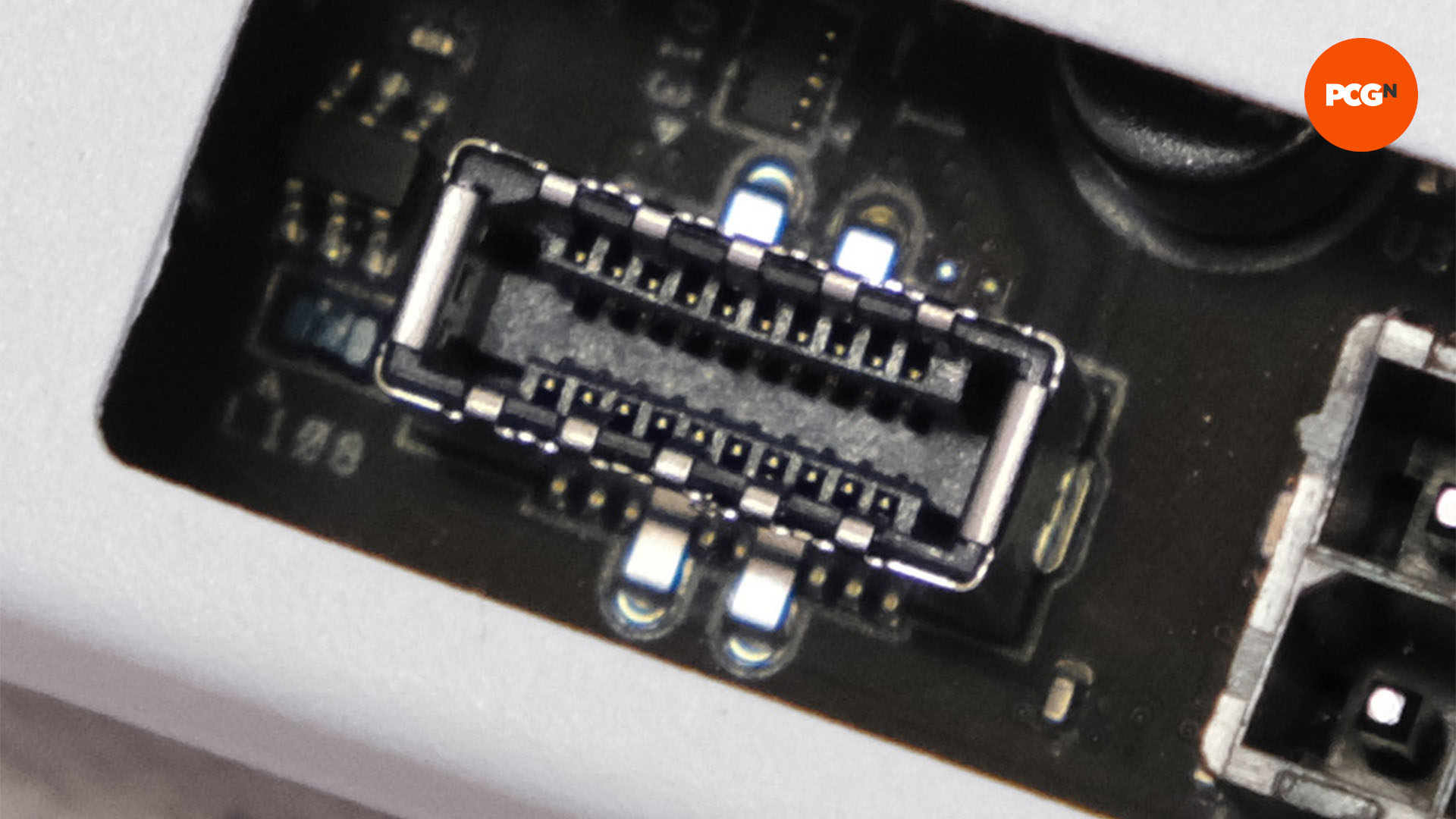
Lastly, there’s the newer, brief and blocky USB-C header, which is pictured above, As you could have guessed, this must be related to your case’s entrance panel USB-C port if it has one, though that is nonetheless a characteristic that you simply don’t all the time discover on each out there case.
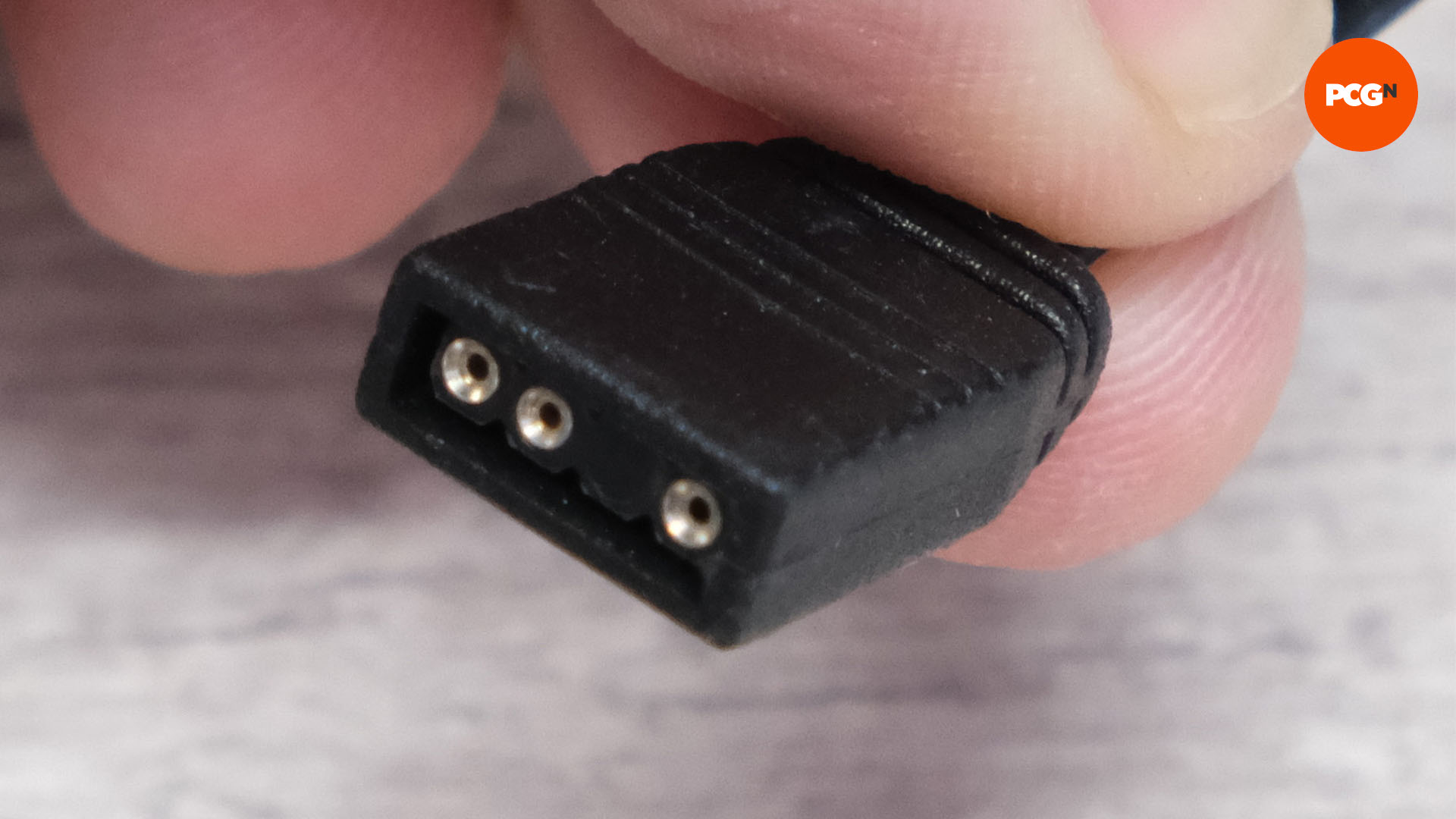
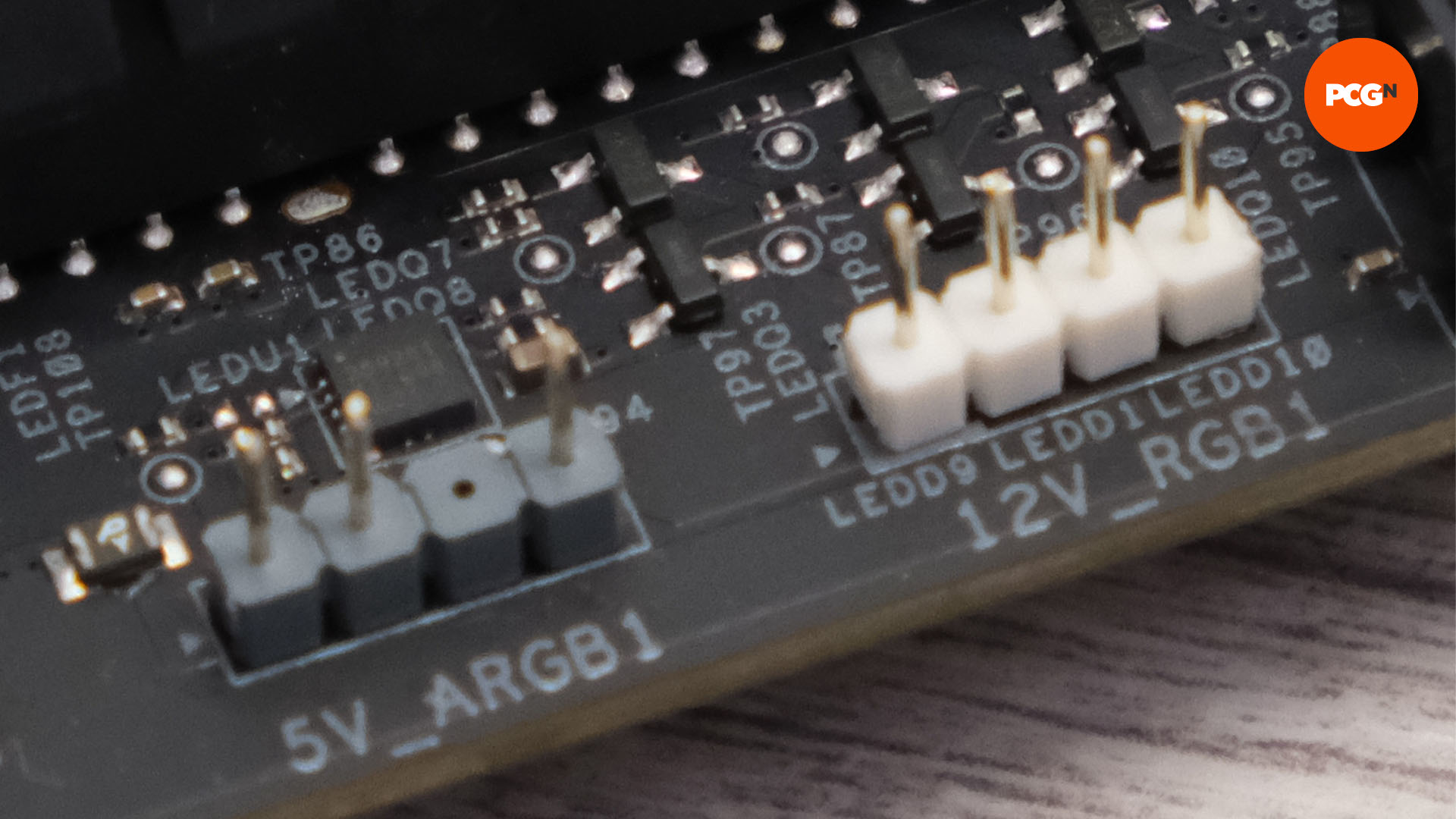
3-pin and 4-pin RGB connectors
There are two forms of customary RGB lighting connectors, and these are available 3-pin and 4-pin flavors. The latter assist you to management all of the LEDs in a strip or part on the similar time, maybe displaying the identical coloration or altering the brightness for all LEDs directly. The three-pin RGB connectors can do all that, but in addition provide you with management over particular person LEDs, offering larger scope for lighting results, or just having totally different colours displaying throughout an LED strip on the similar time.
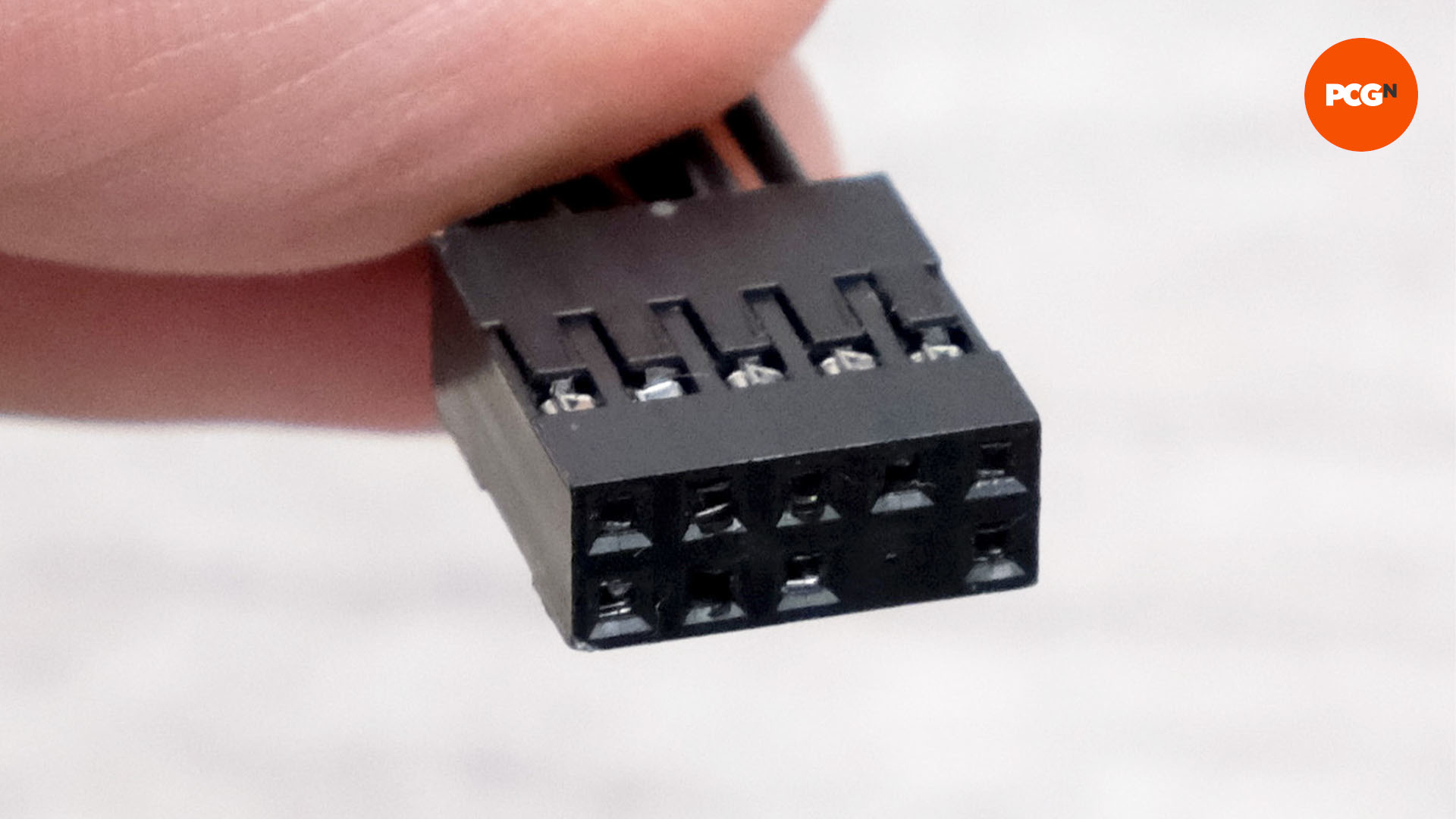
Audio header
In case your case’s entrance panel has analog jack sockets for mic and headphones, then it would even have an audio cable that hooks as much as the header in your motherboard and permits these jack sockets to work – it’s often within the backside left nook of your motherboard.
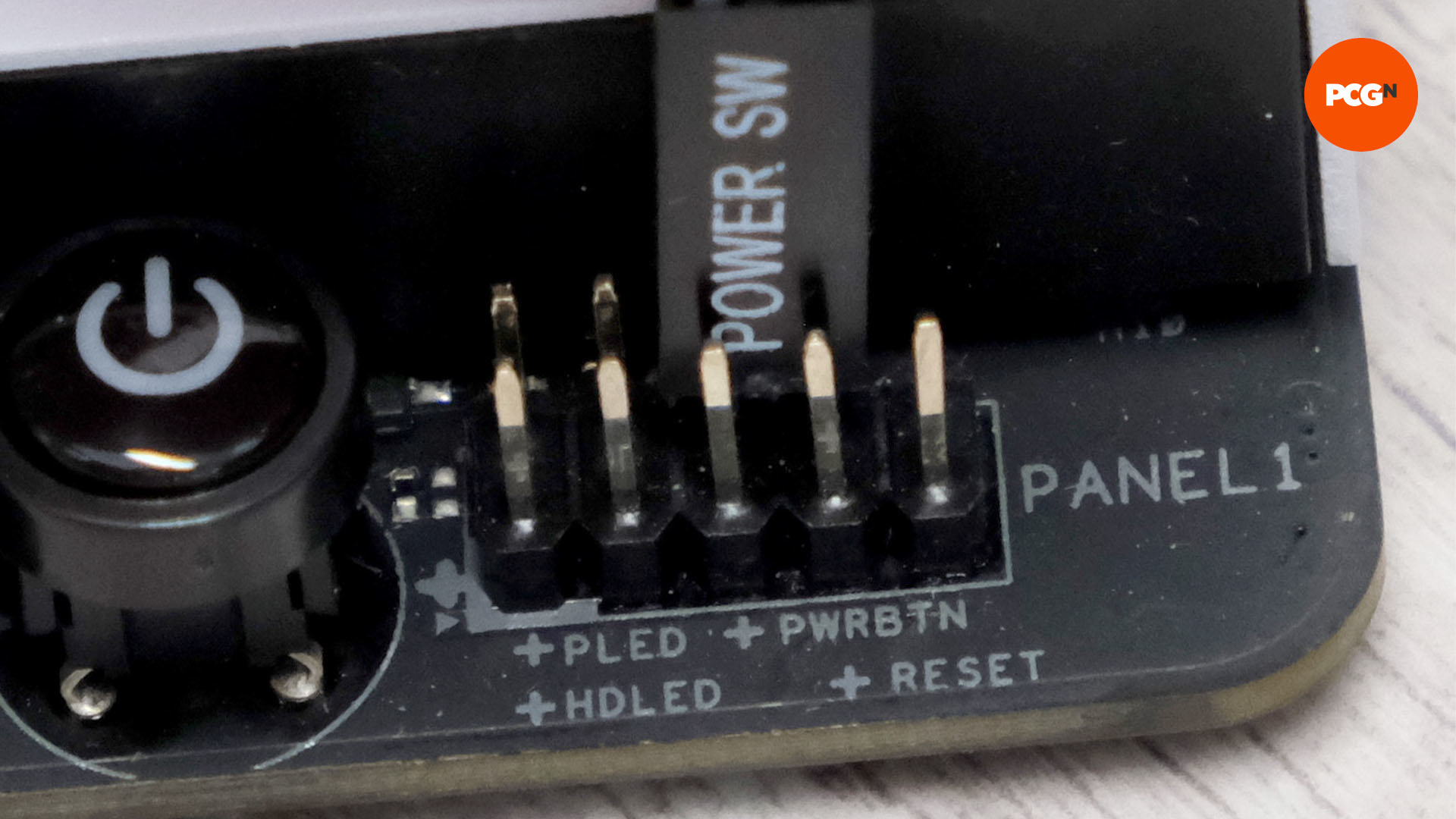
Entrance panel headers
Your case can have an influence button, and sometimes a reset button too, in addition to lights that present when it’s powered on, and generally for when the SSD or exhausting disk is being accessed. All these case options work by utilizing cables that connect with your motherboard in the identical means because the USB ports lined earlier, besides they’re a lot smaller.
You join them to your motherboard’s entrance panel header. You’ll must check with your motherboard handbook to establish the fitting pins and, be warned, this will usually be fiddly, particularly when you do it as soon as your motherboard is already screwed into your case. We’ll take a look at the most effective methods to cope with this a part of the set up afterward.
3. Select suitable parts
It goes with out saying that you must make sure you’ve chosen the right {hardware} so as to keep away from any compatibility points along with your newly constructed PC. You’ll must be sure to’re conscious of the assorted motherboard sizes out there, that you simply choose the fitting motherboard to your case or vice versa and that your chosen CPU cooler is suitable along with your motherboard.
It’s additionally value checking case clearances. Circumstances have limits for the size and peak of CPU coolers and graphics playing cards. A typical ATX case doesn’t often have any points, however sometimes a very giant CPU cooler won’t match right into a smaller-than-average case.
You’ll additionally want to make sure your CPU is suitable along with your motherboard. The best means to do that is to go to your motherboard producer’s web site and even an etailer web site, and use the menus to pick out merchandise that solely use a selected chipset or CPU socket. The web site PCPartPicker can be a useful gizmo for choosing suitable parts.
4. Set up your CPU
We’ll begin with a warning, which is that the pins in Intel and AMD’s CPU sockets and on the backs of AMD’s Socket AM4 CPUs are extraordinarily fragile. The socket pins are significantly damage-prone and the slightest knock can kill your motherboard. Be extraordinarily cautious while you set up the CPU into the socket because it’s by far probably the most hazardous step while you’re constructing a PC.
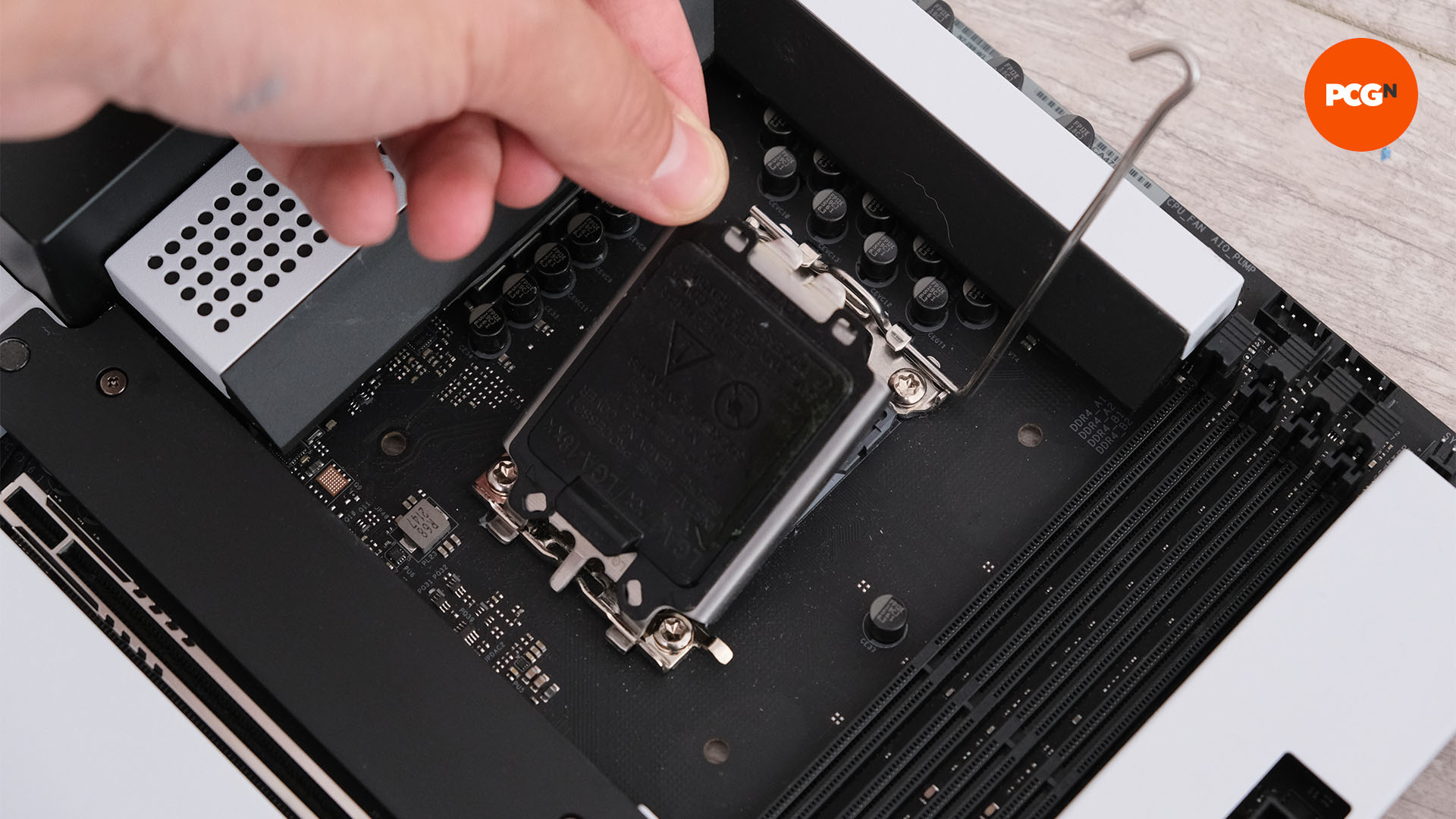
With Intel LGA1700 and AMD Socket AM5 CPUs, depart the black socket cap in place. It’s going to come out itself while you set up the CPU. It’s designed to guard the socket pins till you truly set up the CPU. Begin by prising out the CPU socket latch to the fitting and lifting it as much as open the socket.
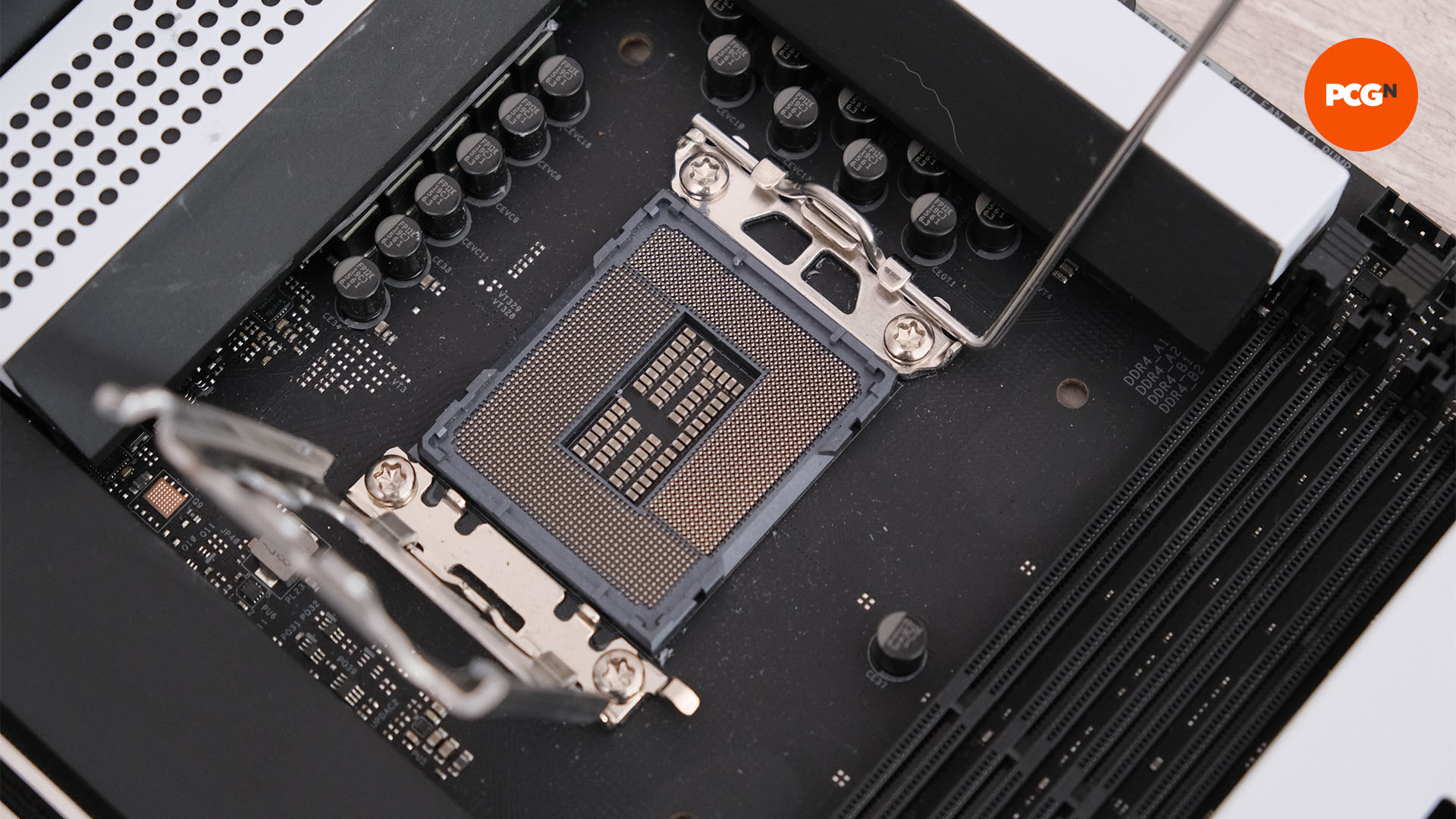
Subsequent, decrease the CPU down subsequent to the socket, so there’s no probability of you dropping it into the socket and damaging the pins. There are notches on the facet of the CPU that will help you orient it appropriately. You’ll be able to then convey it throughout to sit down within the socket.
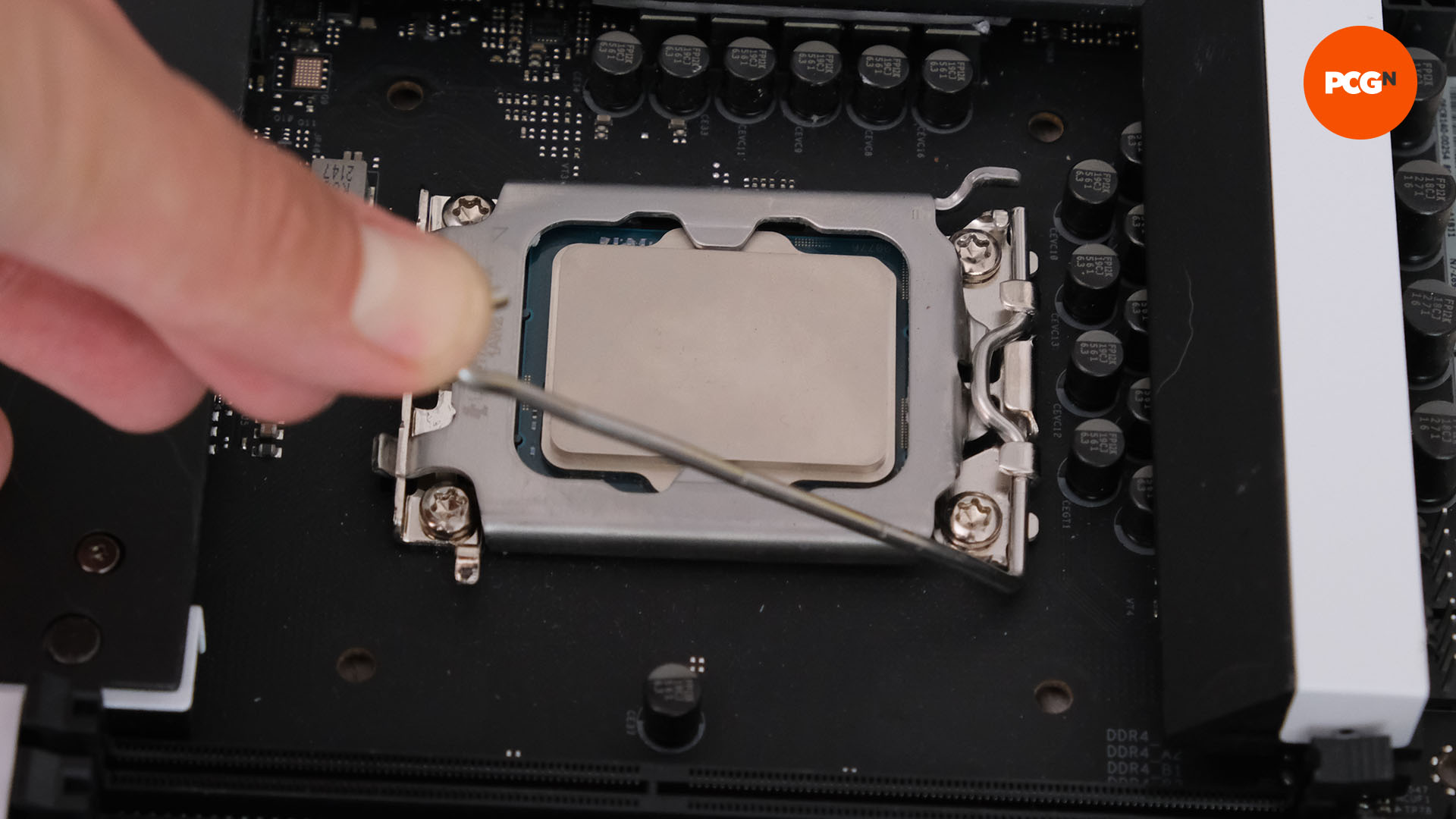
As soon as the CPU is in place, convey the CPU socket cowl down over the CPU after which bend the latch down, securing it in place.
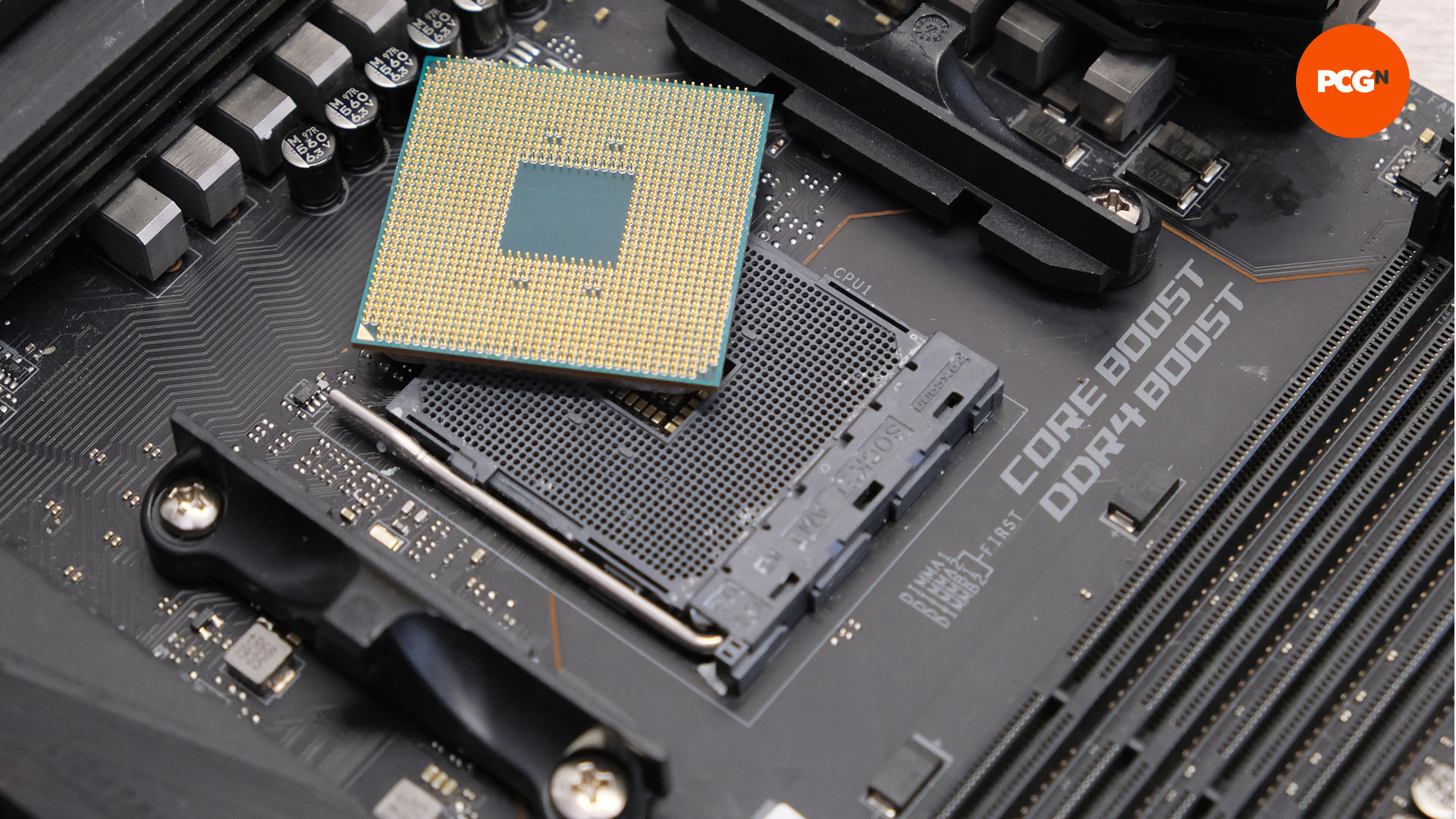
With AMD’s Socket AM4 platforms, the pins are on the CPU. Like Intel’s CPUs, they match into the socket in a specific orientation, which might be discovered by aligning arrows on the socket and fringe of the CPU. The pins sit in holes within the socket, however you must open the holes first by opening the latch on the facet of the socket.
Decrease the CPU into the socket. It ought to slot freely down into place. Sometimes it could require a small push to make sure its underside sits flush with the socket all the way in which round.
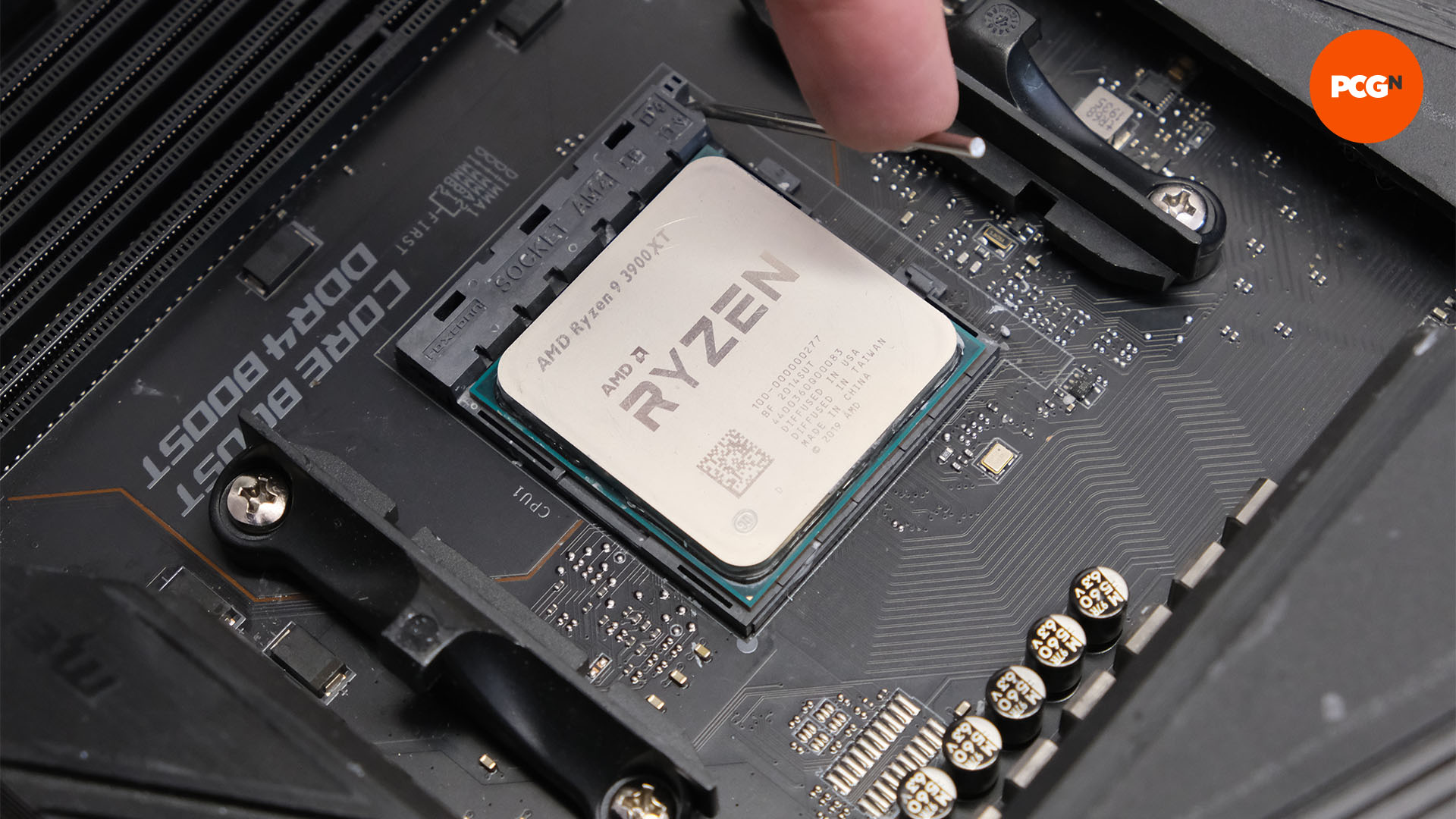
As soon as it’s sat flat within the socket, decrease the latch, which is able to lock the CPU in place. In the event you ever must take away your CPU cooler, twist it first. It will loosen the thermal paste, which might in any other case persist with the CPU and truly pull AM4 CPUs out of their sockets.
5. Set up your reminiscence
Reminiscence modules can solely be fitted into your motherboard’s DDR4 or DDR5 DIMM slots a method round, and it’s straightforward to establish because the modules have notches that match up with pins within the slots.
Most motherboards have 4 slots, however your reminiscence equipment will in all probability solely have two reminiscence modules. You’ll want to place your modules into particular slots, although, as your motherboard has the power to entry information on each modules directly utilizing a characteristic known as dual-channel mode. This could dramatically enhance efficiency and is one cause why utilizing only one giant reminiscence module is a foul thought.
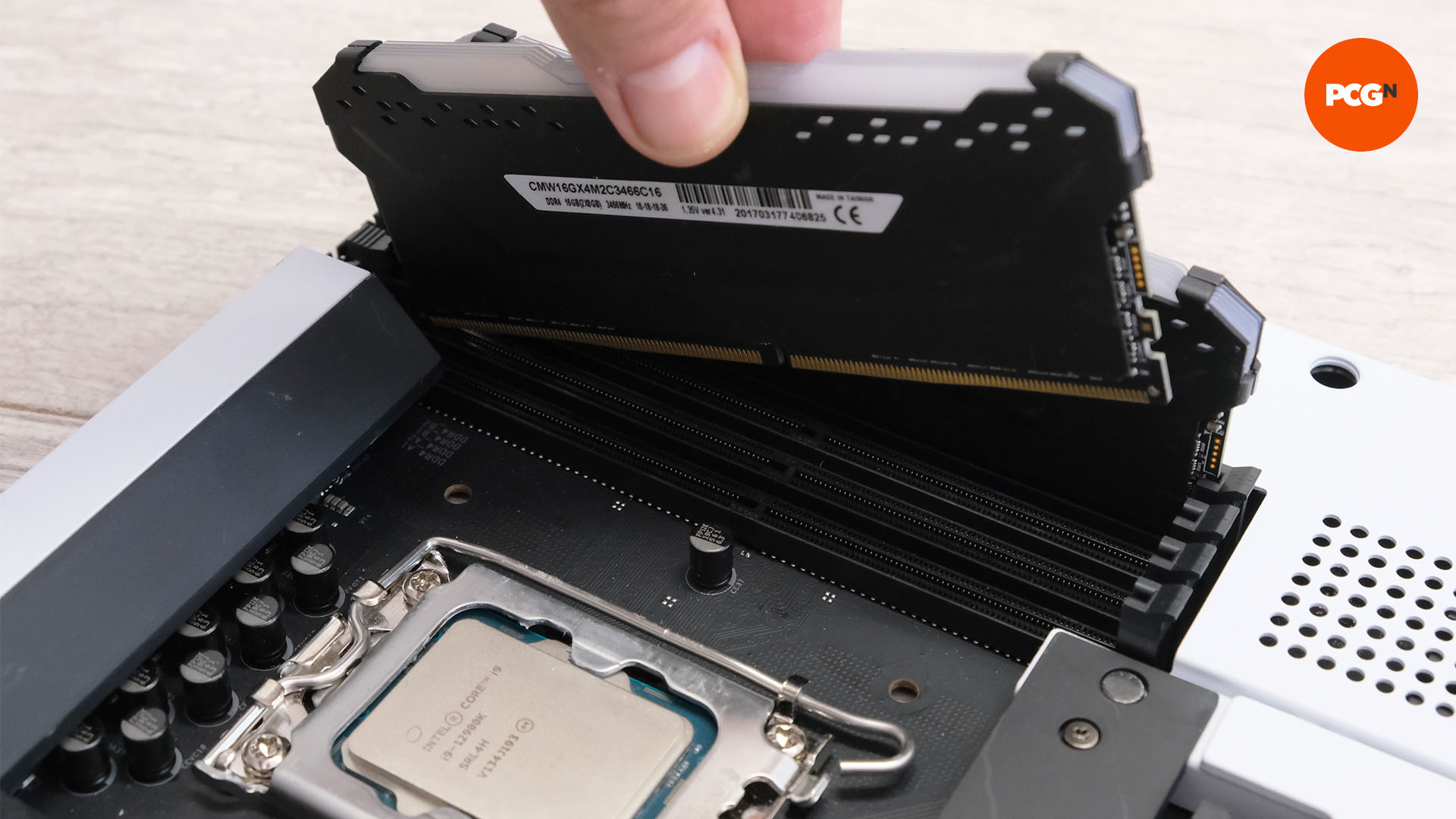
To make sure dual-channel mode is activated, place your pair of modules into slots two and 4, or the second and fourth furthest away from the CPU socket. To really set up the modules, insert one fringe of the module into the slot first, lifting any latches on the ends of the slots first in the event that they’re current.
You’ll want to press fairly firmly on the center of the module to get it to clip into the socket and also you’ll hear it click on into place. Any latches on the ends of the CPU socket will lock into the module. Guarantee each modules are seated correctly – they have to be degree and sitting on the similar peak.
6. Apply thermal paste
Thermal paste is commonly pre-applied to CPU coolers, however there are nonetheless loads of conditions the place you must apply it your self. If so along with your chosen CPU cooler, that is the way you do it. Purpose to attract a skinny cross form from nook to nook on the CPU’s metallic heatspreader.
Each AMD and Intel’s present CPUs have heatspreaders which might be giant sufficient to want an affordable quantity of paste, so simply making use of a small blob in the midst of the heatspreader gained’t assure that the paste will unfold over the entire floor. We additionally suggest utilizing a thermal paste guard when you’re utilizing a brand new AMD Socket AM5 CPU, so that you don’t find yourself with thermal paste leaking into the crevices on the heatspreader.
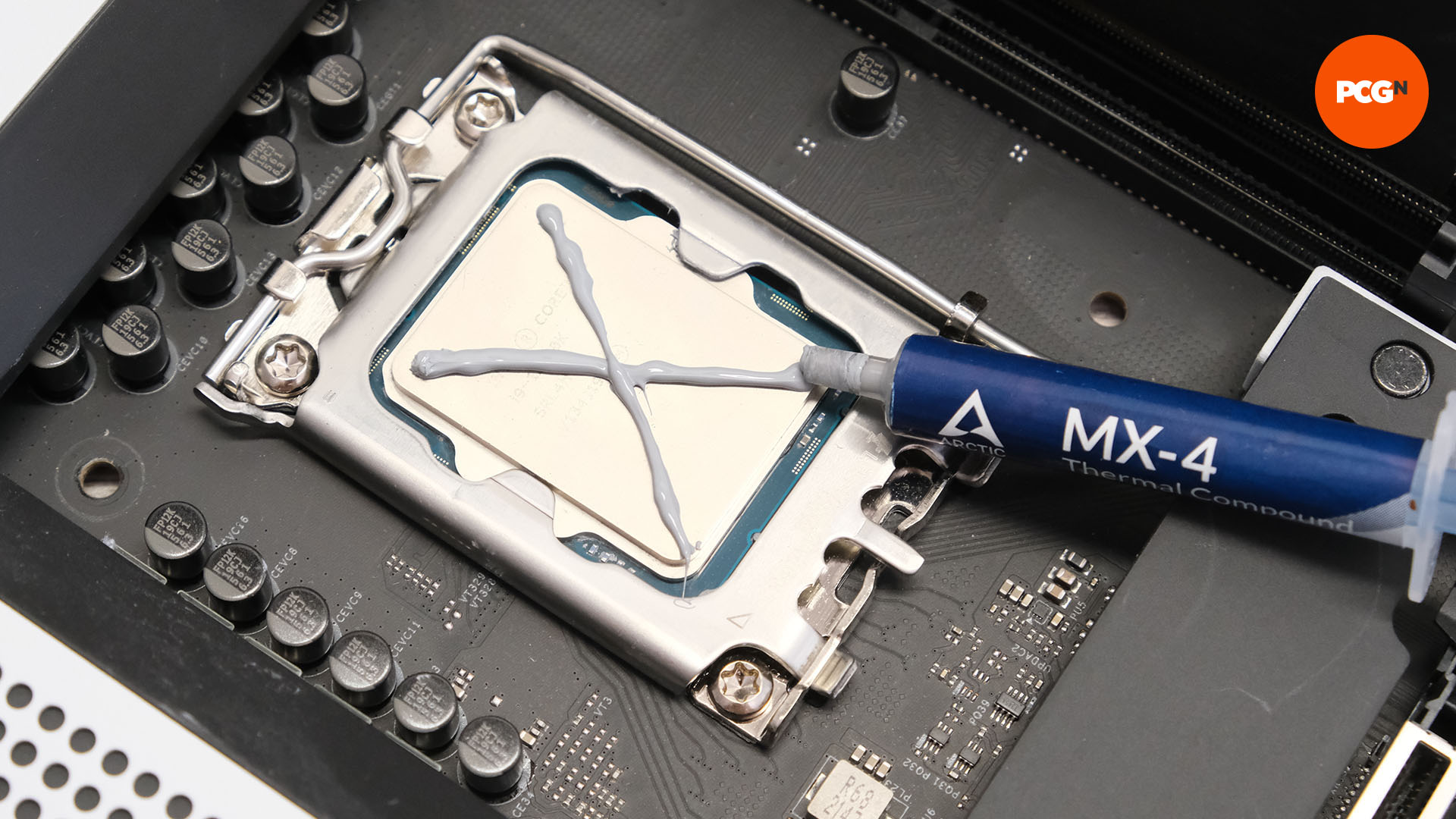
Any areas that don’t have paste utilized gained’t switch warmth as shortly from the heatspreader to the cooler’s contact plate and will hinder cooling. Use skinny strains across the width of a dry stick of spaghetti. For older, smaller Intel CPUs, a single line from prime to backside in the midst of the heatspreader is sufficient.
For extra details about which thermal pastes to make use of, and the way to apply them, learn our full information on the way to apply thermal paste.
7. Match a CPU air cooler
There are two forms of CPU cooler you’ll sometimes need to use in your first PC. The primary is an air cooler comprising a heatsink and fan, and we’ll take a look at the way to set up one now. With Intel motherboards, there are merely 4 mounting holes across the CPU socket that allow coolers to safe to the motherboard and clamp down onto the CPU heatspreader.
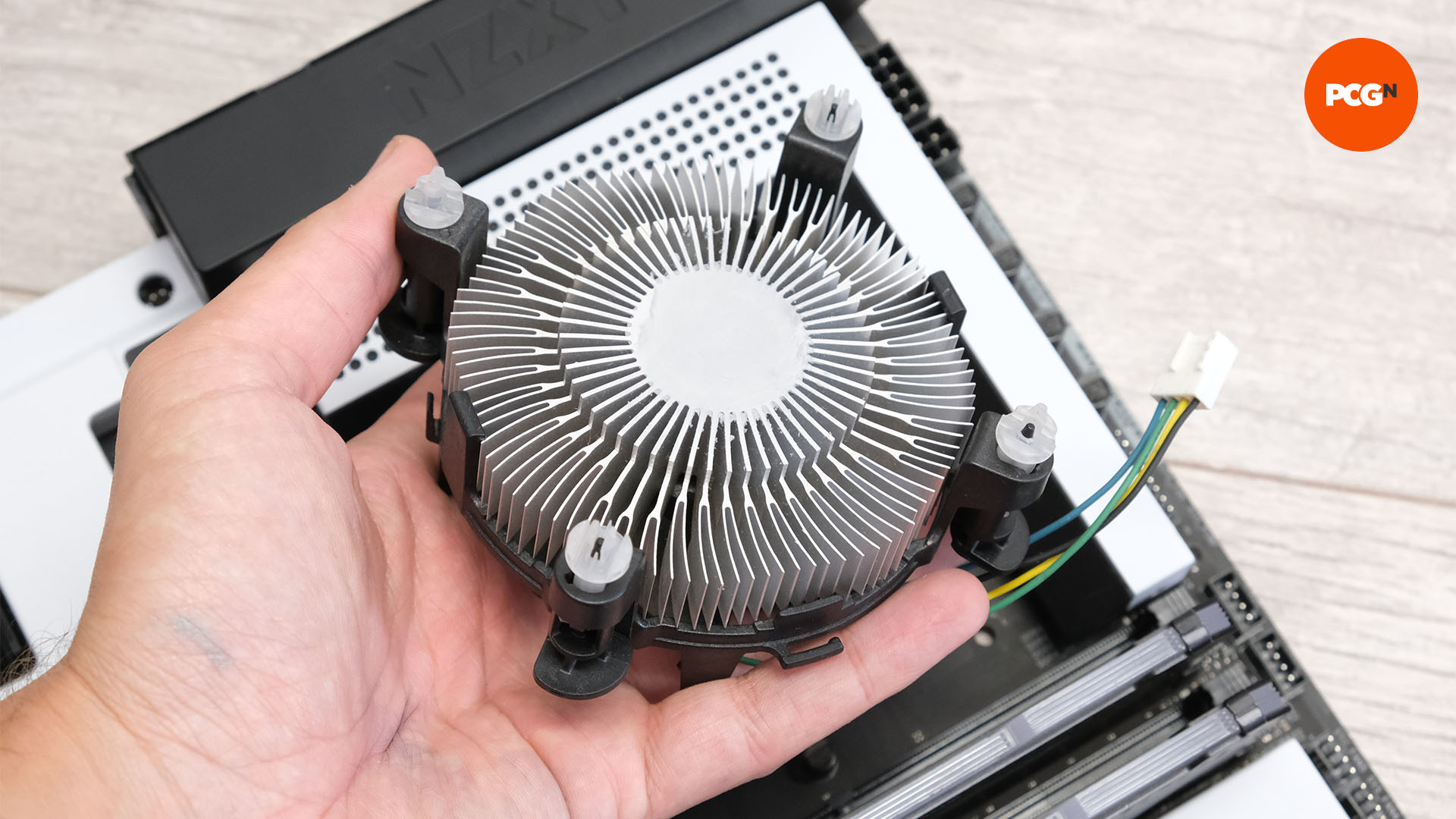
Some Intel coolers use push pins, the place you push the often white exterior plastic components of the pins into the holes across the CPU socket, then push down the often black interior components of the pins and switch them to safe them. Nevertheless, air coolers that retail for greater than $20 often have extra elaborate mounting kits that use backplates and thumbscrews.
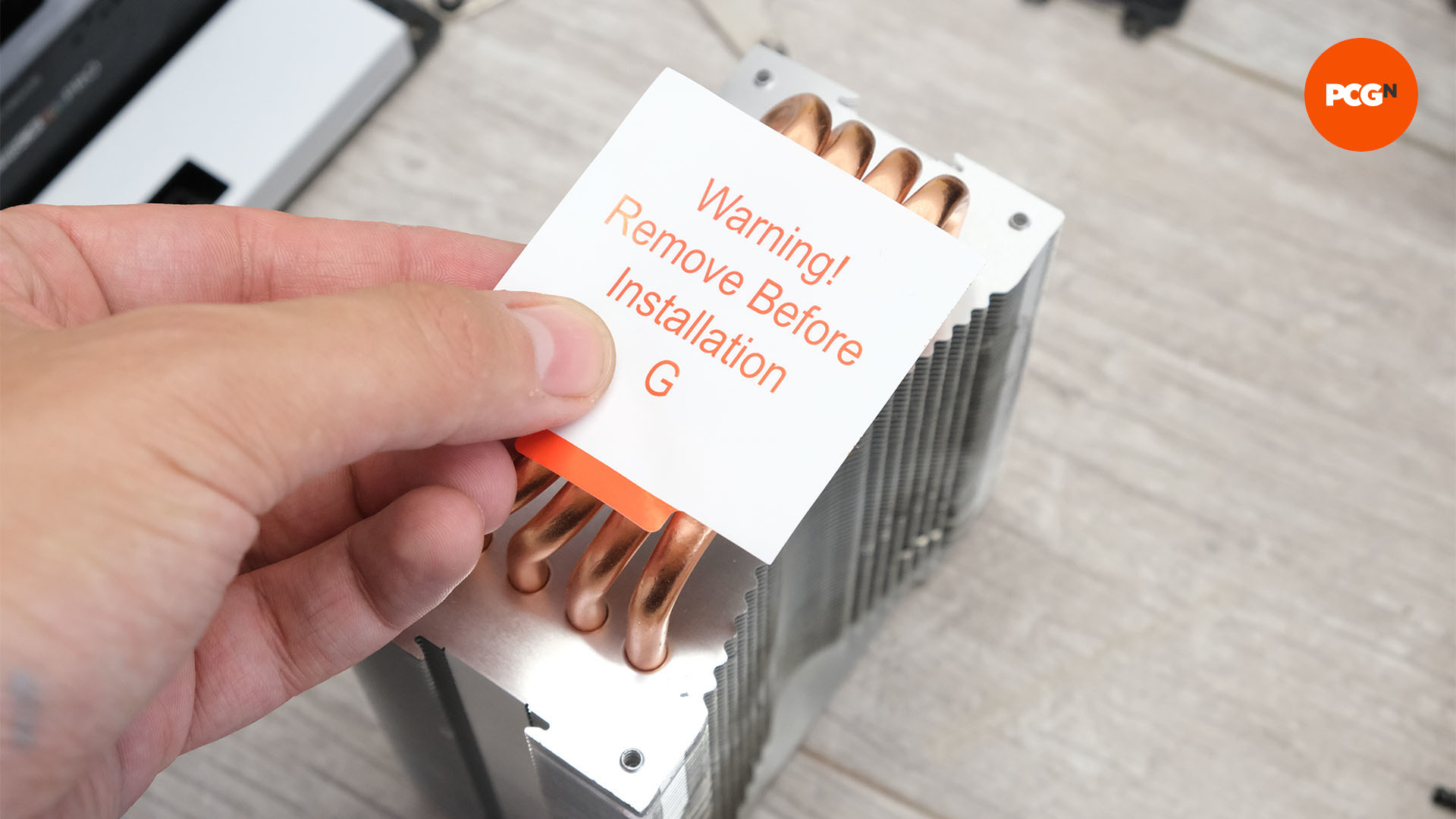
Begin by eradicating the plastic movie on the bottom of the cooler. That is there to guard the polished floor because it’s in any other case straightforward to scratch, and it may well additionally tarnish when it’s uncovered to air, each of which might cut back thermal switch. It’s straightforward to overlook the movie is there, although, solely to see your CPU temperature skyrocket while you by accident depart it on the cooler. We’ve all accomplished it.
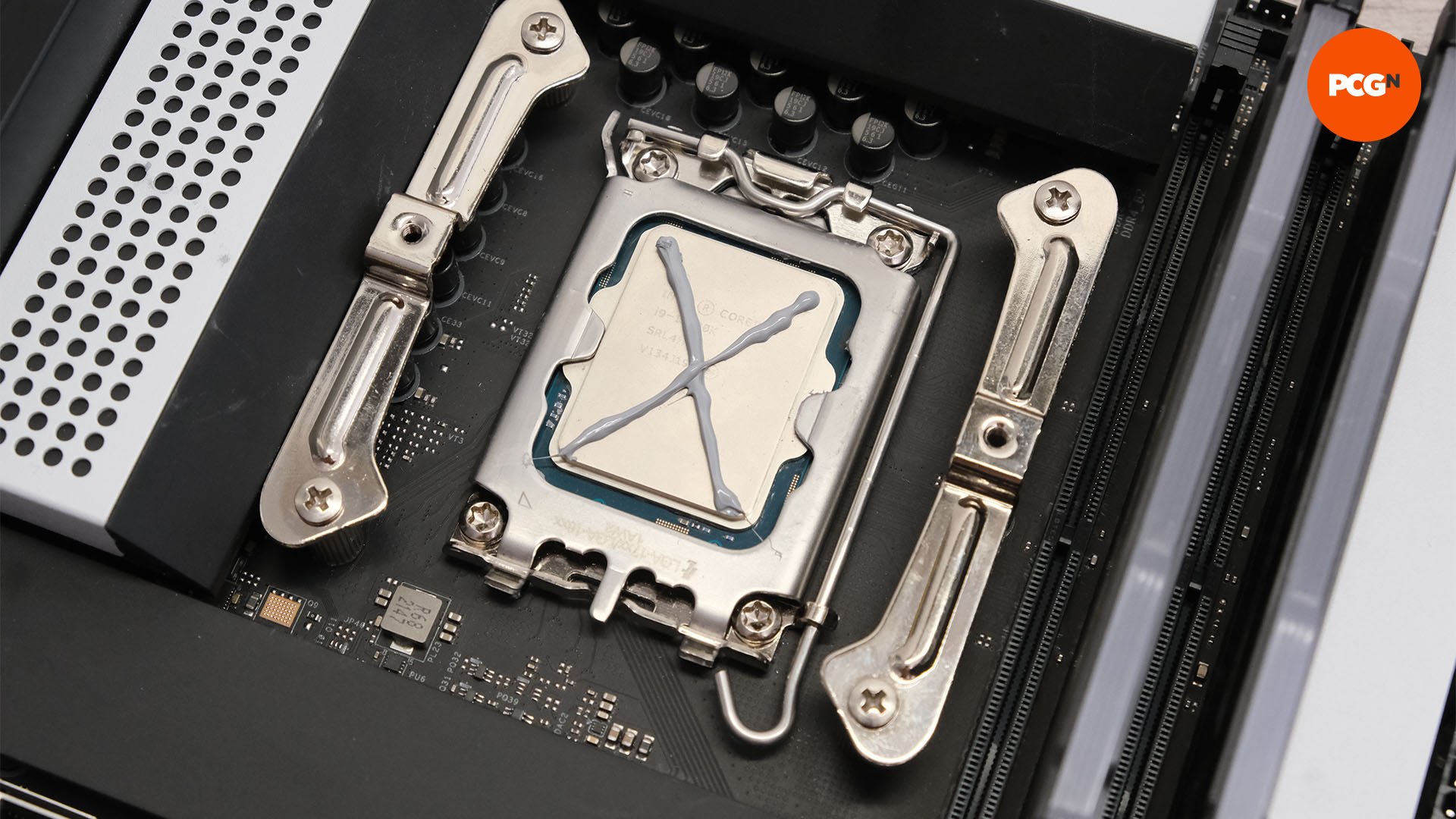
Subsequent, set up any mounting gear to your CPU cooler onto the CPU socket. We are able to’t cowl each variation right here, however your cooler will include directions displaying you the way to match it to a wide range of CPU sockets. You’ll in all probability want to suit a backplate to your motherboard to mount your CPU cooler for an Intel CPU, after which screw the cooler’s mount into the backplate.
Coolers for Intel CPUs will often require a selected set of mounts to your socket, and you might want to purchase a separate adaptor for Intel’s LGA1700 CPUs. All the time take care along with your screwdriver relating to mounting your cooler, as one slip may find yourself scraping a hint on the motherboard and render it ineffective.
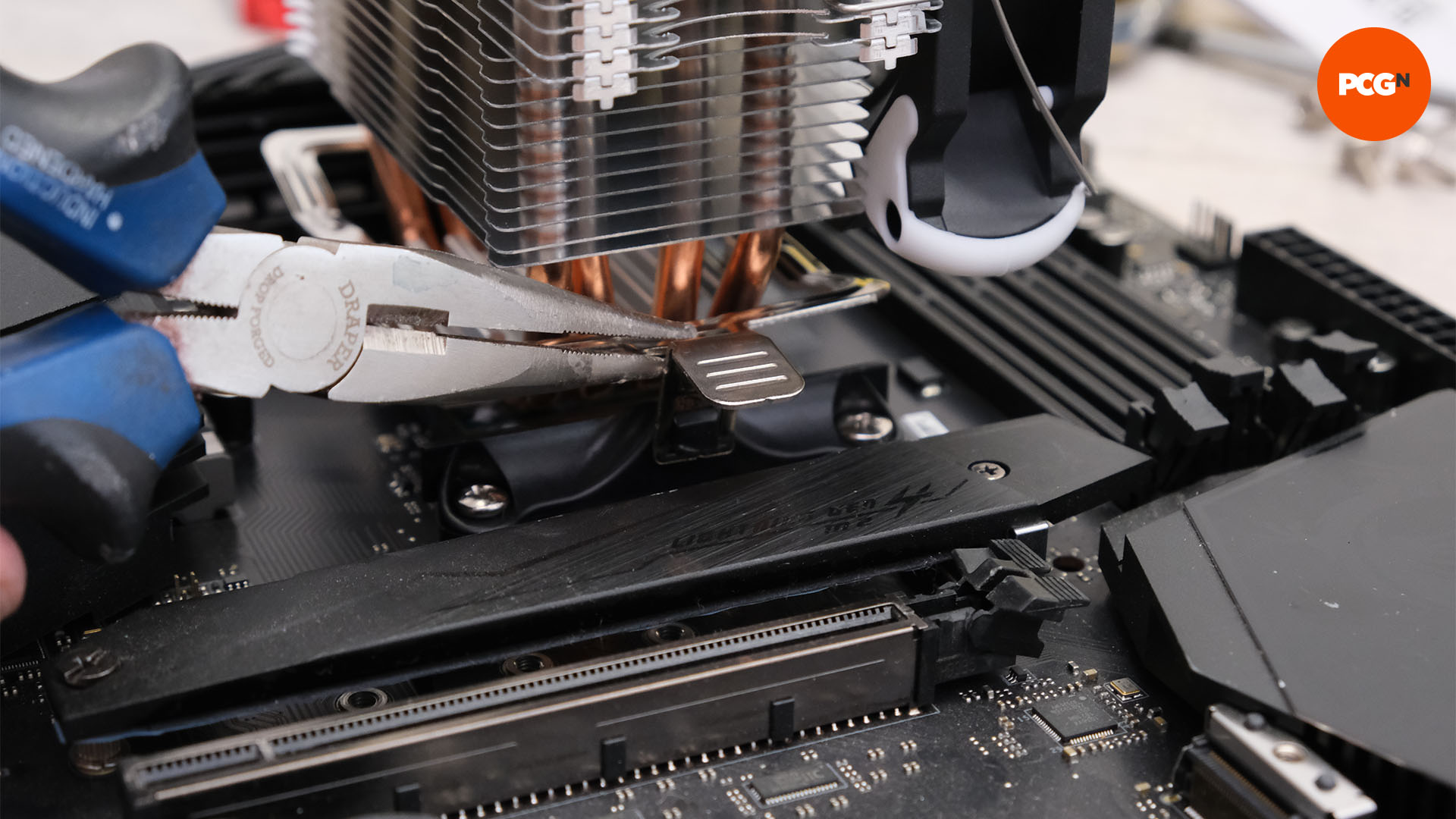
AMD coolers use considered one of two routes for securing the cooler to the motherboard. Some make use of the usual socket brackets with which AMD motherboards are outfitted, whereas others require the removing of those brackets and have their very own mounting mechanisms that you simply’ll want to put in.
Utilizing the mounting clips on AMD’s AM4 sockets could be very straightforward, because the cooler has its personal clips that hook onto them, though you would possibly want a pair of needle nostril pliers to press them into place.
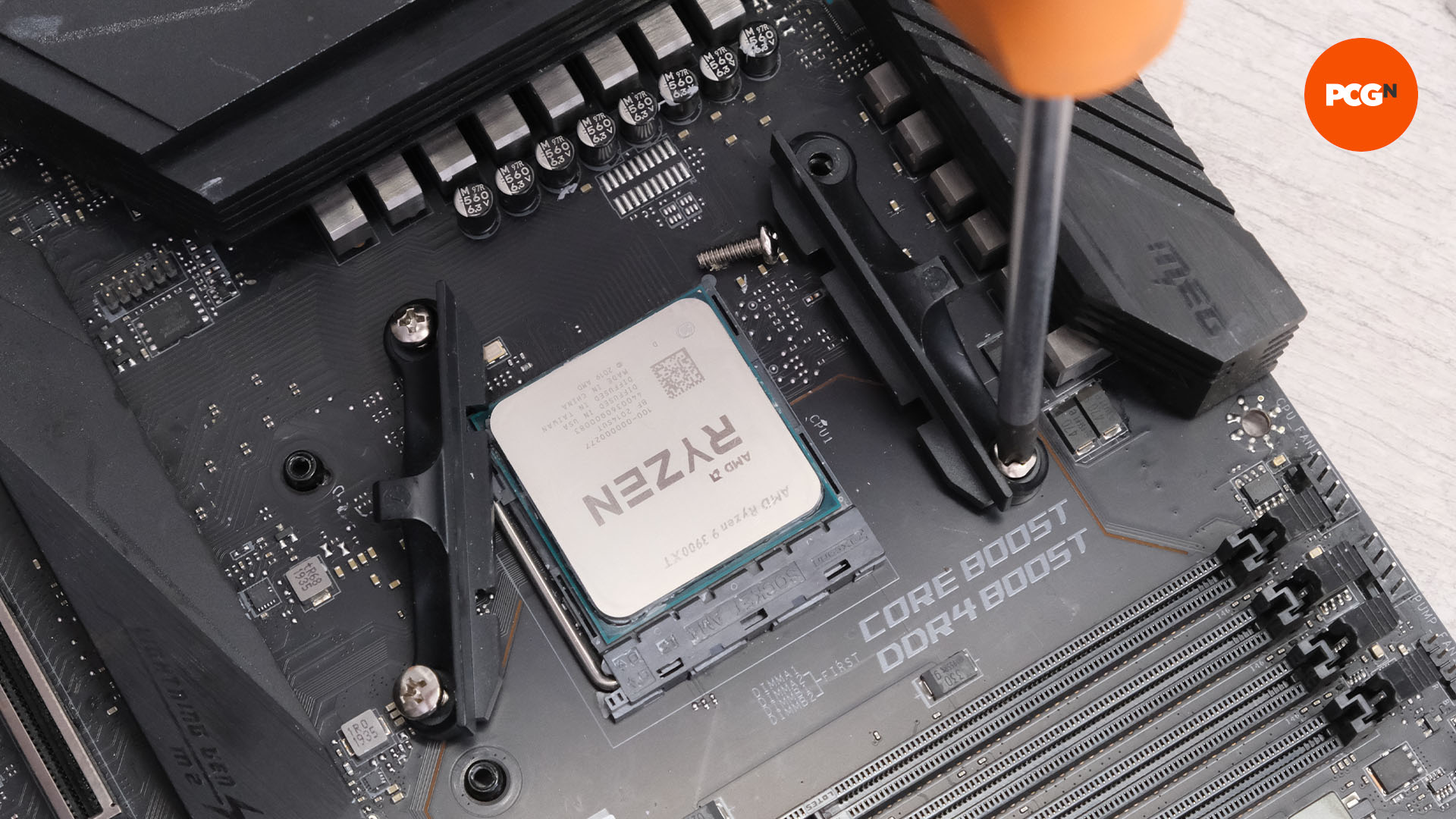
Eradicating the clips from AMD motherboards is straightforward as properly. There are two screws in every clip that have to be eliminated, permitting you to raise the clips off the motherboard.
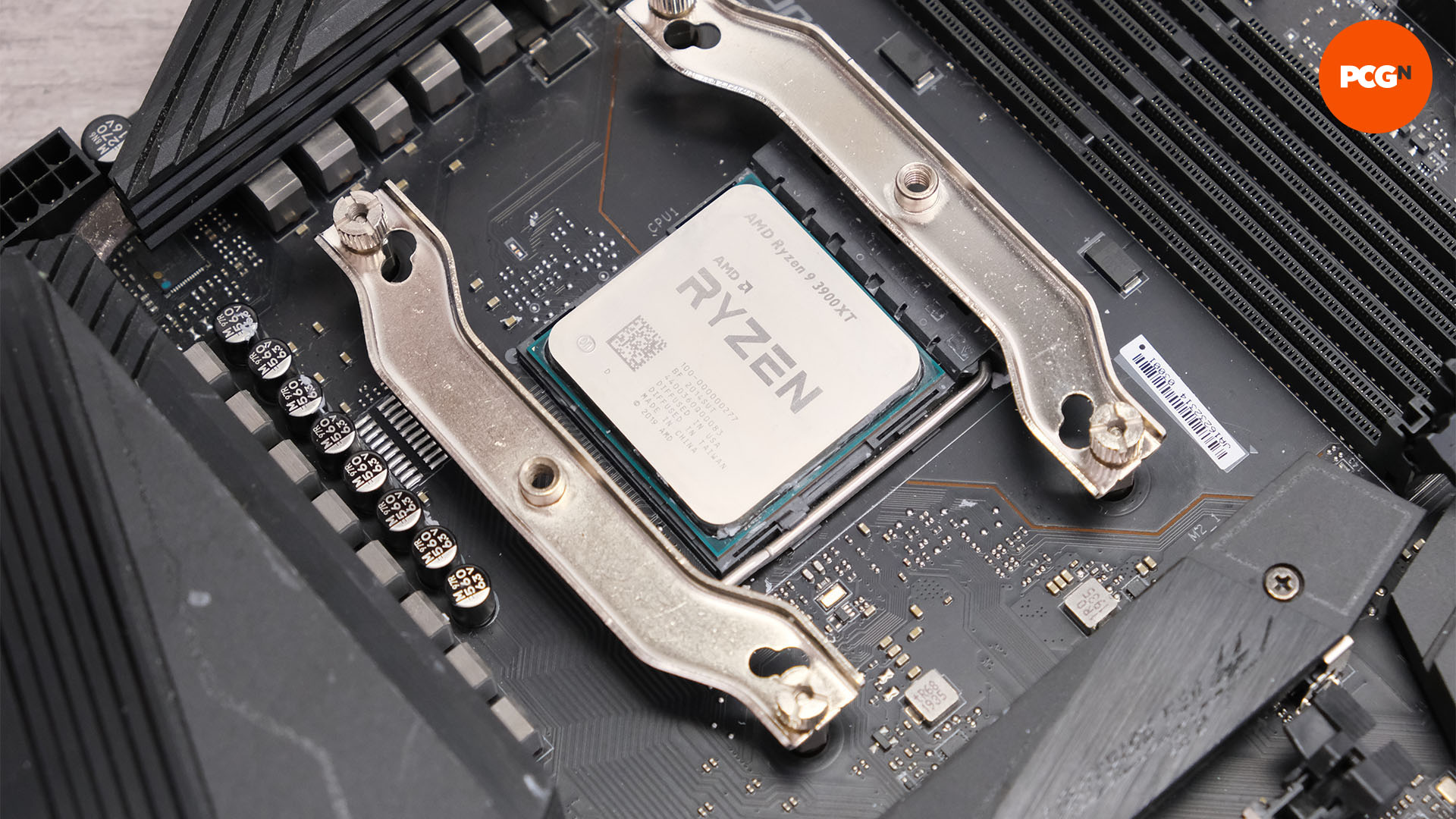
Beneath, there’s a backplate, which may be used to mount your cooler or it would embody a brand new backplate – this can be detailed in your cooler’s directions. The set up course of will then very in all probability contain screwing the mount to your cooler into both the default backplate on the again of your motherboard or a brand new one which comes with the cooler.
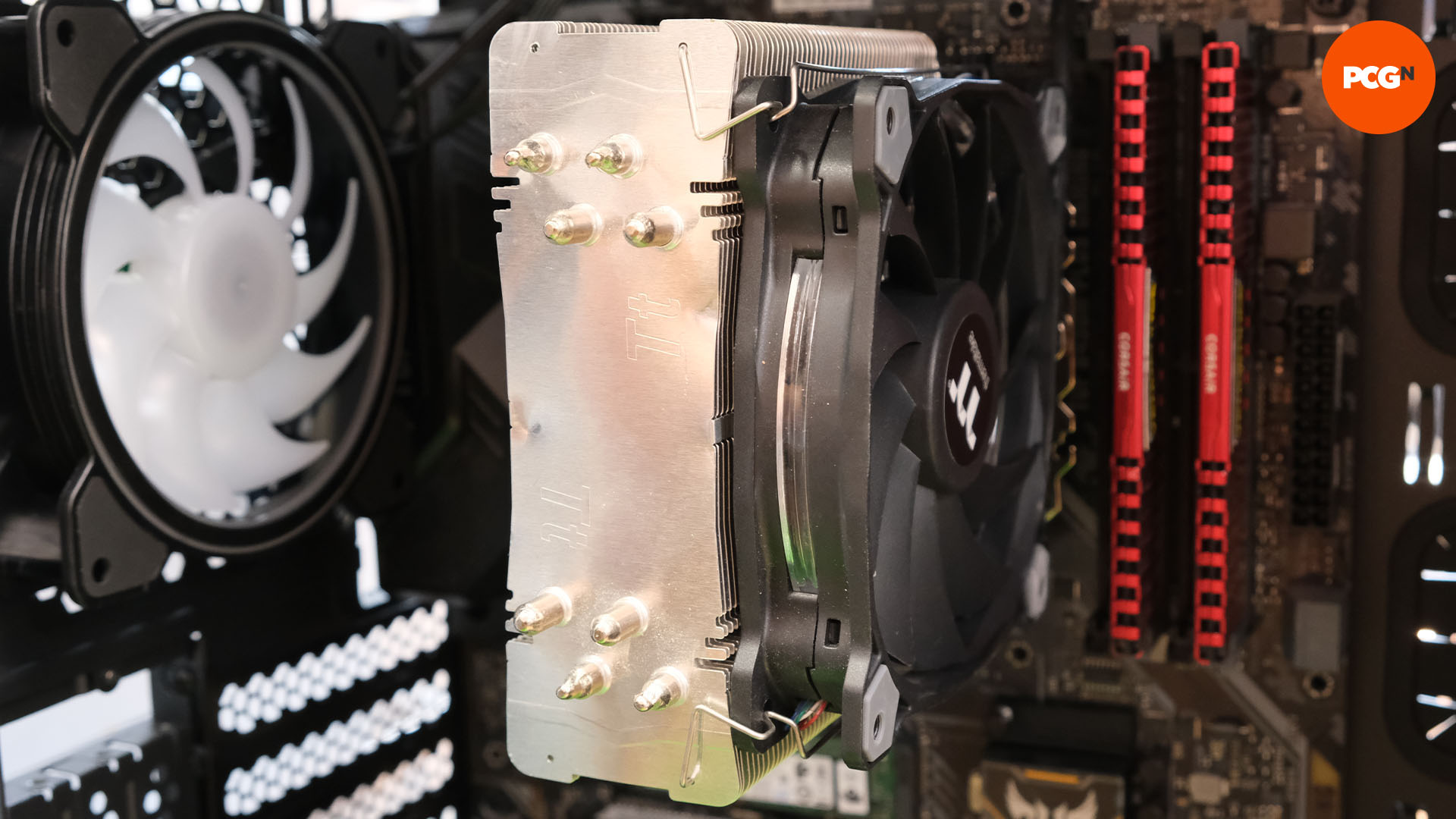
In terms of mounting your cooler, orient it in order that the fan is blowing air via the heatsink and towards the rear of your case. That is the airflow course for the overwhelming majority of circumstances, particularly if they’ve a rear exhaust fan, as this helps the CPU cooler expel its heat exhaust air out of the case. Nevertheless, some circumstances do differ of their airflow designs, for instance with a bottom-to-top airflow course, so it’s properly value checking the handbook to your case.
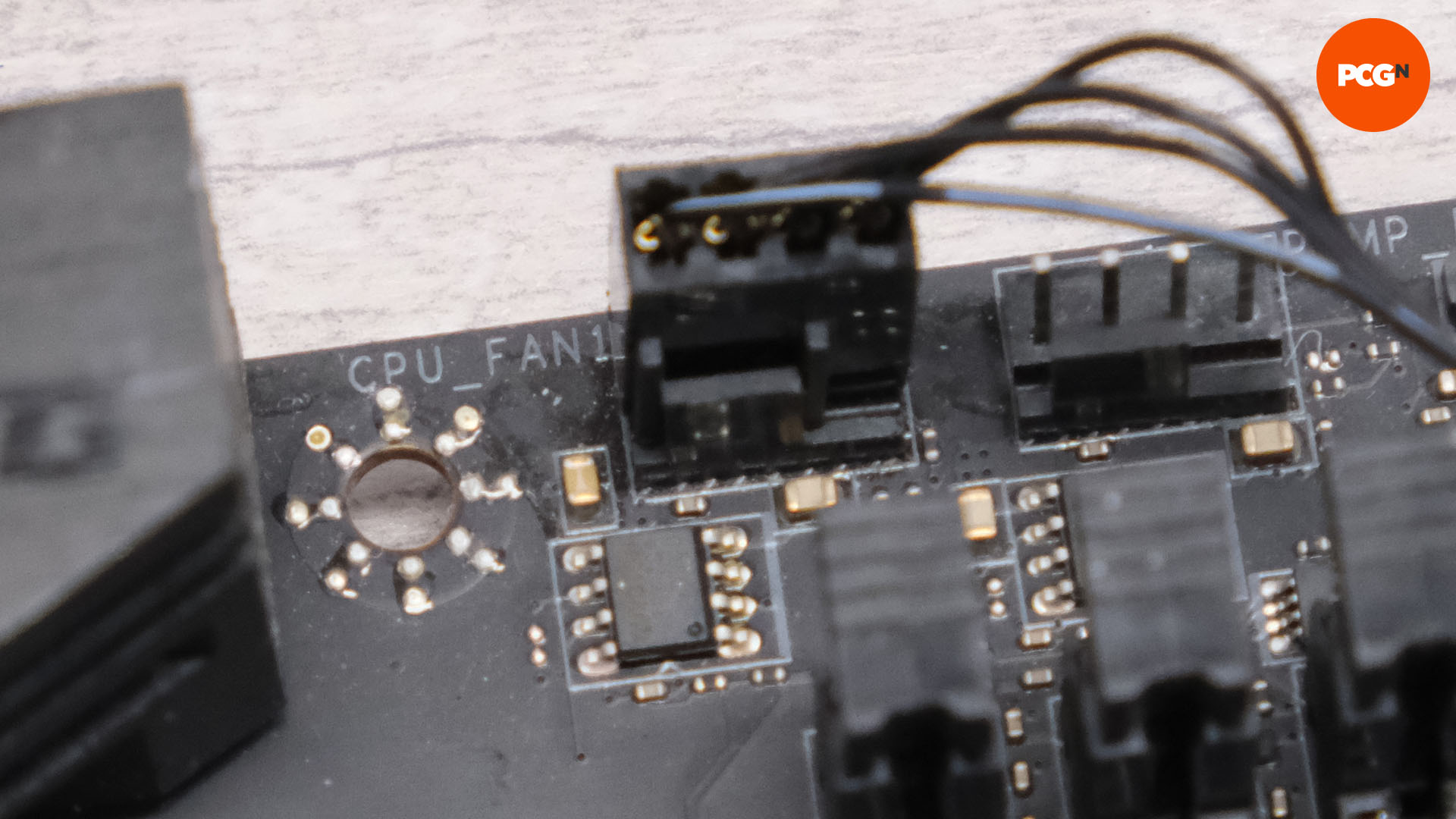
The fan is prone to be powered utilizing a 4-pin connector, which must be related to your motherboard’s CPU fan header. That is often labeled on the PCB, however its location can range. It’s essential to make use of this header and never any of the opposite ones dotted round your motherboard’s PCB, as this one is particularly designed to cope with the fan in your CPU cooler and should dish out totally different fan speeds accordingly.
8. Match an AIO liquid CPU cooler
The initialism in AIO cooler stands for ‘all-in-one’, and these coolers primarily provide a sealed loop comprising a pump and waterblock that sit in your CPU, plus a radiator with followers mounted to it, which work in the same method to an air cooler.
With two key parts making up the setup, they’re barely extra sophisticated to put in than air coolers, however the course of continues to be easy. We’ll run via the entire course of of putting in one right here, so you’ll be able to refer again to it later after we cowl the important thing PC constructing steps.
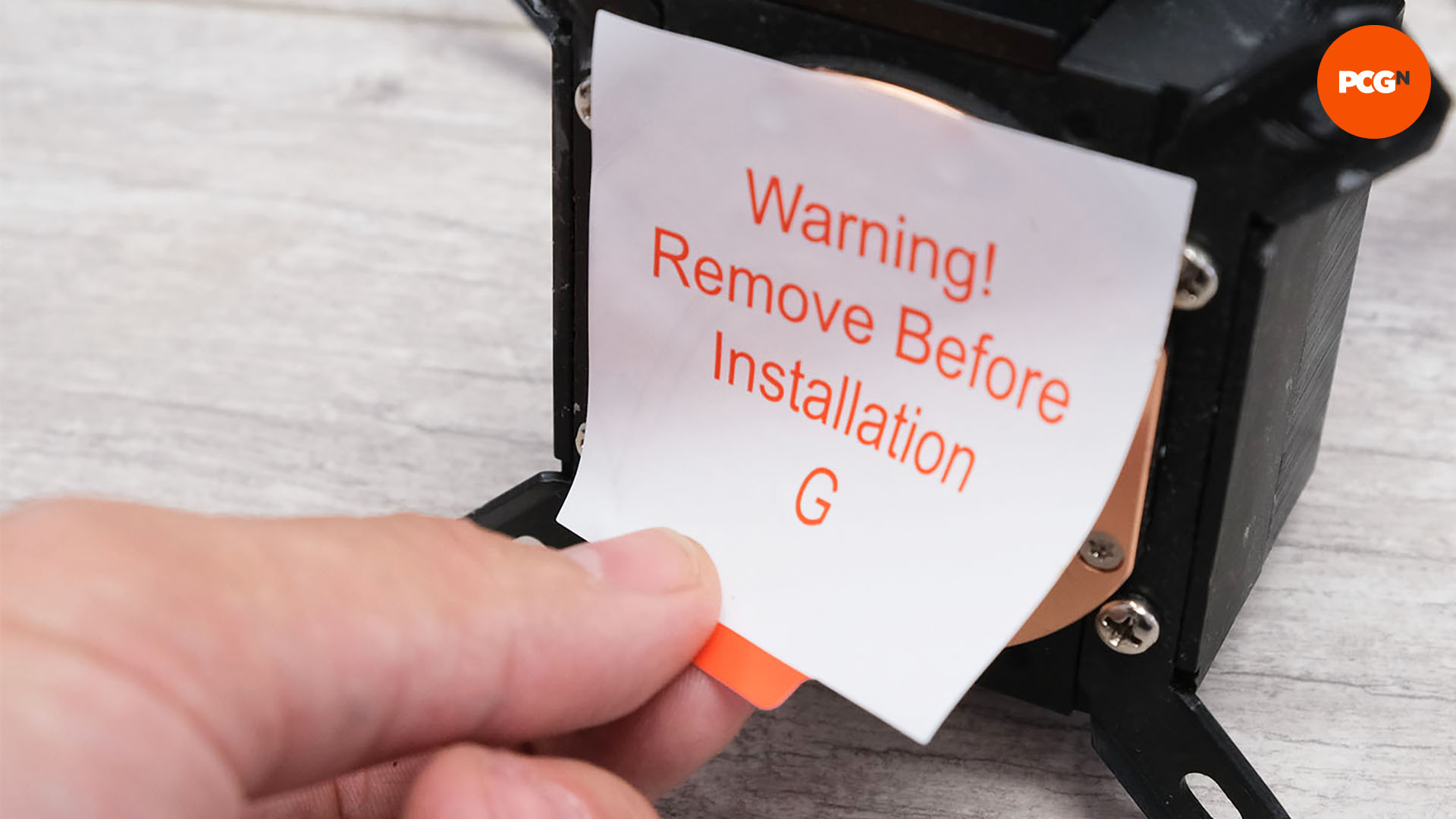
Begin by eradicating the plastic protecting movie off the underside of the pump’s contact plate, then supply the components from the field wanted to suit the block to your motherboard’s particular CPU socket. As with most coolers, a number of sockets are prone to be supported by your liquid cooler.
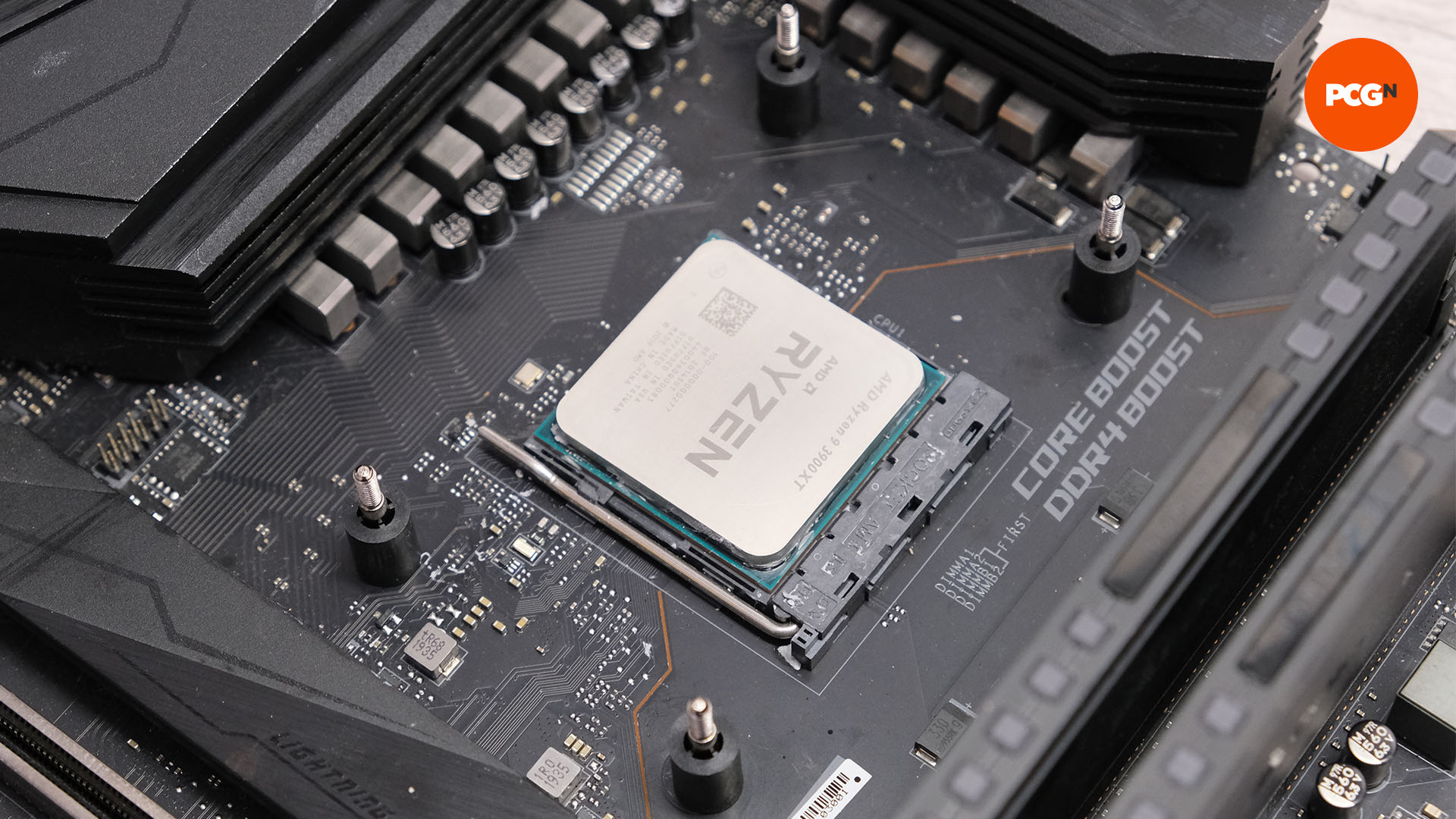
Set up the parts required to safe the pump to your motherboard. This course of all the time entails a mounting equipment for Intel motherboards, whereas with AMD Socket AM4 motherboards you both use the plastic brackets already on the board, otherwise you’ll be required to take away them so as to create a extra elaborate mounting contraption.
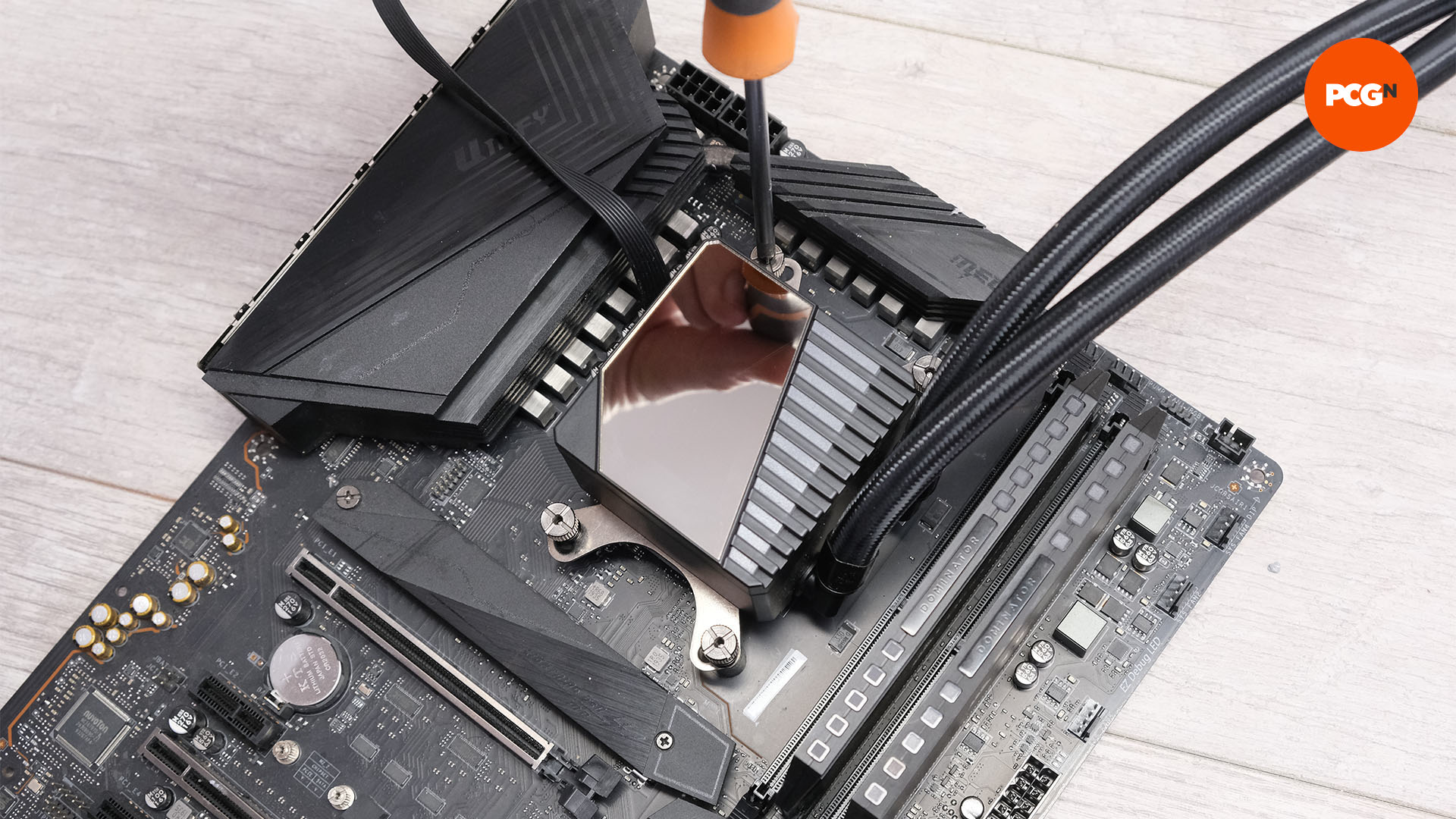
It’s now finest to put in the pump/waterblock unit to your motherboard prior to installing the motherboard in your case. Chances are you’ll want to carry a backplate in place whilst you safe the pump from the highest facet of the motherboard, as that’s a difficult job if the motherboard is already put in in your case.
Ideally, you need to set up the radiator in order that it’s greater than the pump, and any air within the loop will get trapped within the radiator and never within the pump. For that reason, it’s finest to position a liquid cooler’s radiator in your case’s roof.
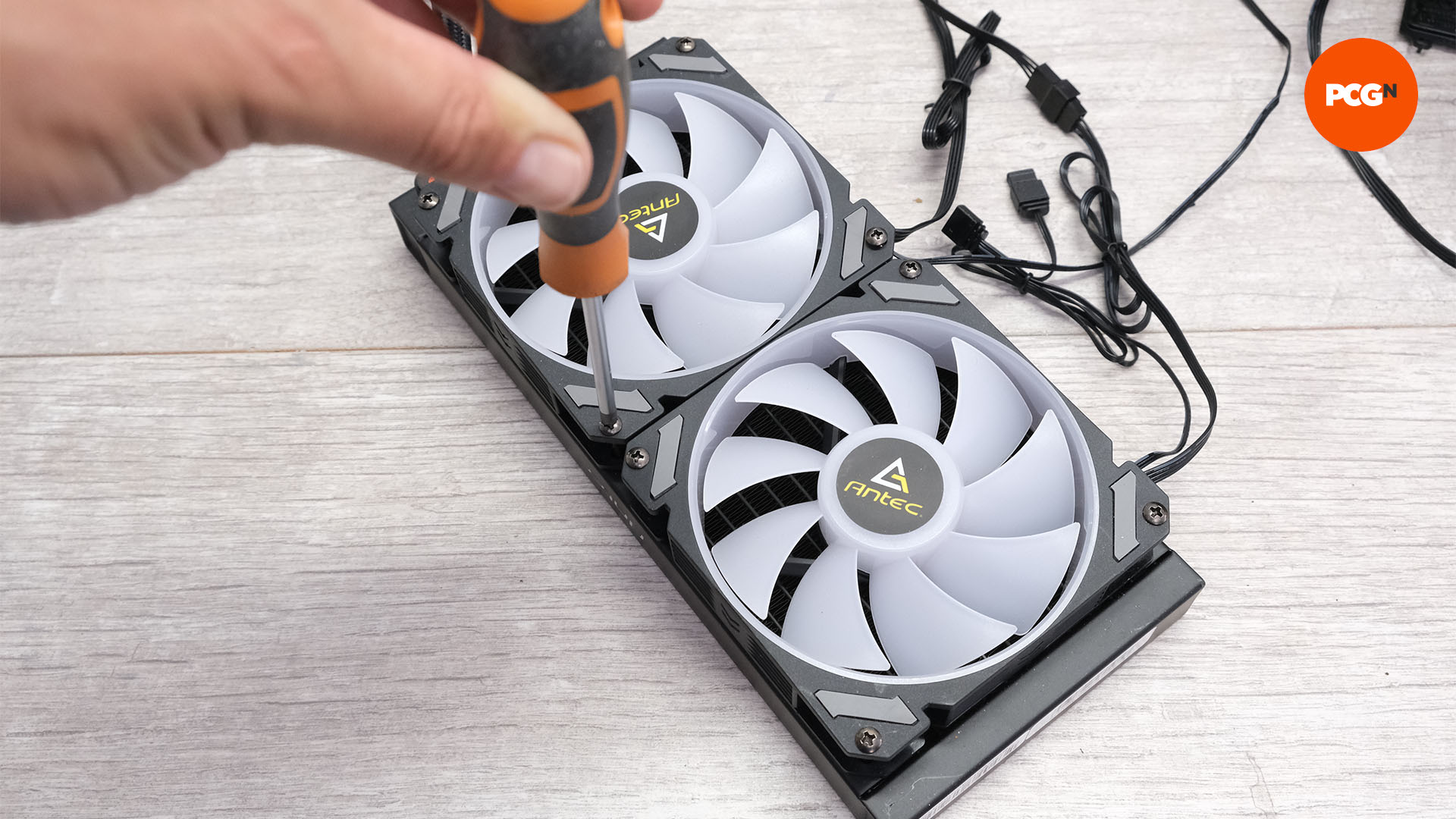
The followers can even have to be positioned in order that they blow air via the radiator, which must be mounted on to the roof. Begin by becoming the followers to the radiator utilizing the lengthy screws included within the field. These go via the followers and safe them to the radiator. The open facet of the fan is the consumption, with the framed facet of the fan being the exhaust.
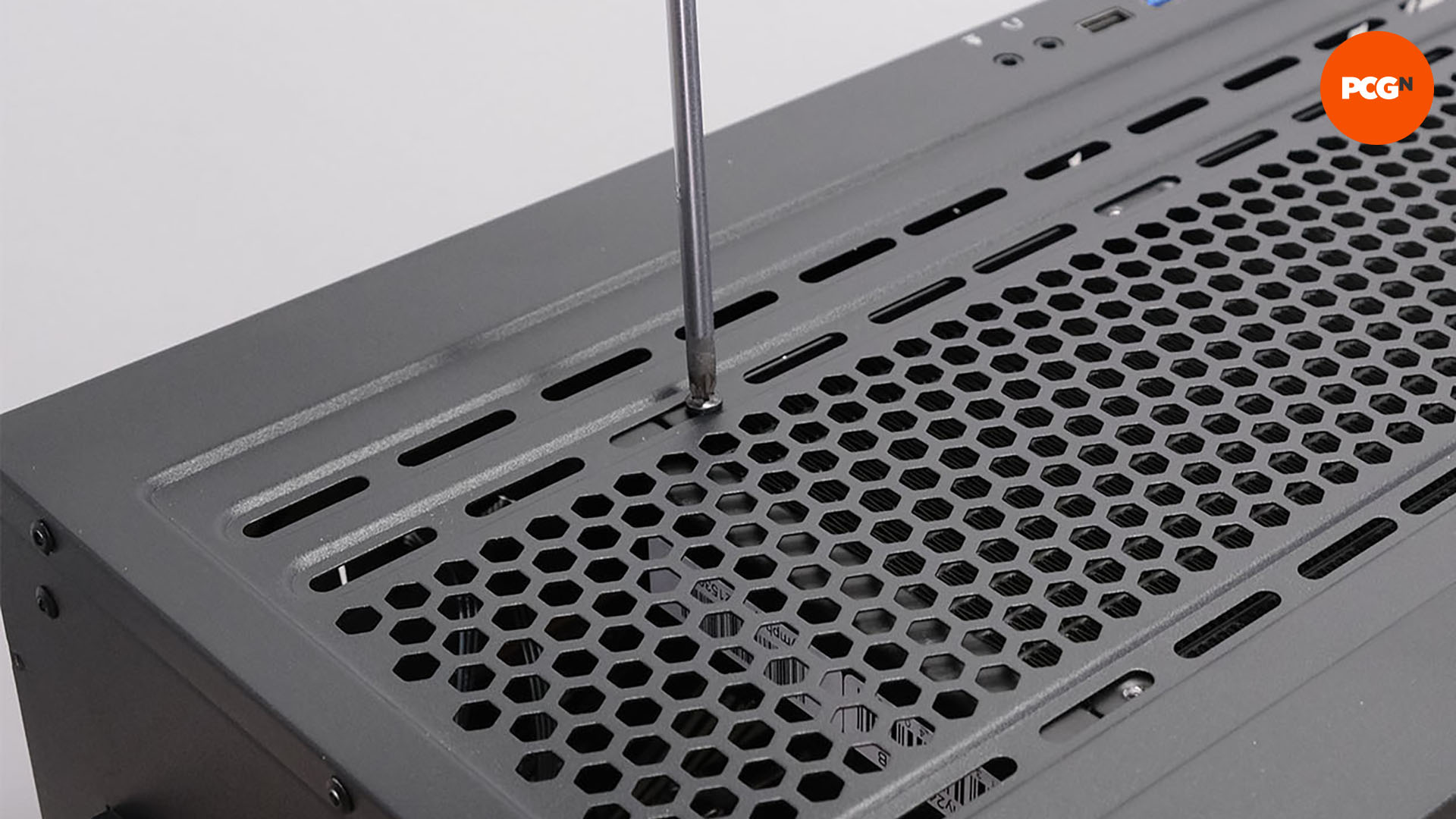
To safe the radiator to the case, you’ll want to make use of the smaller screws included within the field. Place the radiator within the roof fan mounts and line up the radiator mounting holes with the fan holes within the roof.
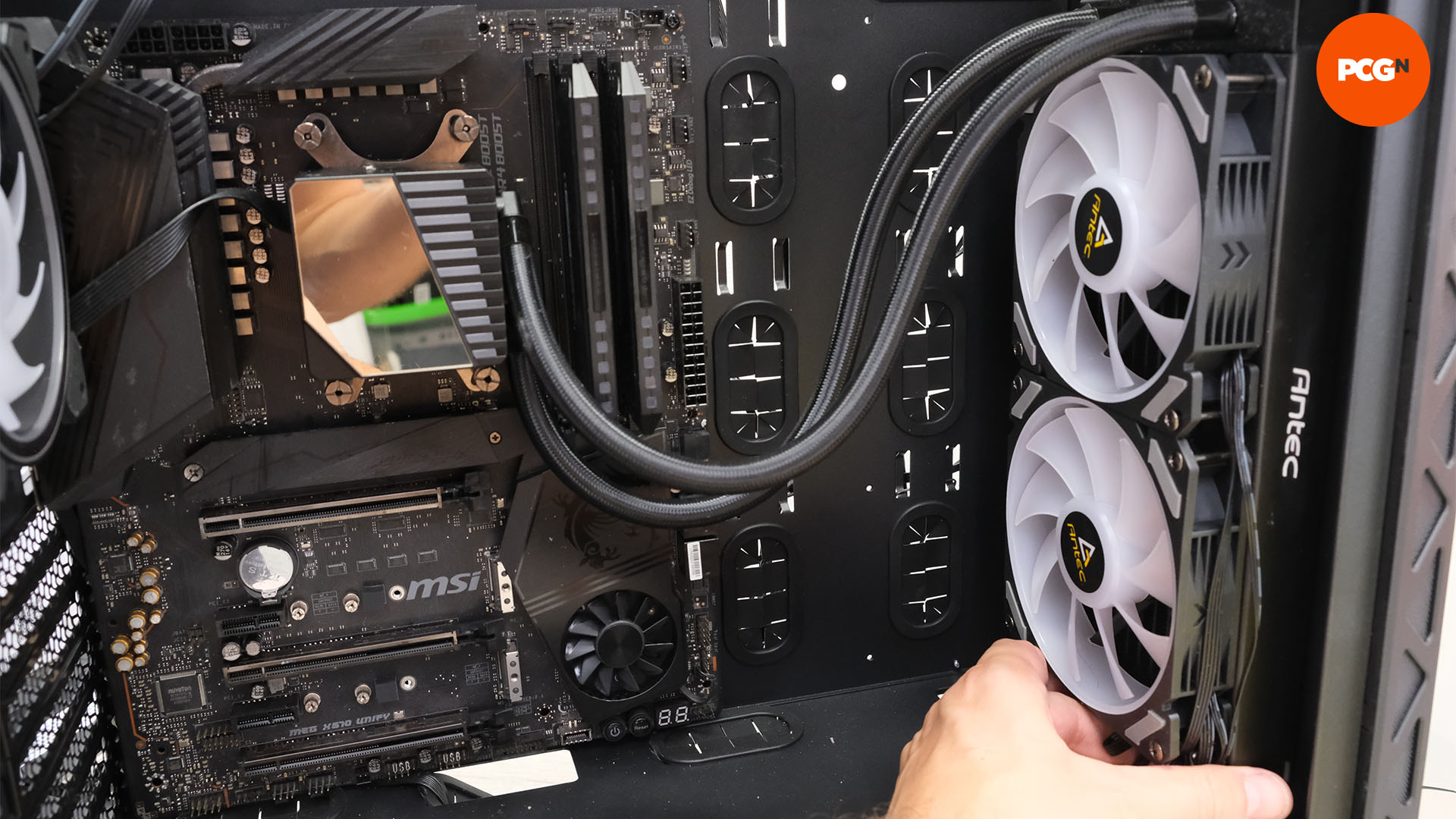
Not all circumstances have roof fan mounts or house sufficient for a radiator, so when you’re on this scenario place the radiator within the entrance of the case with the tubes on the prime. You ideally need to have the tube finish of the radiator sitting barely greater than the pump connected to your motherboard.
Lastly, you must join your cooler’s followers and pump to your motherboard. Some AIO liquid coolers require the usage of a SATA connector out of your PSU for energy, relying in your motherboard just for fan pace management, whereas others get all their energy from the motherboard.
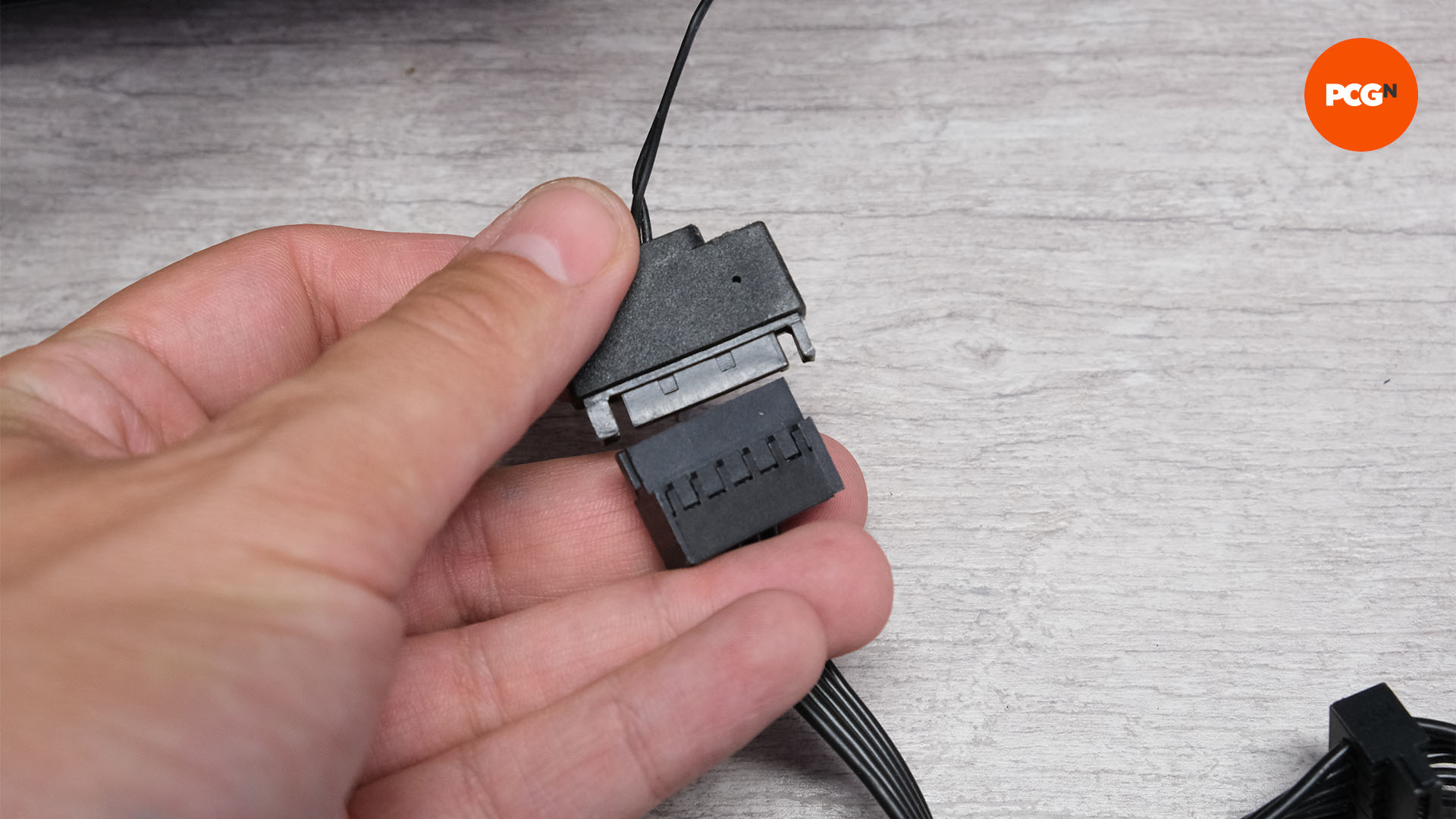
In any case, until the cooler makes use of some form of hub, or a software program management system, you’ll want to attach the followers to your motherboard to get their energy.
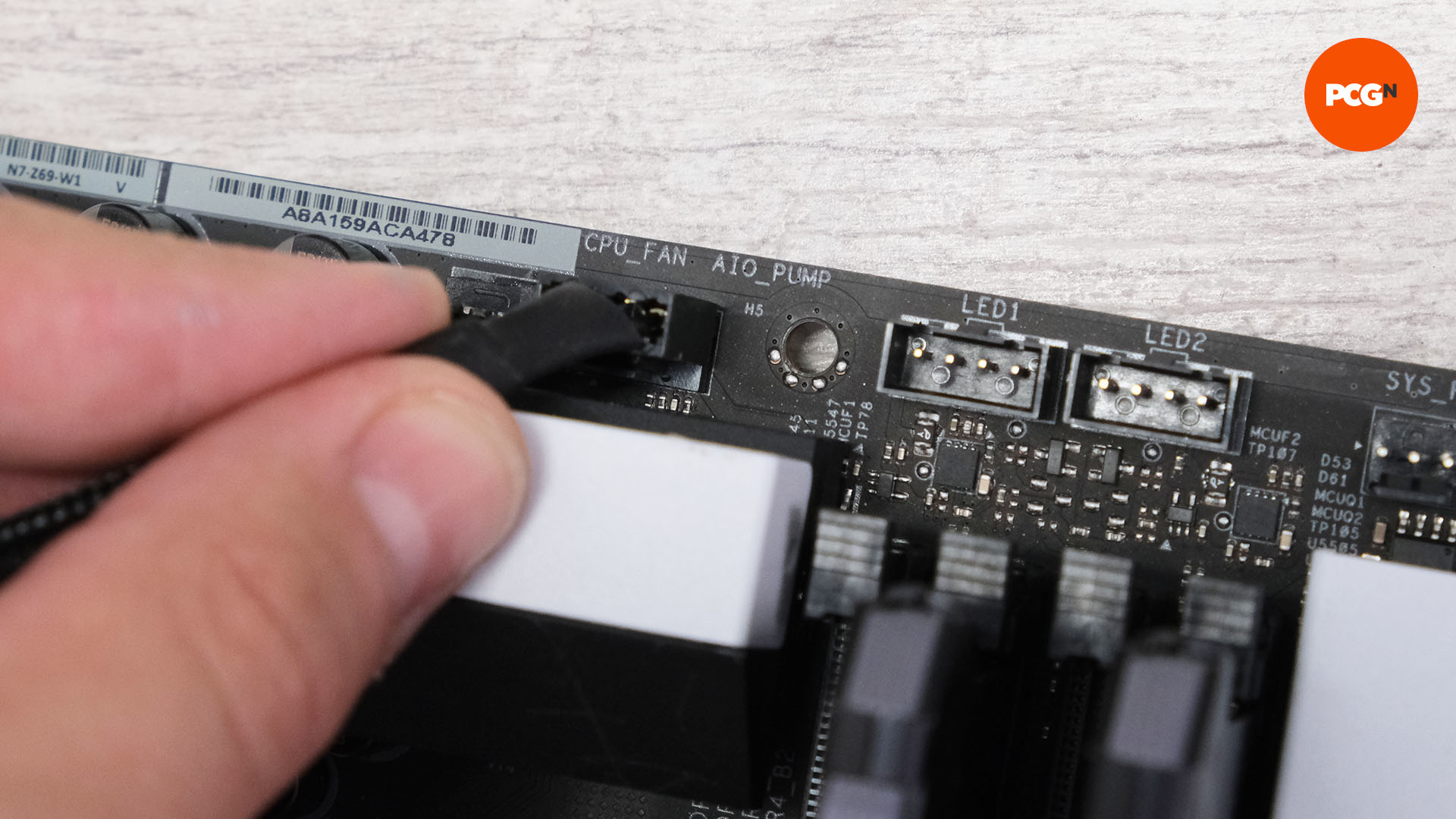
Most motherboards have a devoted header for pumps (usually labeled ‘AIO’), which offers a gradual voltage stream, because it’s a good suggestion to run the pumps at full pace on a regular basis – that is the header to which you join your cooler’s pump/waterblock unit – don’t hook up the followers to this header, nonetheless. The one exception is that if there’s only a single cable that powers the pump and followers collectively, through which case this cable needs to be related to the CPU fan header.
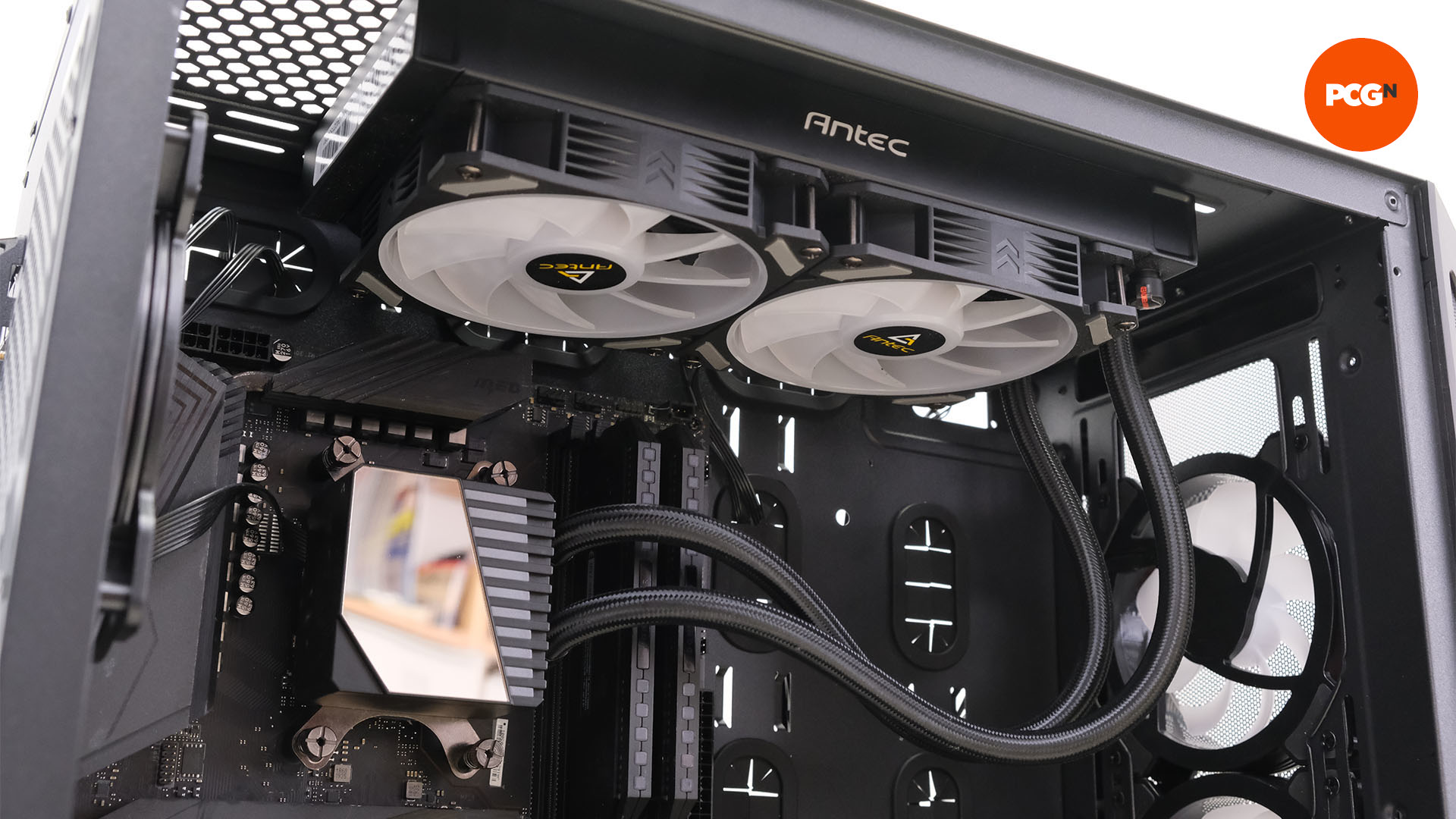
With the pump related to your motherboard’s pump header, join the followers to your CPU fan header. Your cooler ought to include a splitter cable if it has a number of followers, permitting you to energy two or extra followers from a single CPU fan header.
9. Set up M.2 SSDs
In the event you’re constructing a PC for the primary time, or upgrading from an previous system, you won’t have seen M.2 SSDs earlier than. In contrast to exhausting disks or 2.5-inch SSDs, they don’t require cables and as an alternative join on to considered one of a number of M.2 ports in your motherboard, and also you’ll want to make use of the fitting one.
In the event you’ve purchased an M.2 SSD not too long ago, it in all probability makes use of your motherboard’s PCIe interface to ship and obtain information. If it’s the older PCIe 3 customary then it ought to work in any M.2 port. If it’s the PCIe 4 or new PCIe 5 customary, although, then examine your motherboard’s handbook to see which M.2 ports help PCIe 4 and/or PCIe 5. Your drive will nonetheless work in a PCIe 3 M.2 slot, however it would run slower.
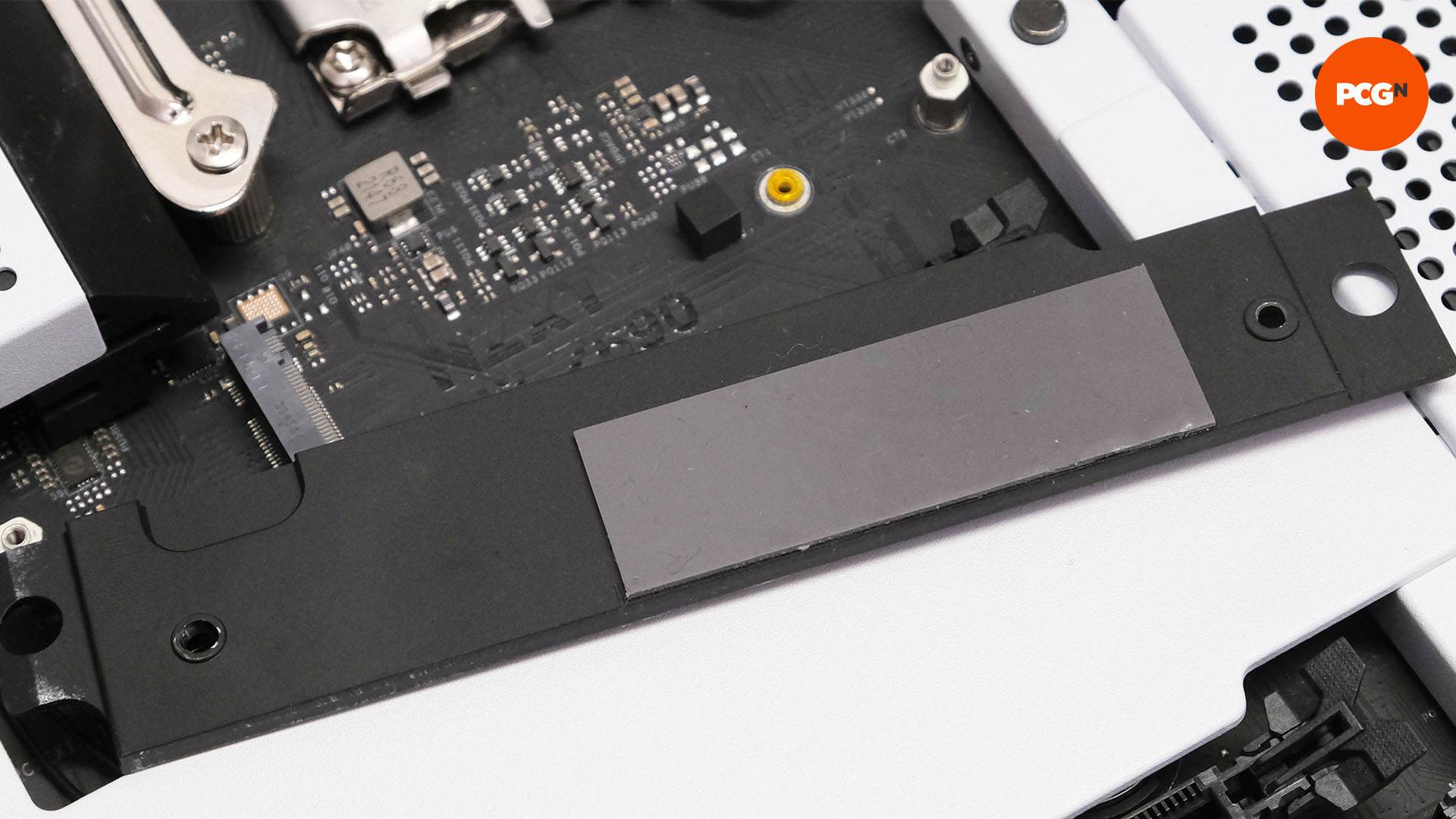
Your motherboard can even very in all probability present a heatsink for no less than one M.2 SSD, significantly if it’s a brand new mannequin. This isn’t important for PCIe 3 M.2 SSDs, however it may well assist PCIe 4 M.2 SSDs hit their most speeds for lengthy intervals with out thermally throttling. Take away the heatsink from the motherboard and peel off any protecting plastic that’s on the thermal pad beneath.
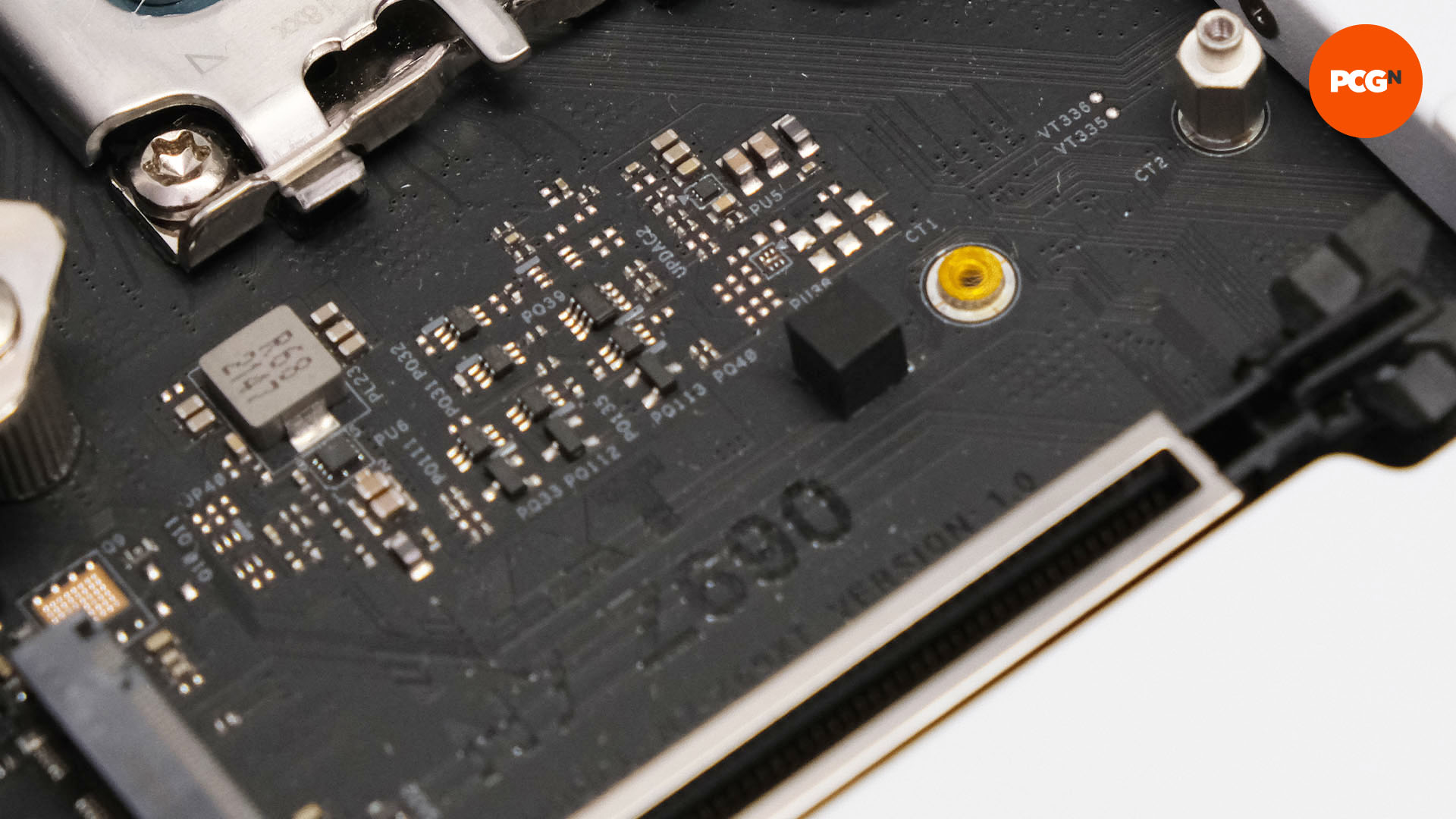
Your SSD can be secured utilizing a small screw or latch. The previous screws right into a standoff, which you’ll want to put in your self. The overwhelming majority of M.2 SSDs are 80mm lengthy and the right threaded gap for the standoff can be labeled both 80mm or 2280.
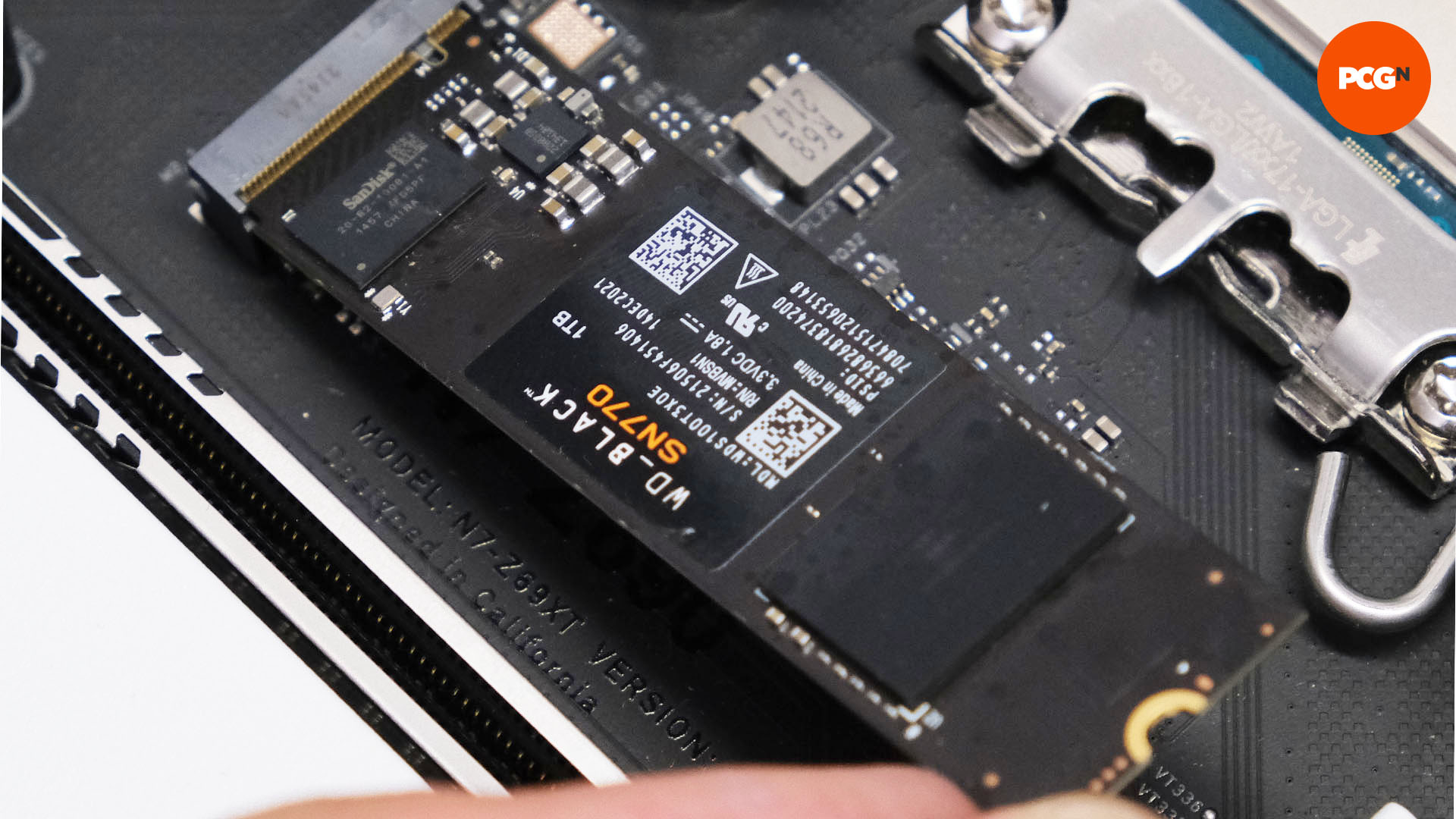
Subsequent, insert the M.2 SSD into the connector, so its finish part strains up with the notches within the M.2 port. You’ll want to carry the opposite find yourself by round 30 levels, so it’s inserted at a slight angle.
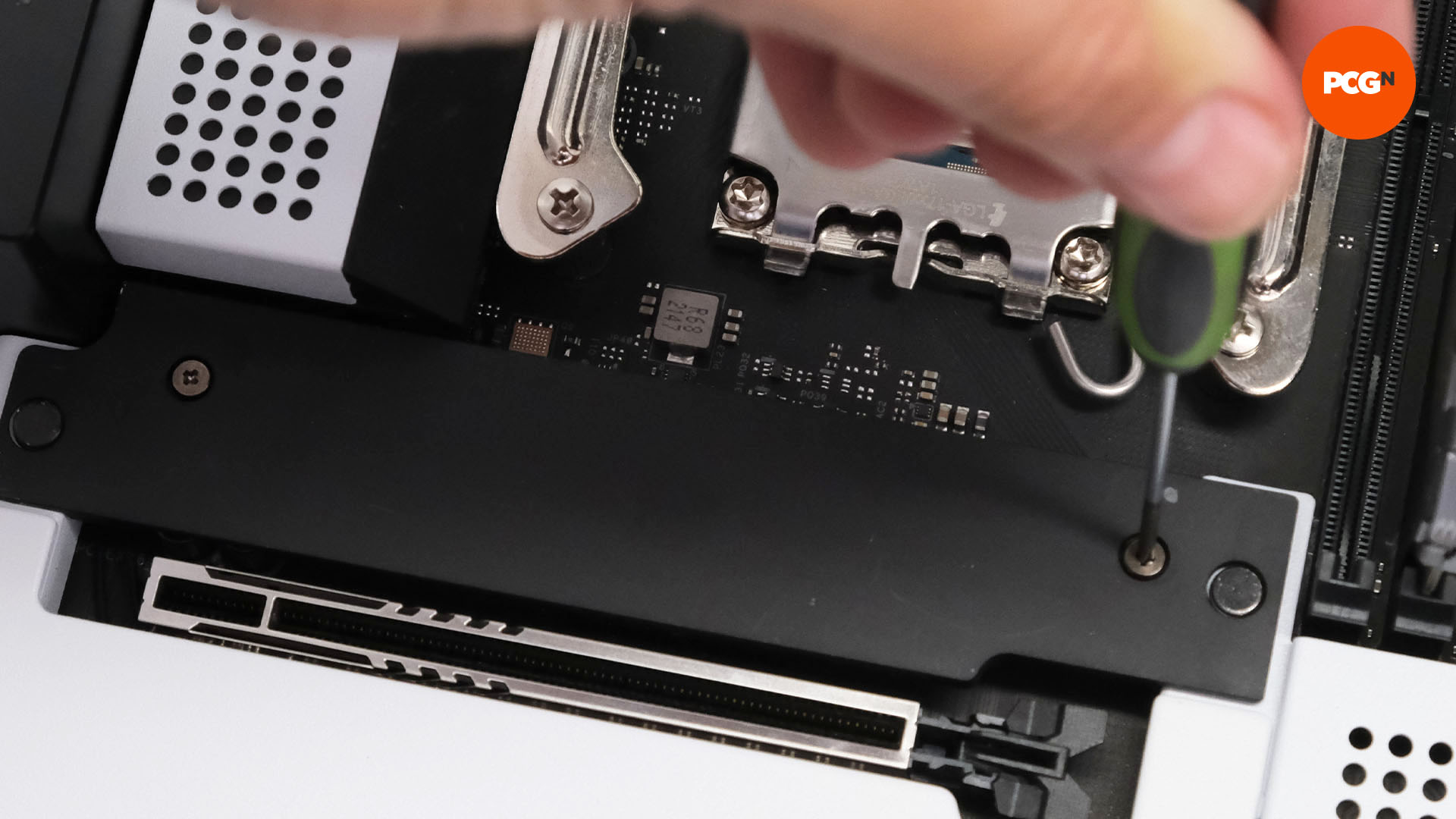
Subsequent, you’ll want a mini screwdriver to cope with the tiny screw that secures the M.2 SSD. Relying in your motherboard, this will additionally safe the heatsink too in a single go.
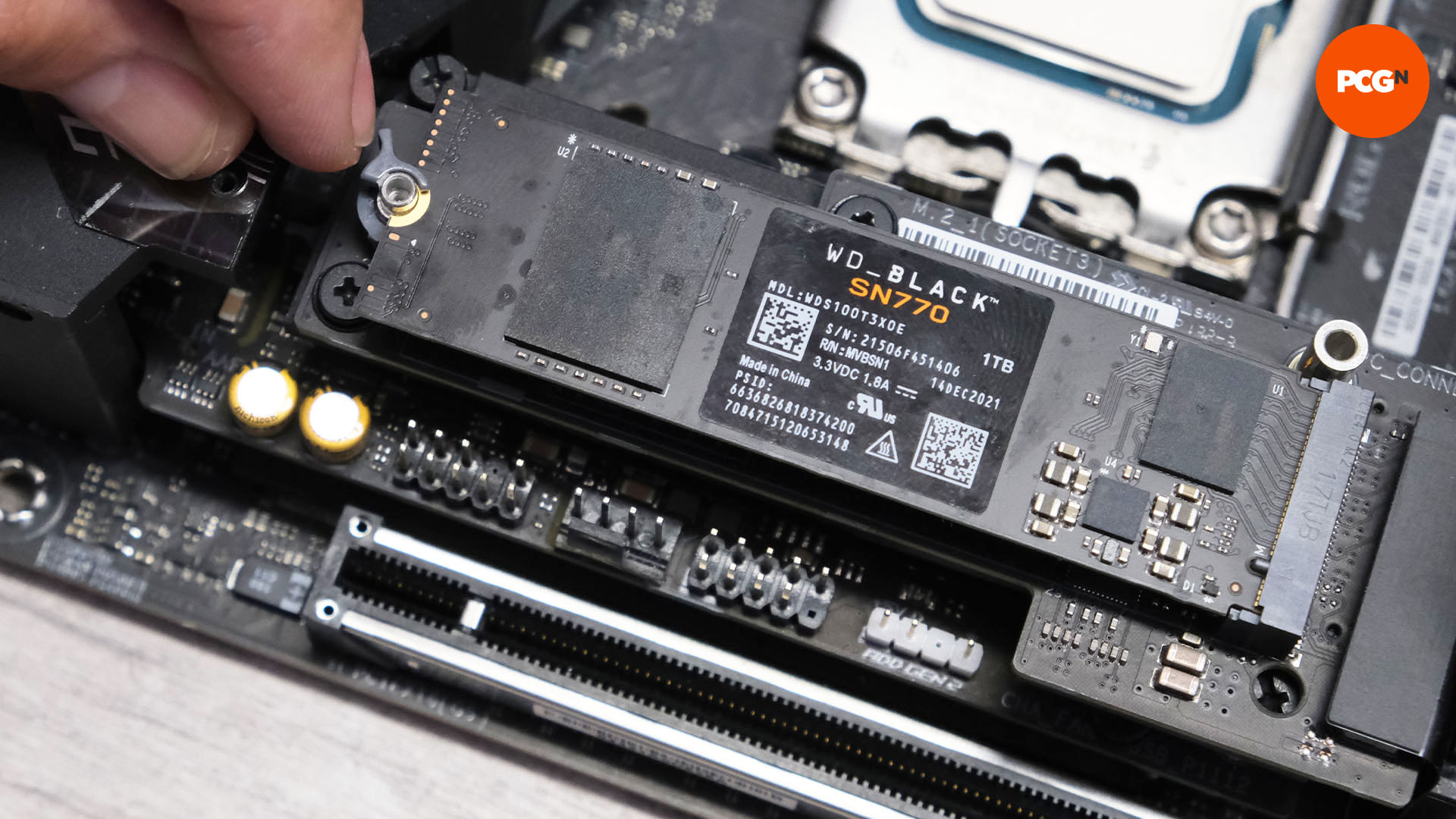
Some newer motherboards use tool-free latches to safe the SSD as an alternative, that are far much less fiddly than utilizing screws. To make use of considered one of these, set up the SSD then safe the latch by rotating it till it locks the SSD in place. You would possibly must rotate it round just a few occasions to see the way it works. For extra element, take a look at our full the way to set up an SSD information.
10. Take a look at your parts
On very uncommon events, considered one of your parts might arrive defective. The possibilities of this occurring are extraordinarily slim, nevertheless it pays to check your parts earlier than you construct your PC. You don’t need to need to undergo the method of constructing your PC solely to need to dismantle it once more if it doesn’t work.
There’s a easy method to examine all of your components are working, which is to construct your PC exterior of the case. This entails connecting the core {hardware}, plugging in a keyboard, powering it on, and making certain there’s an output to your show from the graphics card. In the event you get a show, then you already know the fundamental system works, and you’ll then get into the EFI to verify the SSD is acknowledged and set the right reminiscence pace.
You’ll need to have your CPU, reminiscence, cooler, and SSD put in within the motherboard at this level, however when you’re utilizing an AIO liquid cooler, be sure it’s related to the motherboard and energy provide, however with out the motherboard or radiator put in in your case but. Put the radiator to 1 facet – we’ll cowl the way to match the radiator to your case later.
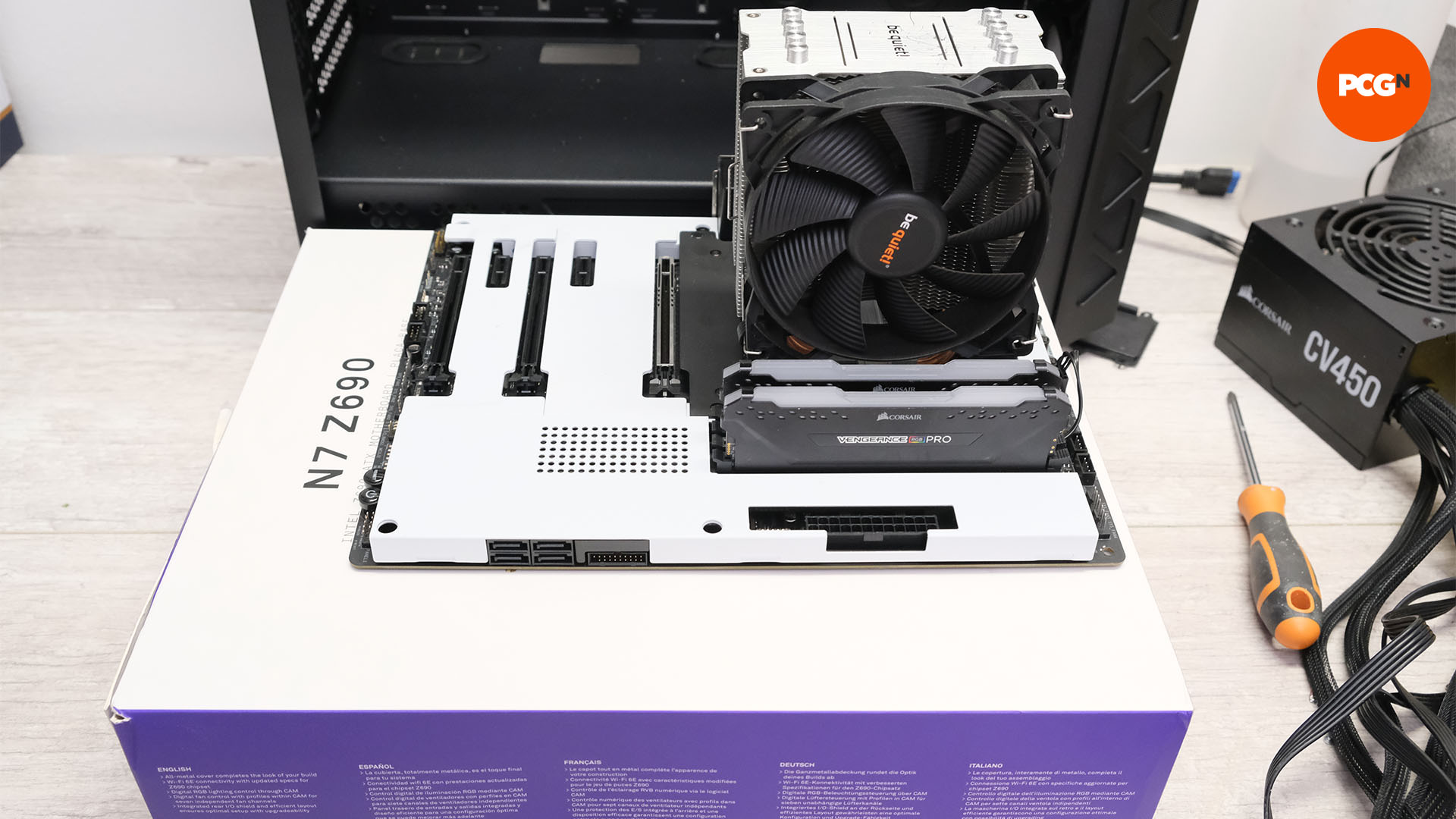
Place the motherboard onto its field, as this may insulate it and provide you with room to put in enlargement card backplates. Consider the field as a short lived take a look at bench.
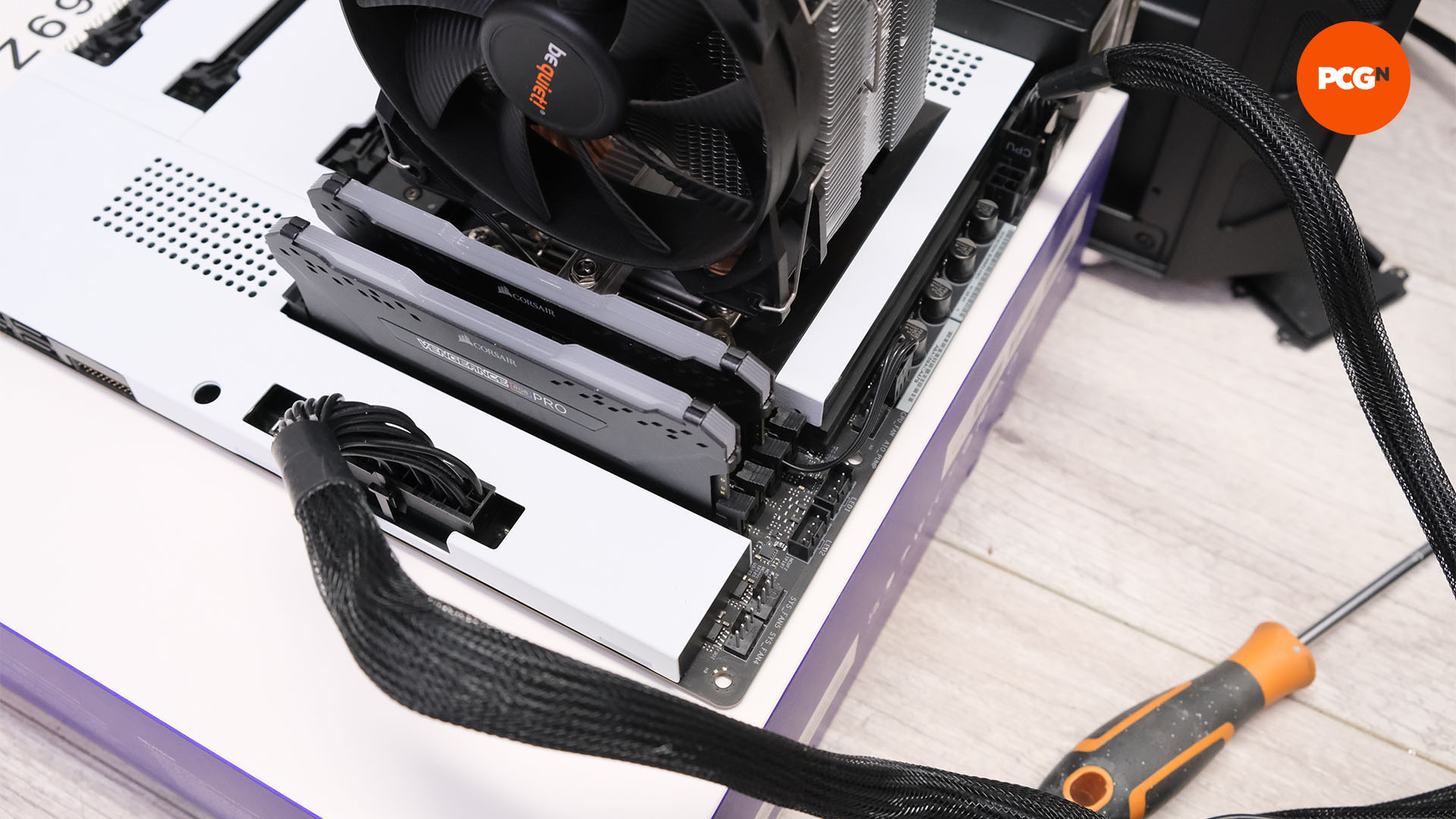
Subsequent, find the 24-pin and 8-pin CPU motherboard energy connectors in your PSU and hook them as much as the corresponding ports on the motherboard.
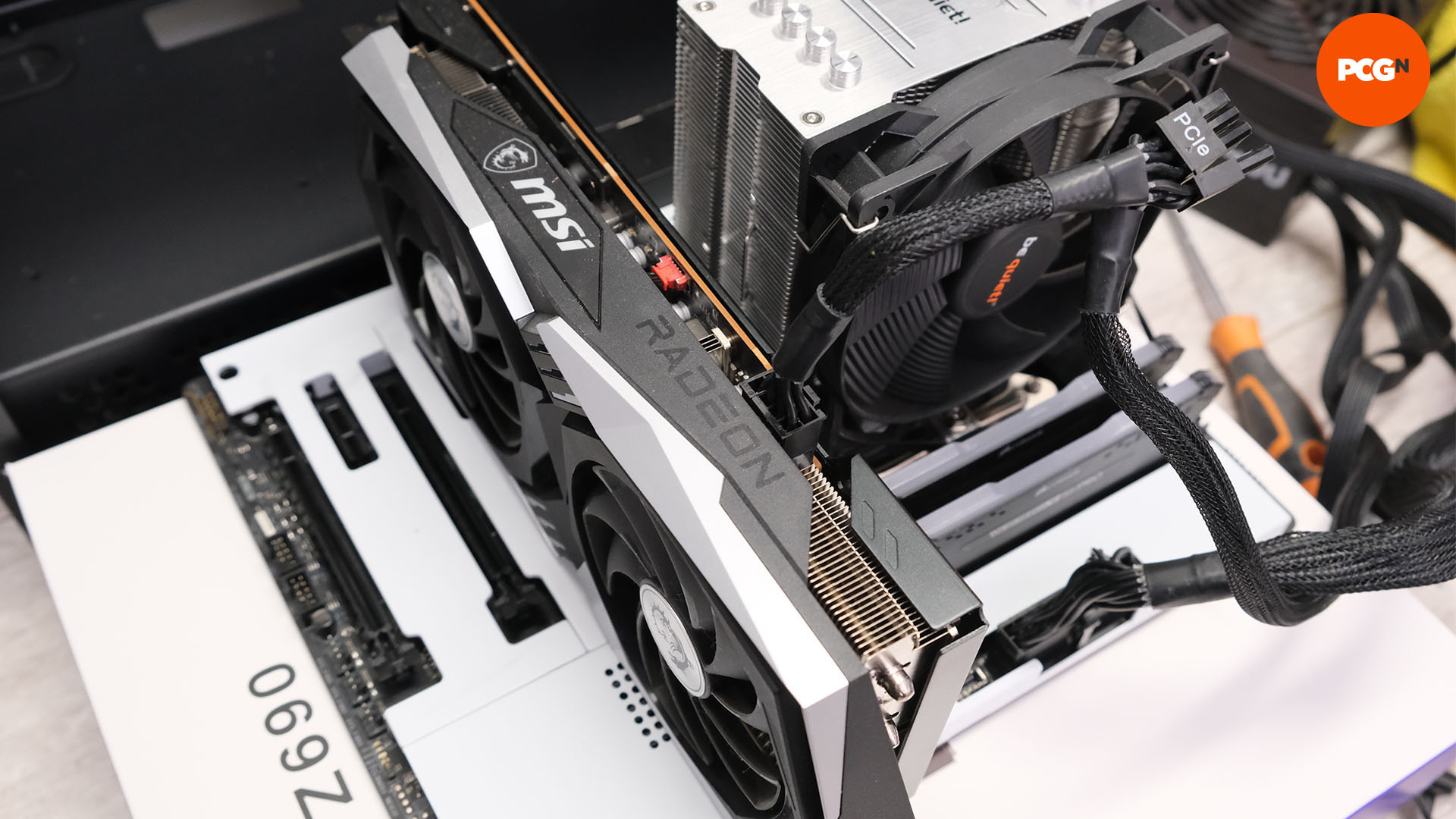
Subsequent, do the identical to your graphics card, utilizing no matter mixtures of PCIe energy connectors you want, earlier than putting in the graphics card into the highest 16x PCIe slot on the motherboard. The 16x PCIe slots are the longest horizontal slots on the motherboard beneath the CPU socket, and the one on the prime all the time helps the quickest pace out there.
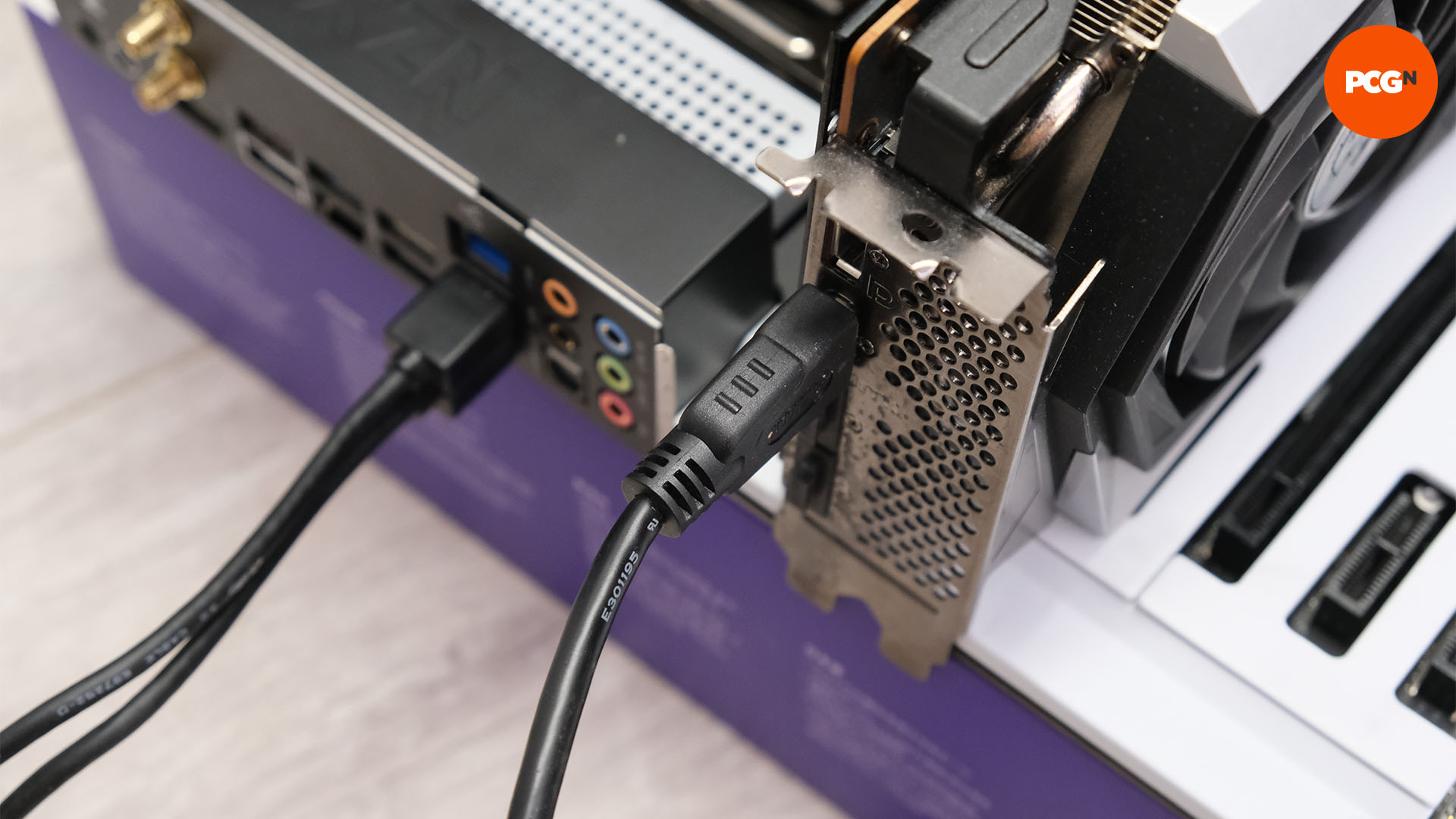
Join your mouse, keyboard, and monitor, with the primary two going to USB ports on the motherboard’s I/O panel, and the latter utilizing an HDMI or DisplayPort cable to a corresponding port on the rear of your graphics card.
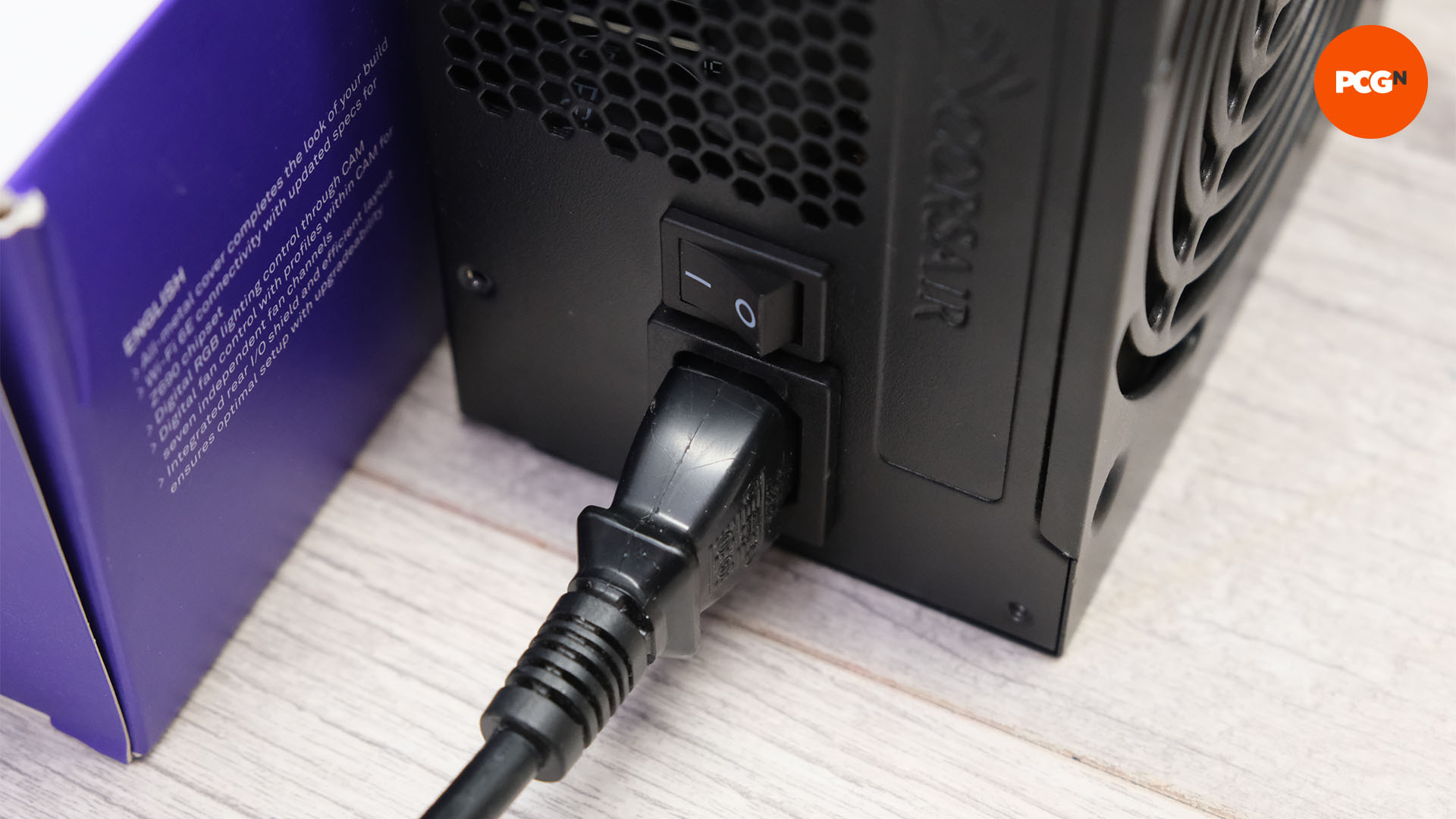
Subsequent, we want to have the ability to energy in your PC. Join your PSU to the mains and guarantee it’s switched on on the again.
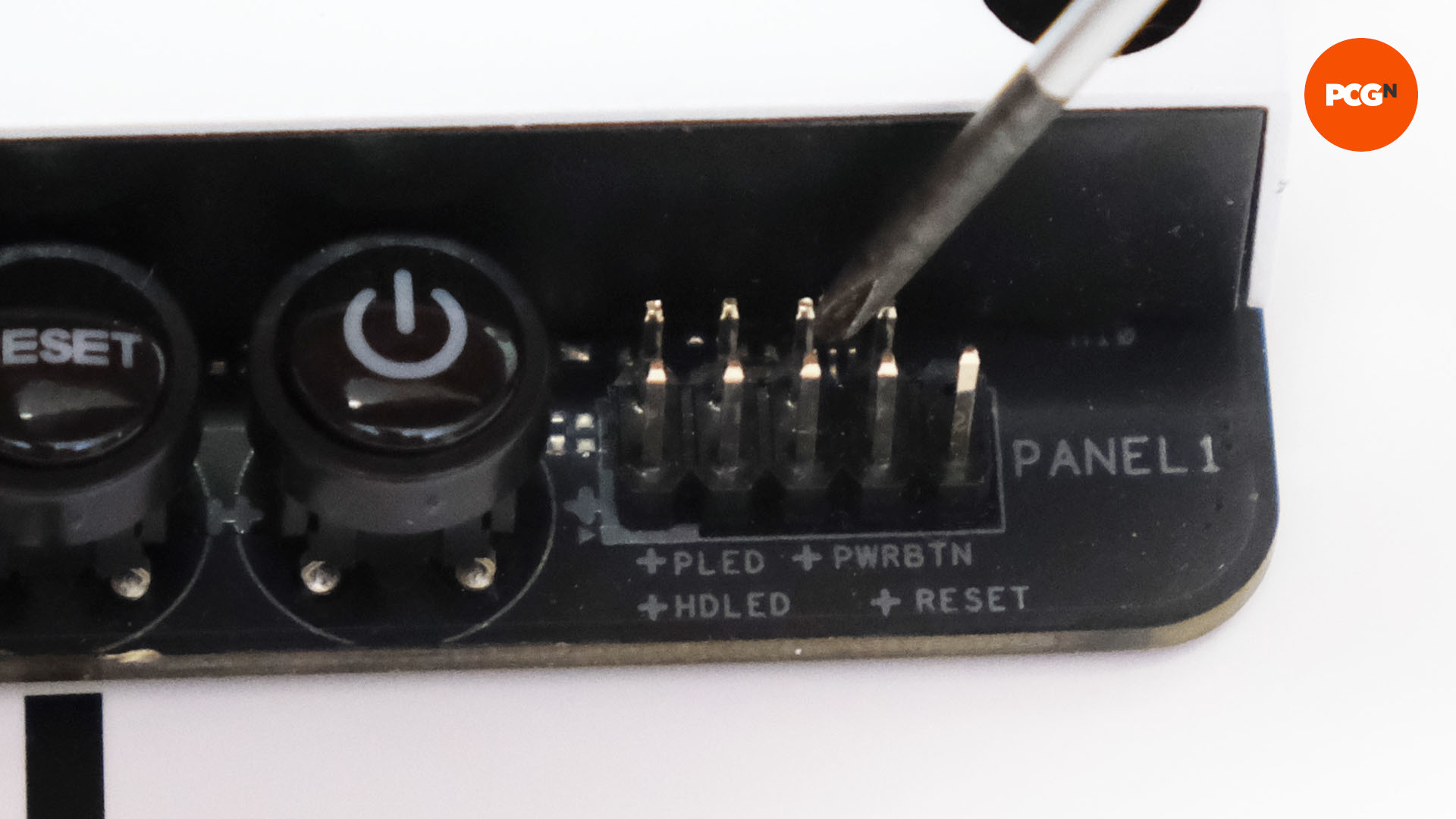
In case your motherboard doesn’t have an influence button on-board, the best method to flip in your PC is with a small screwdriver to brief the ability button pins on the entrance panel header. That is the place you join your case’s energy button. Shorting or connecting the pins collectively for a second will inform the motherboard and energy provide to fireside up. There aren’t any excessive voltages going via these pins – you’re completely secure.
Hopefully, your PC will energy on, followers will begin spinning and you’ll give your self a pat on the again for constructing your first PC. Nevertheless, we’re not fairly accomplished but.
When prompted, hit the Del key in your keyboard to enter the EFI. In the event you’re not prompted, flip off the PSU to energy the PC down, then energy it on once more and begin tapping the Del key at one-second intervals.
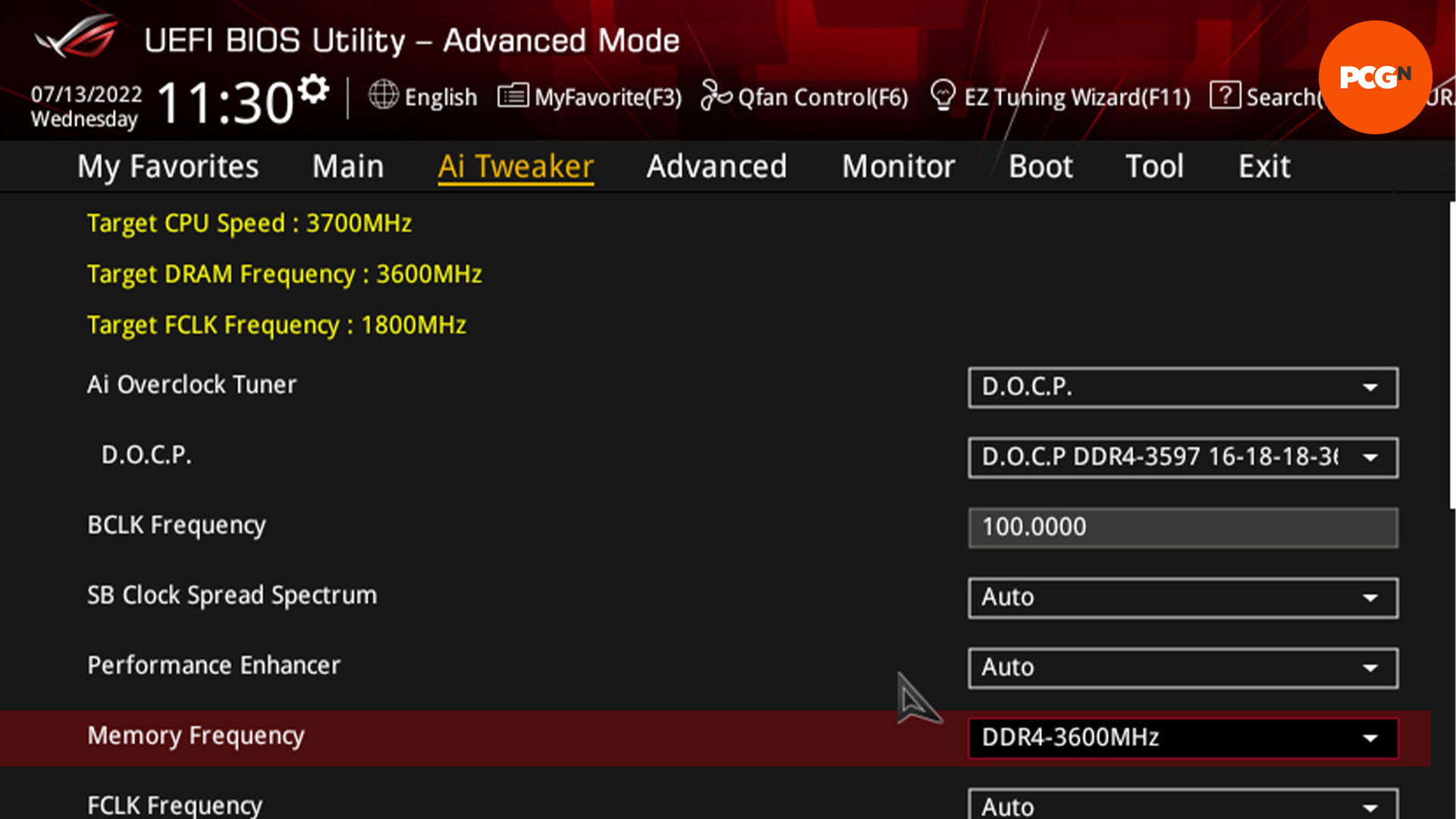
In some unspecified time in the future, the PC ought to enter the EFI, the place we have to examine just a few settings. Begin by in search of the XMP profile setting on Intel motherboards, or EXPO on DDR5 AMD motherboards (in case your reminiscence helps it).
This may be seen on the EFI’s touchdown web page immediately, but when not, search for the Superior or Tweaker settings tabs and examine the menus for XMP or EXPO profile settings. Enabling the profile that matches your reminiscence’s pace will make sure the reminiscence runs on the appropriate settings similar to frequency and timings.
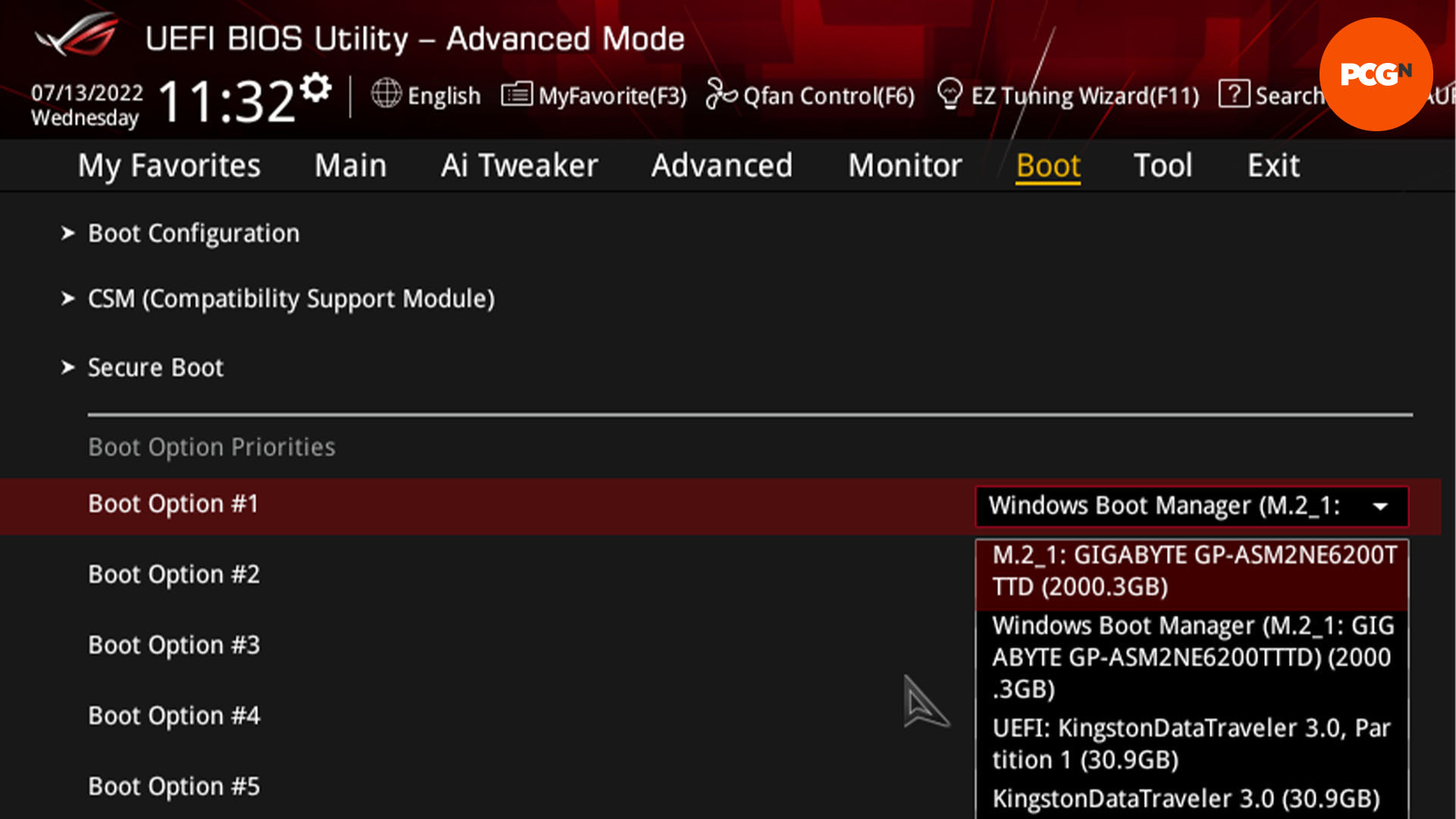
Subsequent, find the boot choices within the EFI. Discover the boot menu and examine your SSD is listed within the drop-down menu. It will guarantee it’s accessible and put in correctly, ready for Home windows to be put in.
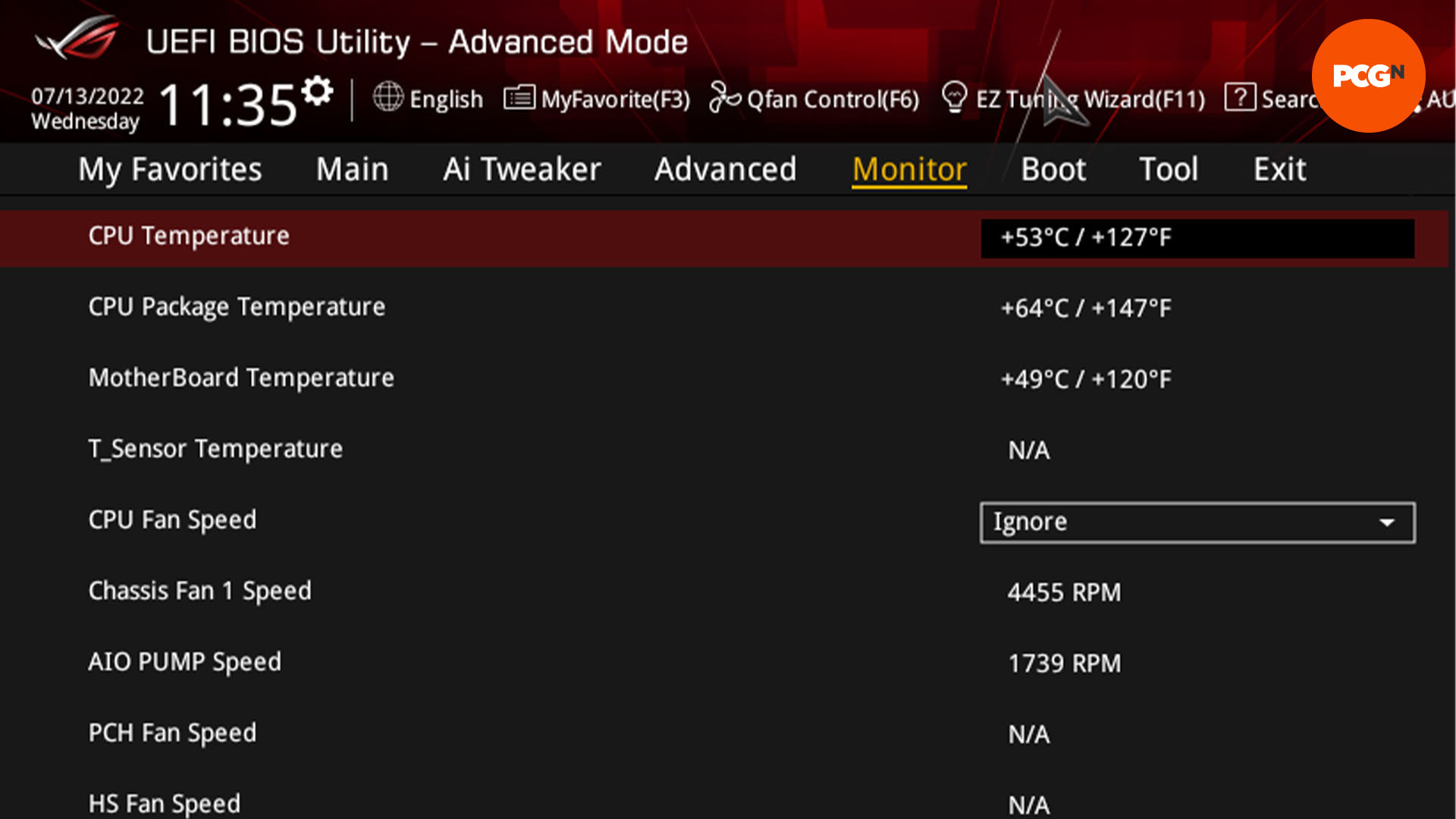
Lastly, we want to verify the cooler is working correctly, so the CPU isn’t going to overheat whereas we’re putting in Home windows. The temperature is seen on the house web page of most BIOS screens, or within the fan management and monitoring part.
At inventory pace the CPU temperature shouldn’t be a lot above 50°C whereas it’s sitting idle within the EFI – if it’s above 80°C there’s an issue, so be sure the CPU cooler’s fan is spinning, or that the pump in your liquid cooler is certainly plugged in and dealing.
11. Troubleshoot defective PC parts
Your PC doesn’t energy on
This factors at a elementary drawback someplace, however first be sure the PSU’s energy swap is on, that you simply’ve plugged it into the mains and examine all the ability cables to your parts, giving every an additional press into its port. It’s even value detaching the 24-pin ATX connector and plugging it in once more, as we’ve seen this resolve issues sometimes. It’s additionally value unplugging your reminiscence modules and reinserting them – as a final resort, do the identical with the CPU.
Your PC powers on, however there’s no show
This could level once more at unfastened parts, such because the graphics card, energy connectors, CPU or reminiscence, so be sure they’re all seated correctly, but in addition be sure your BIOS is updated and helps the CPU you’re utilizing. You’ll be able to attempt updating it in case your motherboard has USB BIOS flashback, nevertheless it’s additionally value resetting the BIOS too by utilizing the clear-CMOS characteristic. Your motherboard might have a button to do that, or you might must brief two pins utilizing a screwdriver, however seek the advice of your motherboard handbook on the easiest way to do it.
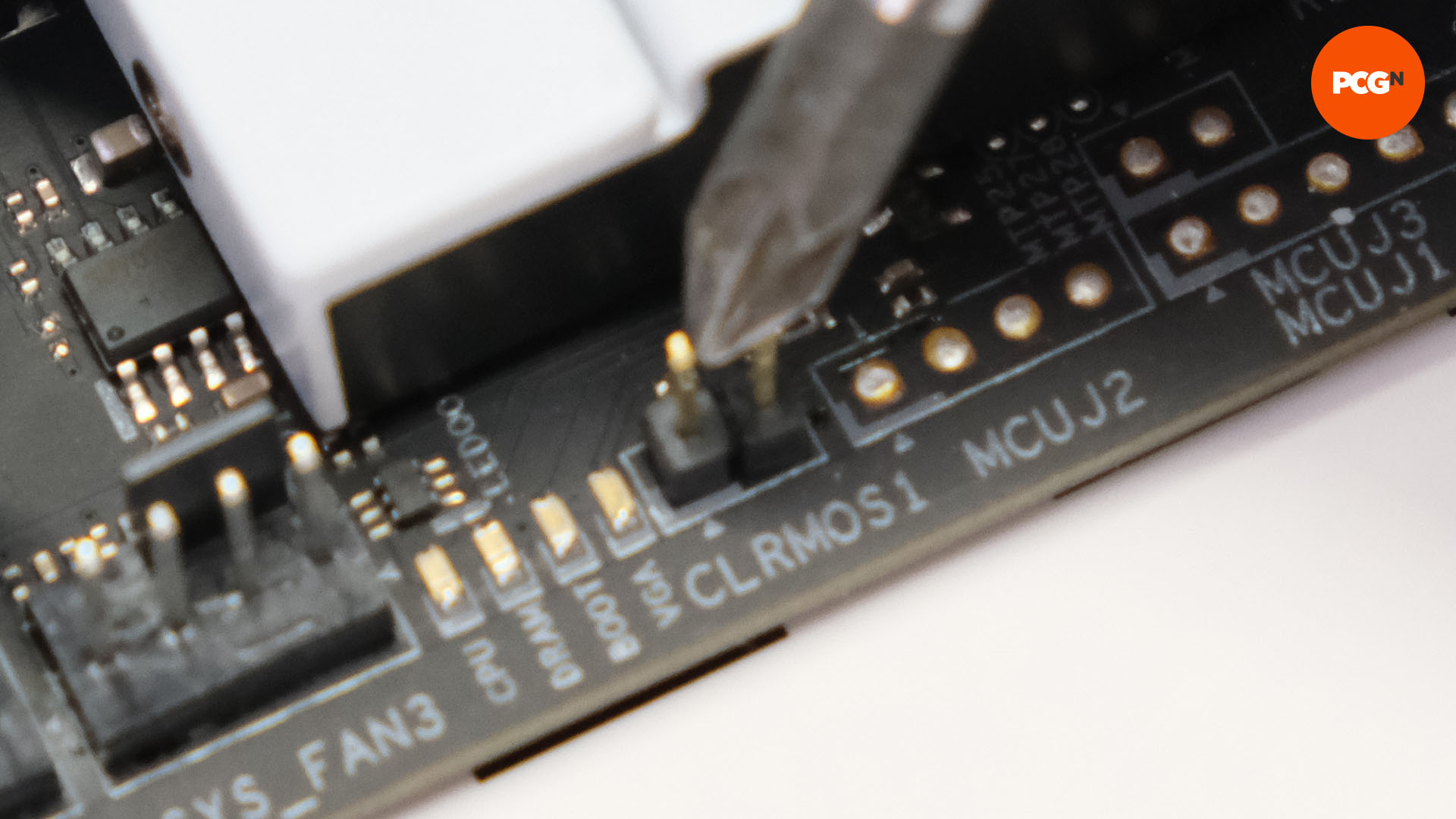
Figuring out defective {hardware}
By way of part failures, there are a few methods to check a number of the {hardware} to see if it’s defective. For instance, you’ll be able to examine in case your graphics card is defective by eradicating the graphics card, connecting your monitor to your motherboard and utilizing your CPU’s onboard graphics. Not all CPUs have onboard graphics, together with most of AMD’s newest CPUs and Intel’s F-series CPUs, however this can be a useful choice when you’ve got it out there.
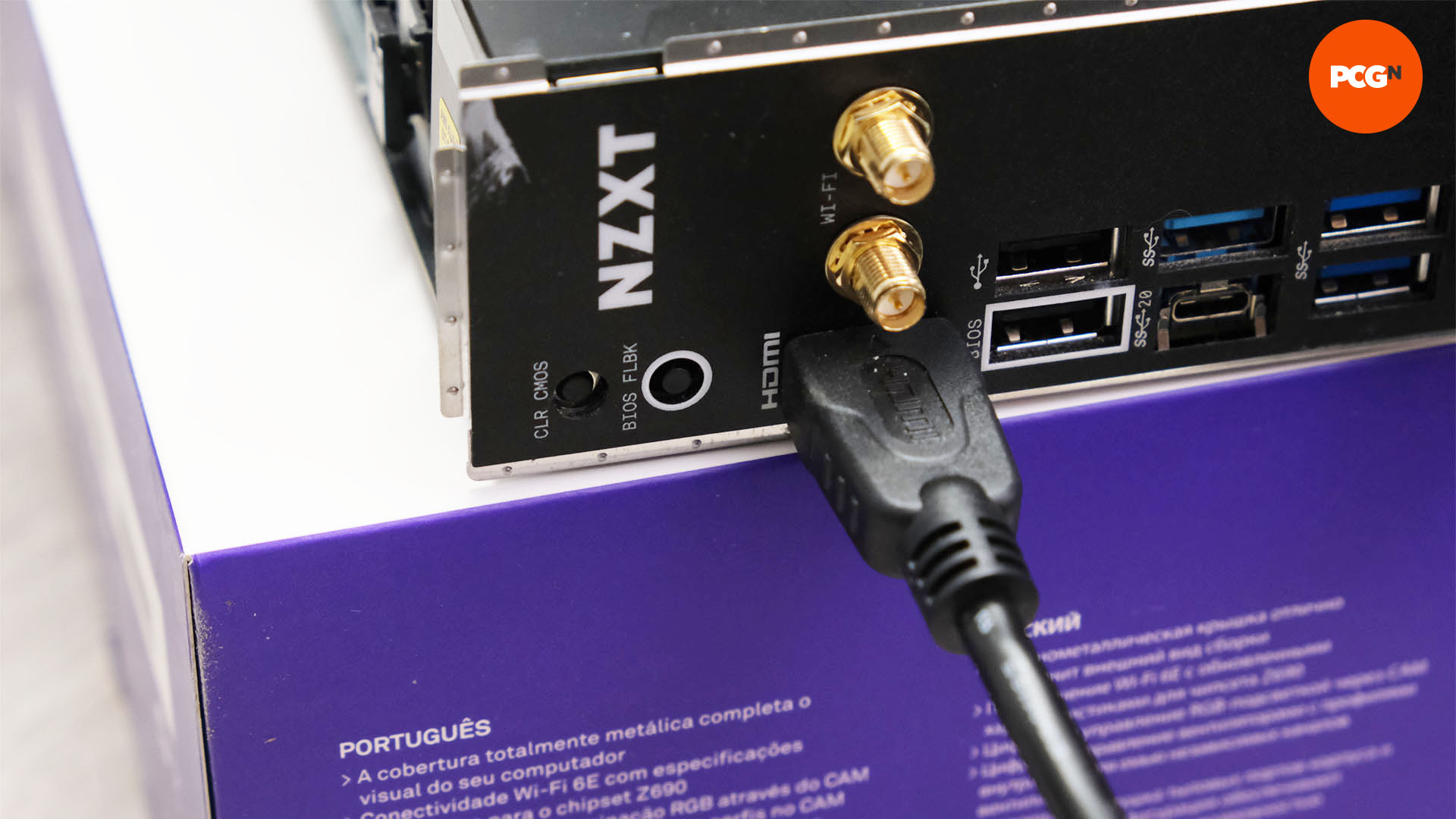
Your reminiscence may be at fault, nevertheless it’s extremely unlikely each sticks are lifeless. Take away one and place the opposite into the final slot in your motherboard, powering in your PC to see if the difficulty is solved, then do the identical with the opposite stick.
Your CPU, motherboard, and energy provide are harder to isolate, and also you’ll must borrow a suitable mannequin from a buddy or get them to check the parts of their PC. Alternatively, when you’ve got an area PC retailer, they’ll usually take a look at parts for a price. Lastly, it’s best to attain out to the retailer from which you bought the {hardware} and clarify that you simply suspect one part is defective.
12. Flash your motherboard BIOS
Motherboard releases usually coincide with the launch of a selected vary of CPUs, so the previous are programmed out of the field to help the latter. There might be updates to the motherboard’s software program mind, also called an EFI or BIOS, that repair sure points recognized after launch or enable it to carry out higher, however you’ll be able to assure that the motherboard will work with the era of CPUs with which it launched.
For instance, Intel’s present Twelfth-gen CPUs are all supported by 600-series chipset motherboards, similar to these with Z690 and B660 chipsets. Nevertheless, Intel plans on releasing its Thirteenth-gen CPUs this 12 months, and it’s probably that motherboards on the market in the mean time gained’t help them out-of-the-box, and can as an alternative want their EFI to be up to date. This similar subject applies to utilizing previous AM4 motherboards with AMD’s newest CPUs.
The issue arises when you purchase a brand new or second-hand motherboard and attempt to mix it with a CPU that’s bodily suitable however not supported by the EFI at present put in on the motherboard. If this occurs, you’ll probably be met with a black display screen and an successfully ineffective PC.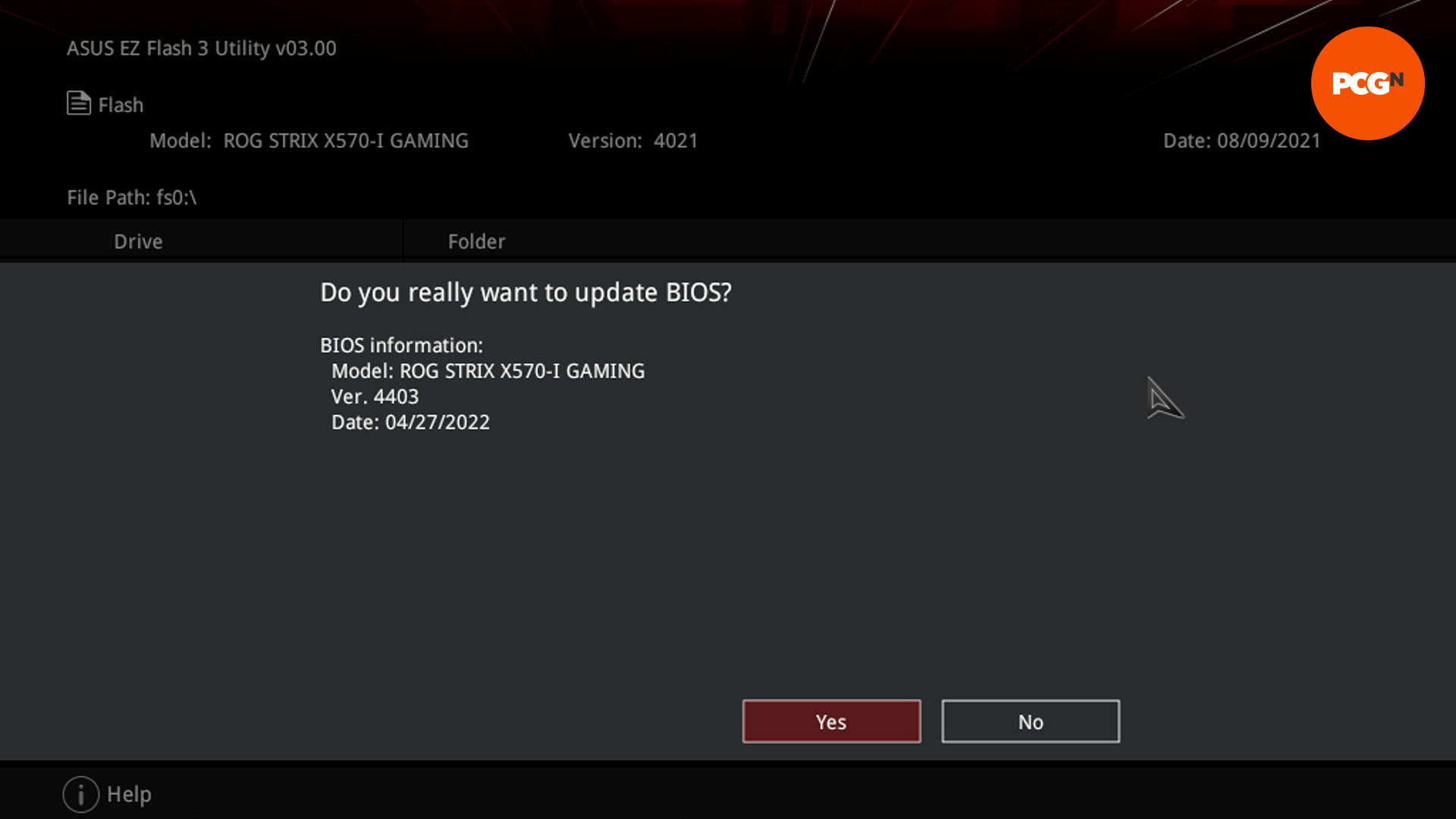
If this occurs, you must replace the motherboard’s EFI. There are two methods you are able to do this. You’ll be able to borrow an older CPU from a buddy to fireside up your PC, set up the most recent BIOS, after which drop in your new CPU. Alternatively, you’ll be able to replace the BIOS utilizing a extremely helpful characteristic often called BIOS flashback.
This can be a characteristic included with some, however not all motherboards, and it lets you replace the EFI with no suitable CPU. Actually, you don’t even want a CPU to be put in within the motherboard. Each motherboard producer has a barely totally different means of going about it, but when your PC fires up, there’s nothing on the display screen and also you’ve checked all of the cables, subsequent examine if the processor was launched similtaneously the motherboard. If it wasn’t and the motherboard helps BIOS flashback, it’s properly value making an attempt the next.
First, you’ll want entry to a different PC – ask your pals if essential, then obtain the most recent EFI out of your motherboard producer’s web site and unzip the file if essential. This can be out there within the ‘help’ or ‘obtain’ part in your motherboard’s product web page. Be sure you go to the precise product web page. For instance, in case your motherboard is an Asus TUF Gaming Z590, however you attempt to obtain the EFI for the Asus TUF Gaming Z590 WiFi, it gained’t work.
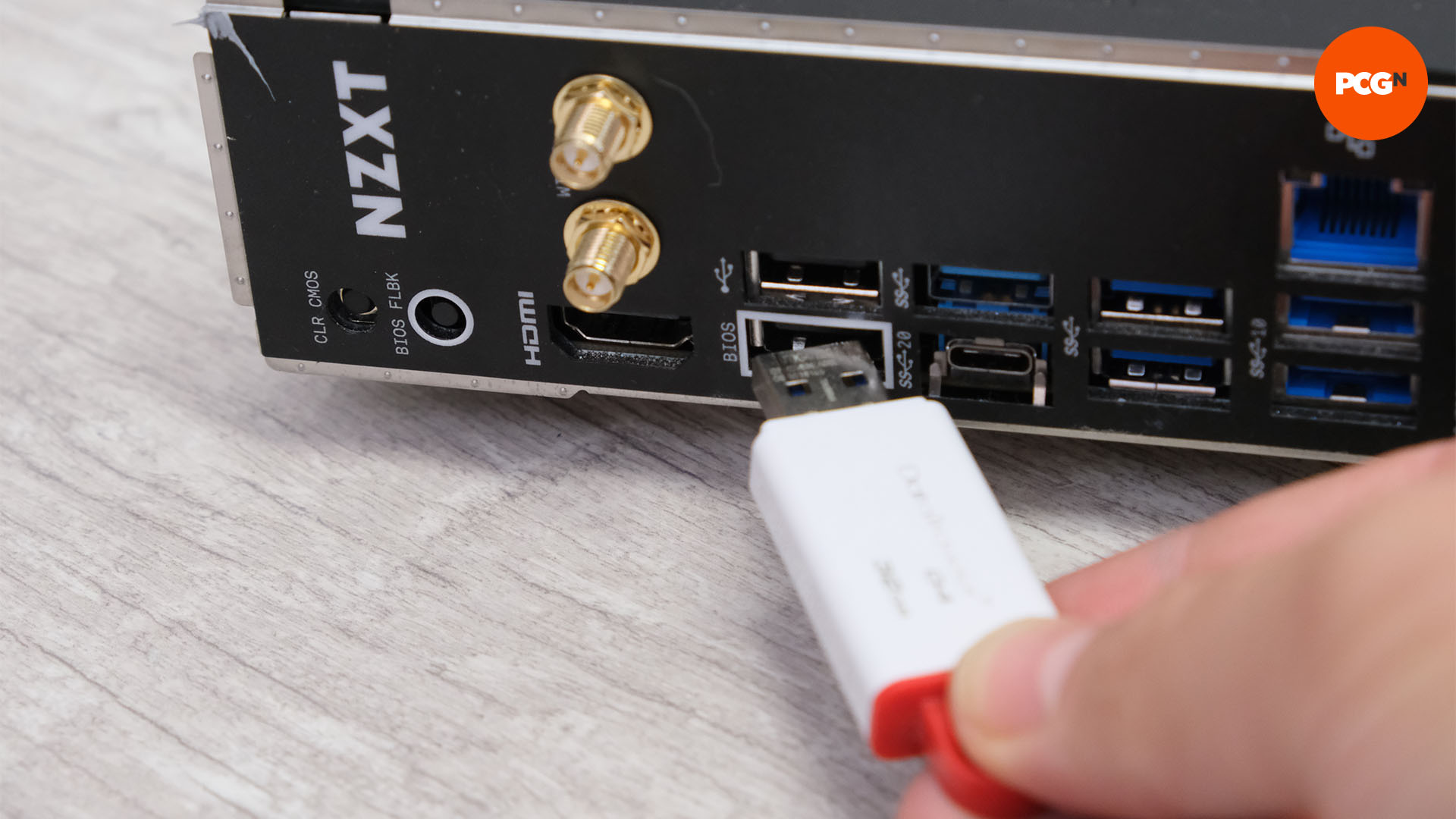
Subsequent, comply with the producer’s directions for putting the file onto a USB stick. For instance, MSI requires you to rename the BIOS file MSI.ROM, whereas Asus requires you to make use of a easy renaming program to permit your motherboard to see the file. It’s essential to comply with this recommendation step-by-step, and likewise make sure the file isn’t in a folder on the USB drive.
Subsequent, find the USB BIOS flashback port in your motherboard’s I/O panel. In the event you’re unsure about its location, check with the handbook. Now comply with the subsequent step within the replace information, which is often to attach the USB persist with the BIOS flashback port, guarantee the ability cables are related to the motherboard, swap on the PSU after which press the BIOS flashback button.
There’s usually a lightweight close to the button that may flash, displaying you the assorted levels of programming the EFI – after a couple of minutes the method can be full. If an previous, incompatible BIOS was stopping your PC from working correctly, then you definitely’ll know immediately, as powering it on will now convey up a show and assist you to get into the EFI. You may as well take a look at our full information on the way to flash your BIOS for extra element right here.
13. Mount the PC in your case and tidy the cables
Plan your PC construct
We now know what goes the place, that our {hardware} works and we’re prepared to put in it into our case. Nevertheless, there are nonetheless some elements to think about earlier than you attain to your screwdriver. Begin by having a great take a look at your case and cables, and figuring out the place your wires must go.
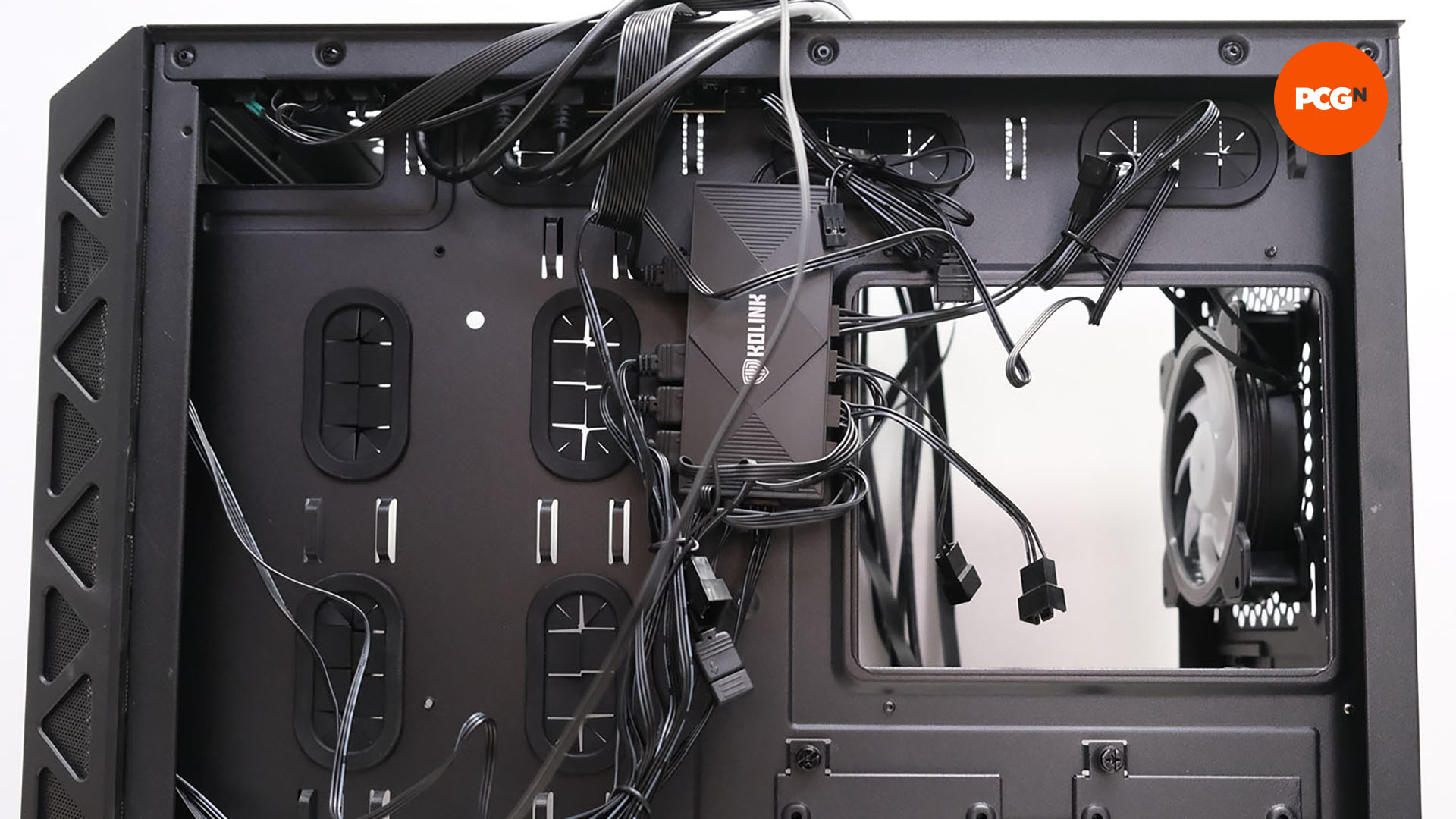
As soon as you already know which parts go the place you must work out the way to get the cables to and from all the fitting locations whereas minimizing litter. Your case can have cable routing holes conveniently positioned across the motherboard tray and elsewhere, enabling you to route cables cleanly out of your PSU to your parts with out trailing all of them throughout your motherboard.
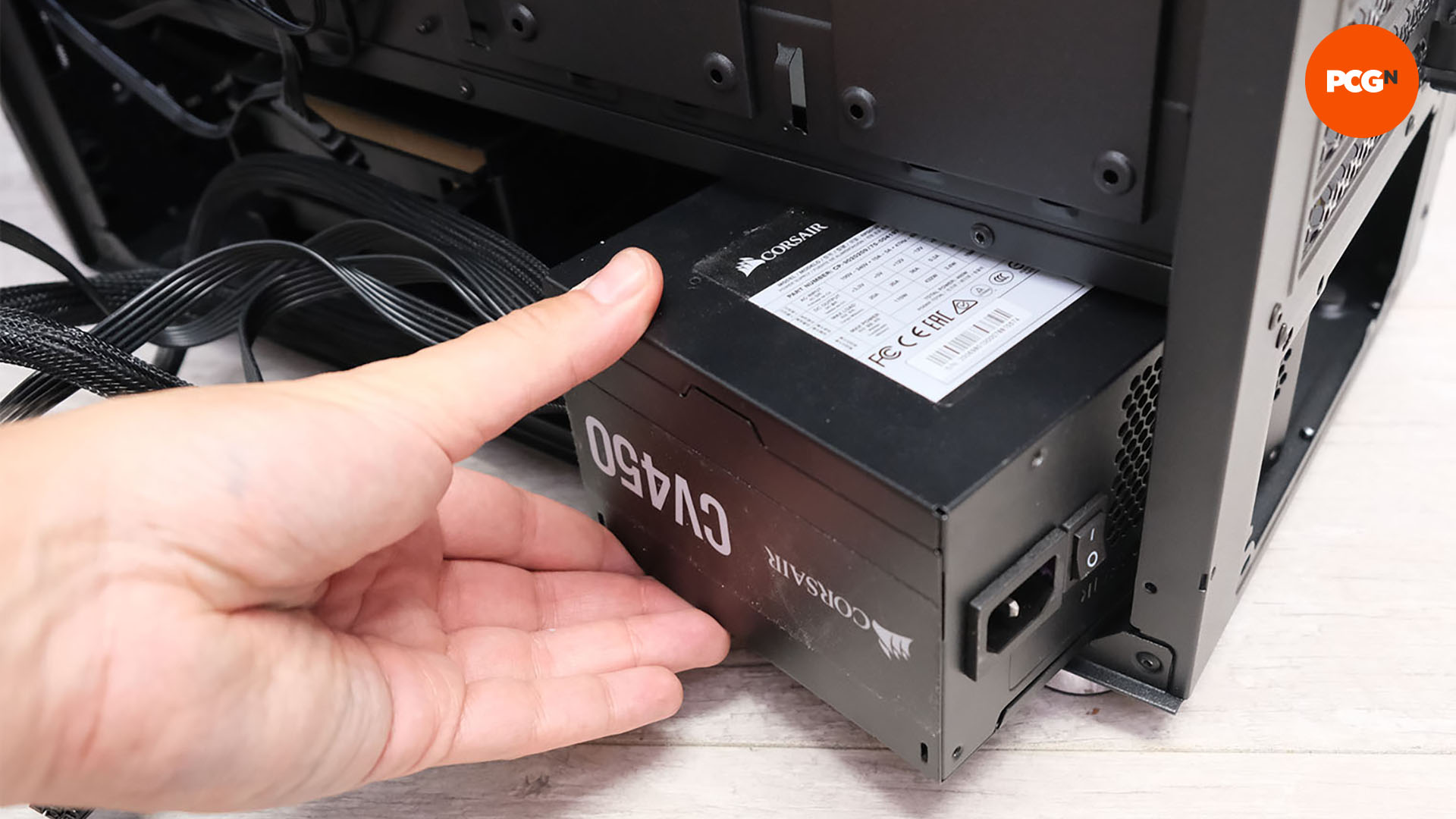
Match the ability provide
Most circumstances have only one PSU mount, however you’ll want to comply with your case’s handbook to examine whether or not the fan factors up or down.
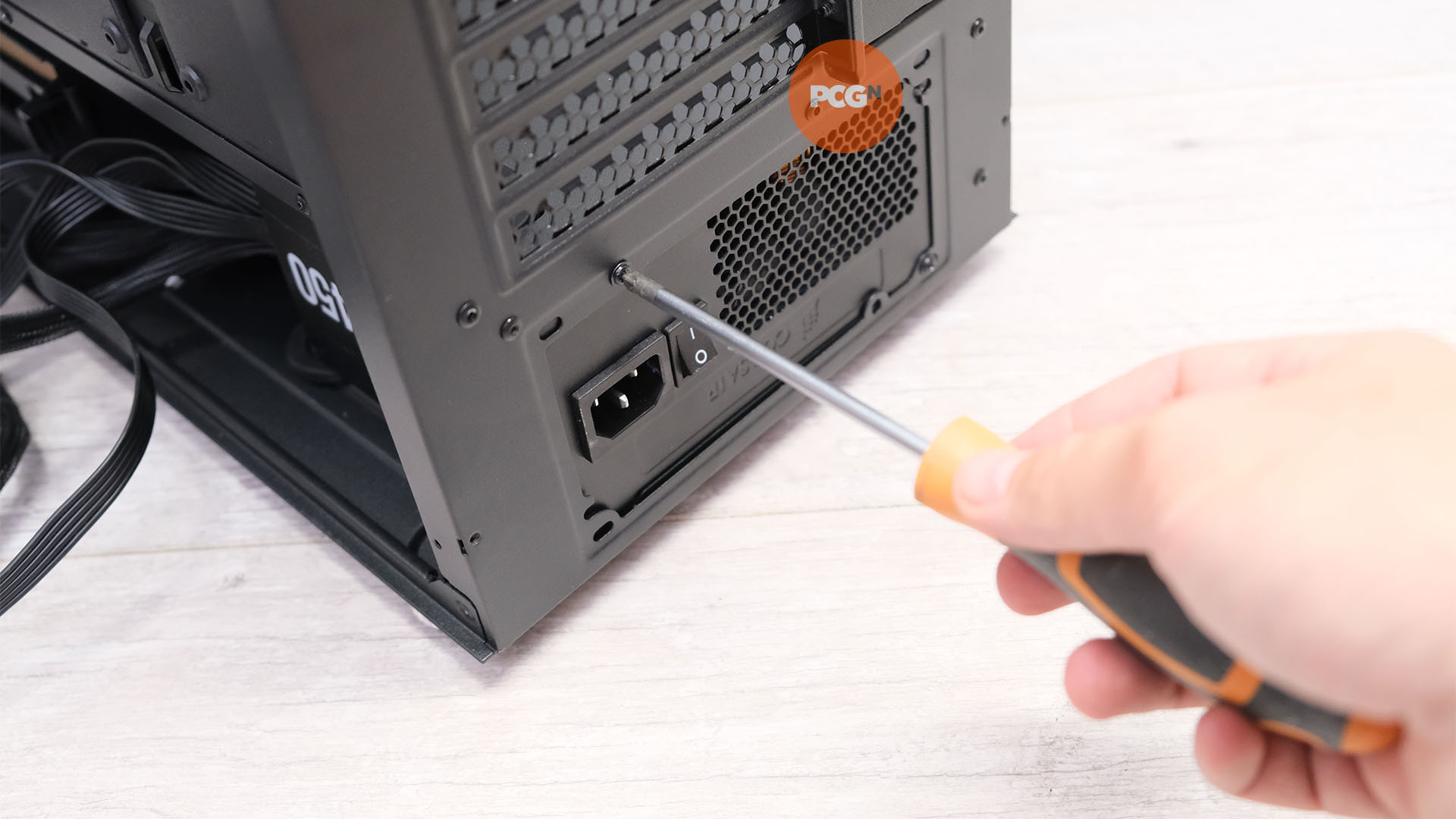
Feed the cables into the case after which safe the PSU to the mount. Modular PSUs have removable cables, permitting you to take away these you don’t want to avoid wasting house.
Set up the motherboard
Prior to installing the motherboard, examine that there are standoffs put in in your case’s motherboard space. These are small metallic pins that help the motherboard in particular places, elevating it off the motherboard tray beneath and stopping it from short-circuiting.
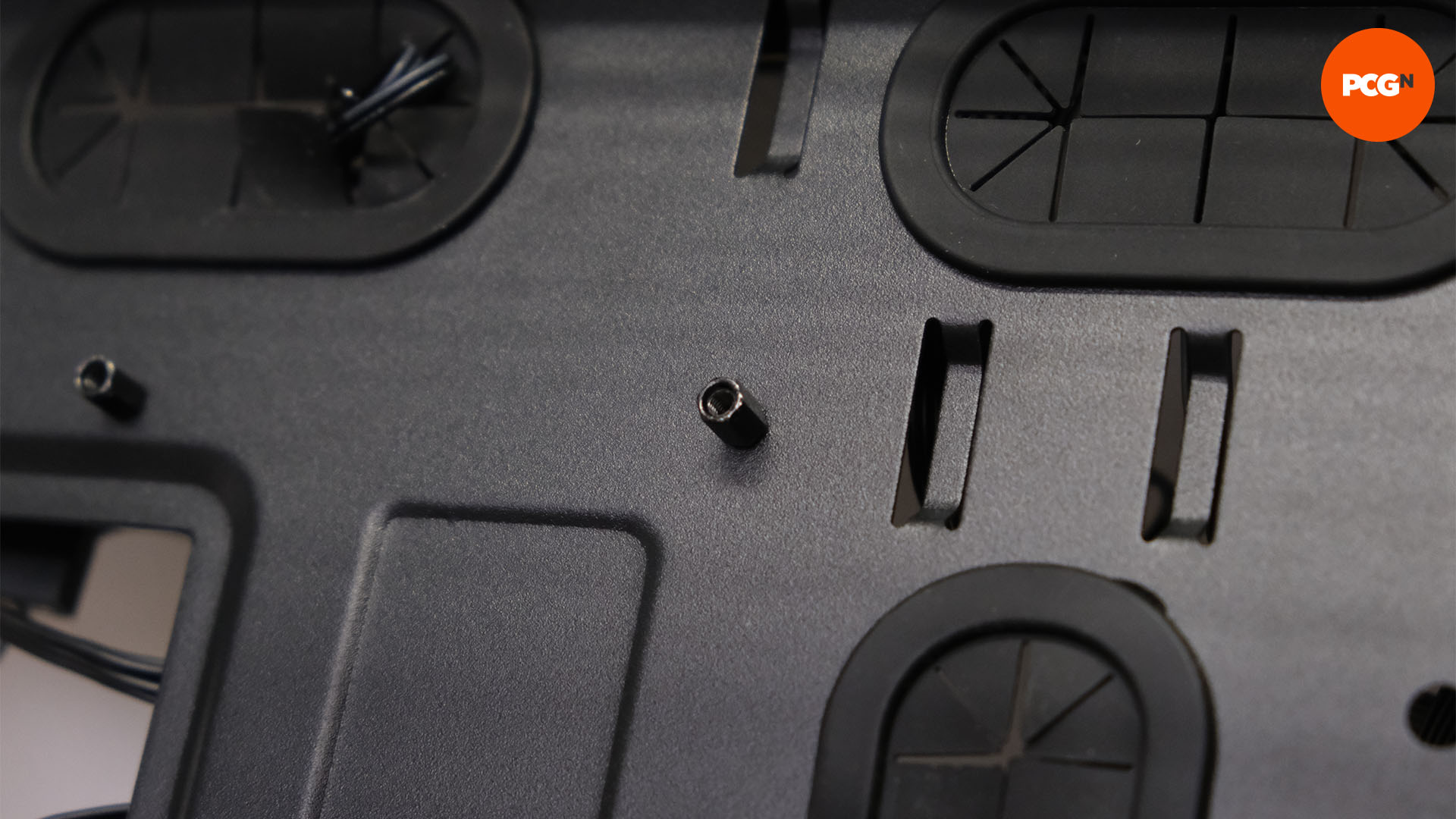
These are often put in out of the field, however sometimes you must screw them your self, so examine the case’s handbook to work out if you must do that, after which line up the standoffs with the screw holes in your motherboard.
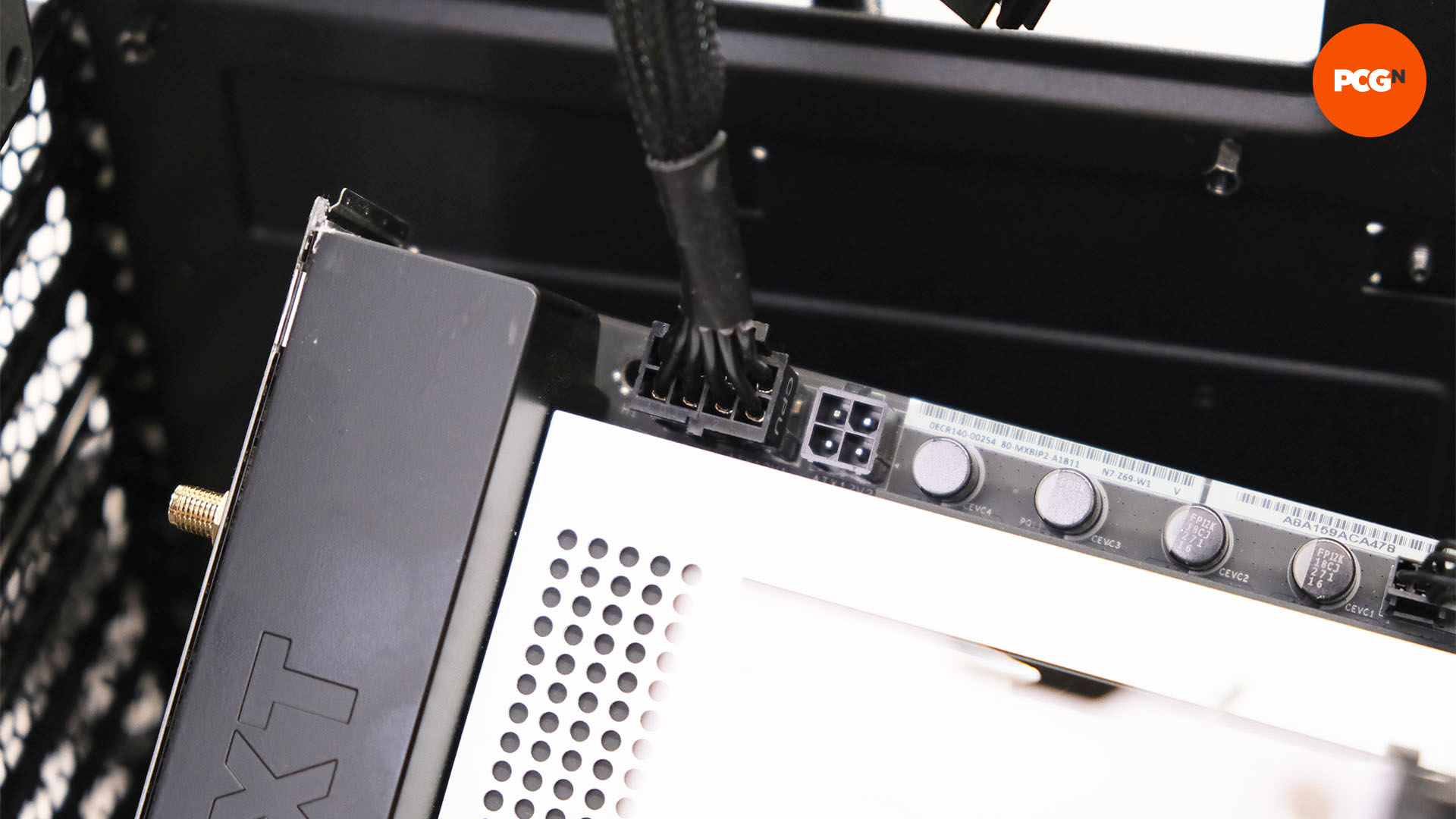
It’s a good suggestion to put in some cables earlier than you decrease the motherboard into the case. One in all these is the 8-pin EPS 12V connector. Route this from the PSU, across the again of your case’s motherboard tray, to the cable-routing gap on the prime of the case, after which pull it out of the outlet by just a few inches. Then decrease the motherboard into the case and join the cable to the connector.
Now is an efficient time to attach your case’s entrance panel cables to your motherboard’s entrance panel header, which can be a lot simpler earlier than the motherboard is fitted into the case.
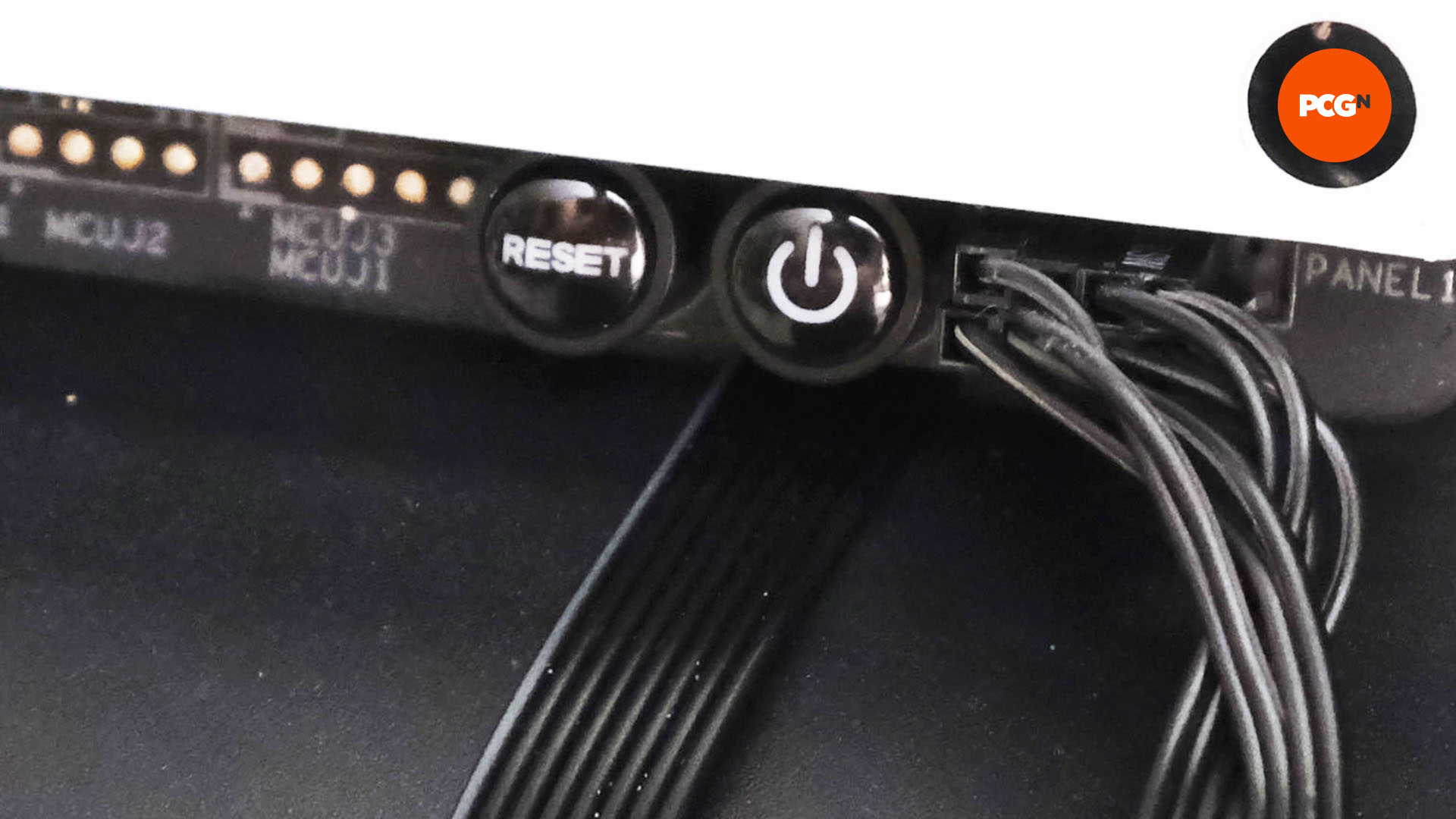
Run them behind the motherboard tray and out of a gap beneath the motherboard space, earlier than hooking them as much as the right headers, which can be detailed in your motherboard handbook. Nevertheless, in case your case’s cables aren’t lengthy sufficient, you could have to attend till the motherboard is inside your case earlier than you are able to do this.
The ultimate step earlier than putting in your motherboard is to put in the I/O defend. Most motherboards have these built-in today, however some nonetheless have separate shields that you simply’ll want to put in your self. This can be included with the motherboard and sits across the rear ports to stop mud ingress and supply an earth.
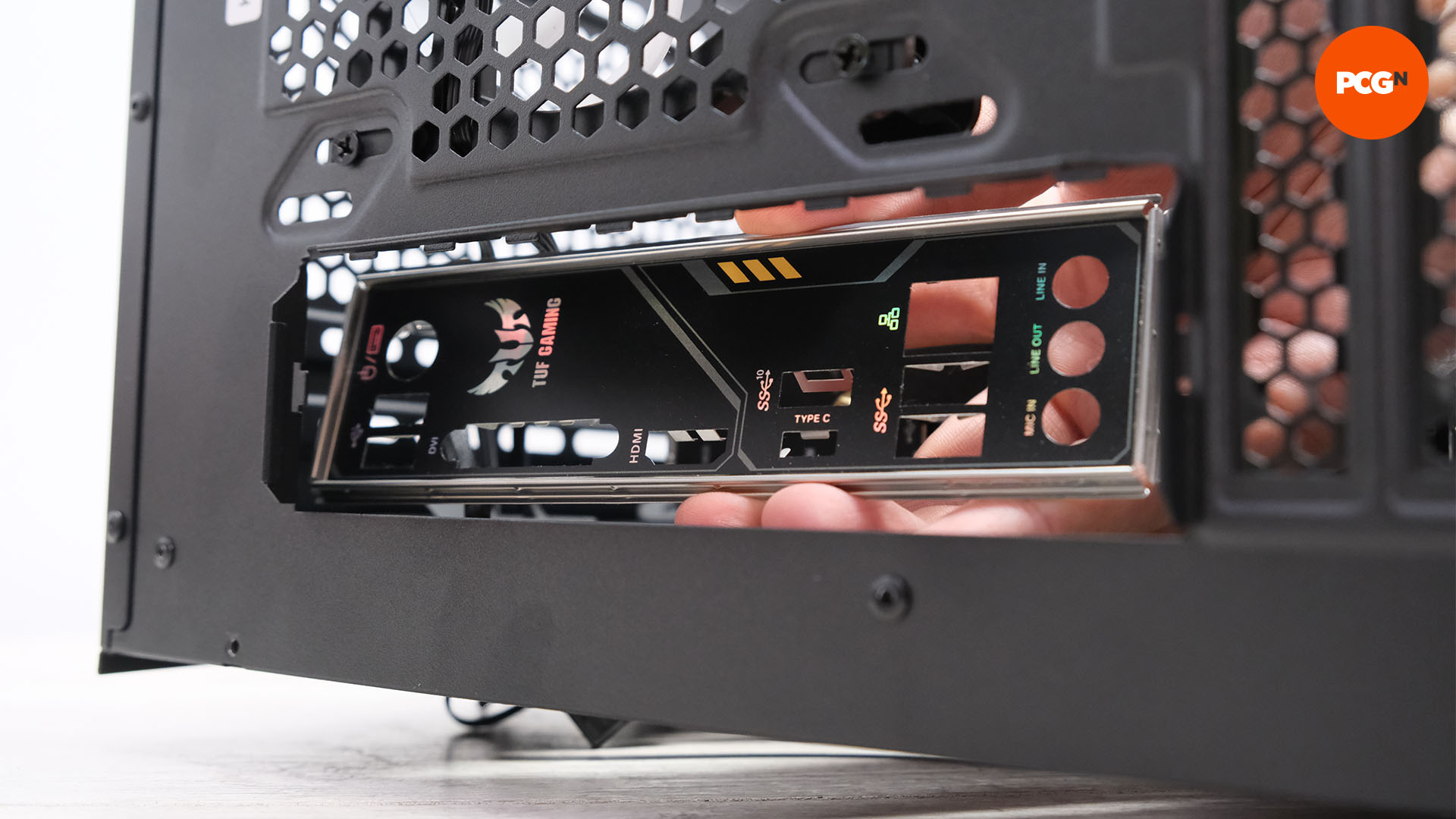
Line up the defend with the rear of the motherboard and its ports, then place it into the I/O panel cut-out within the rear of the case. This could take some persuasion, however it would match into place finally.
Lastly, gently decrease the motherboard into place in order that the I/O panel is a centimeter or so out from the I/O defend then transfer it throughout in order that its mounting holes line up. Watch out to not let the motherboard scrape towards the standoffs, as they will harm the PCB traces. As an alternative, raise the motherboard barely earlier than shifting it throughout.
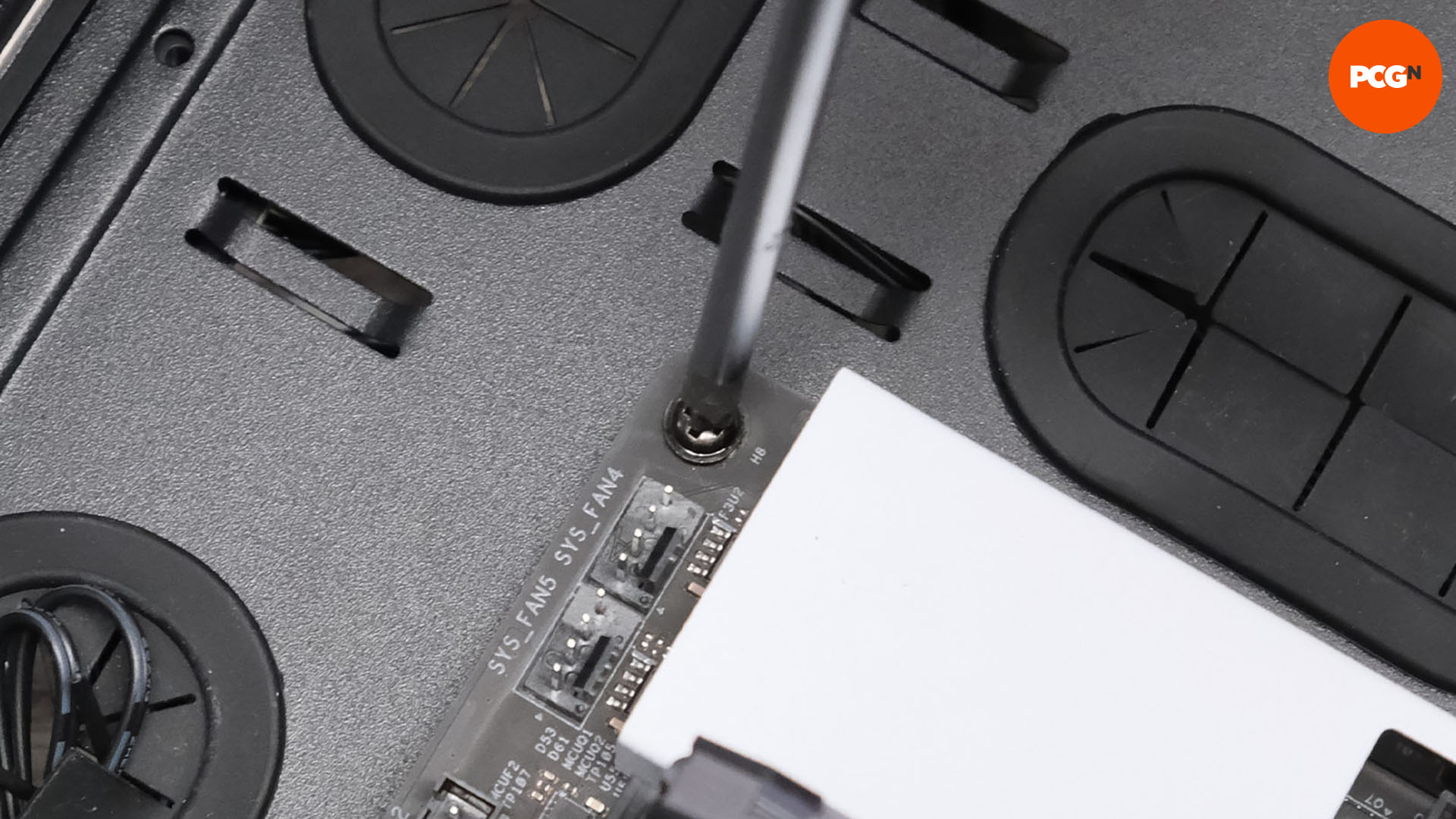
Now you should use your case’s motherboard screws to safe the motherboard. Be sure you use all of the out there mounting factors and have the case sat flat, so the motherboard isn’t left dangling vertically.
Set up SATA drives
Your case will in all probability have mounts for each 3.5-inch exhausting disks and a pair of.5-inch SSDs, so examine your case’s handbook to see the place these mounts are positioned.
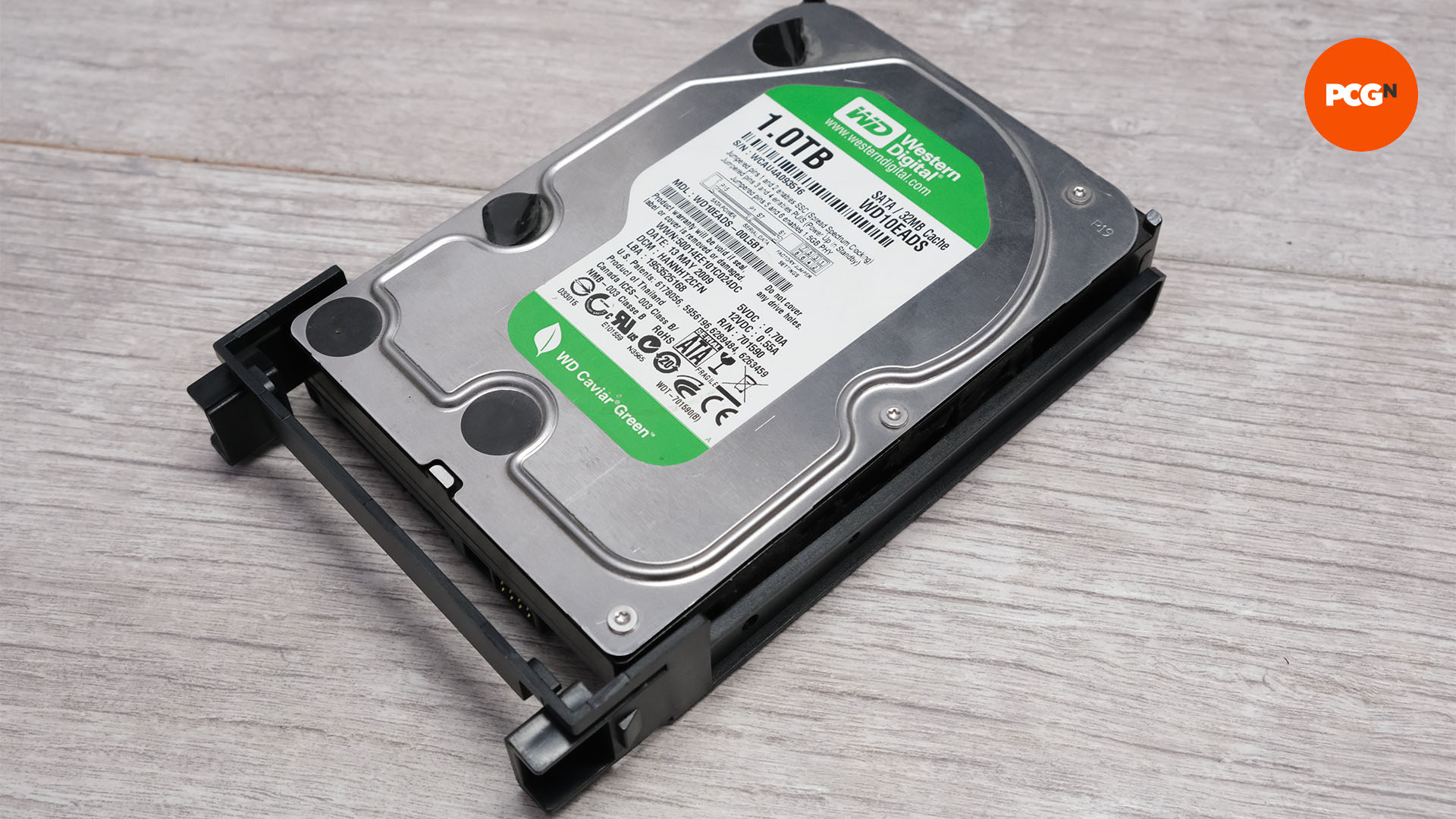
In terms of 3.5-inch exhausting drives, you often need to screw a mounting system to the perimeters of your drive, so as to simply slide it out and in of the drive bay.
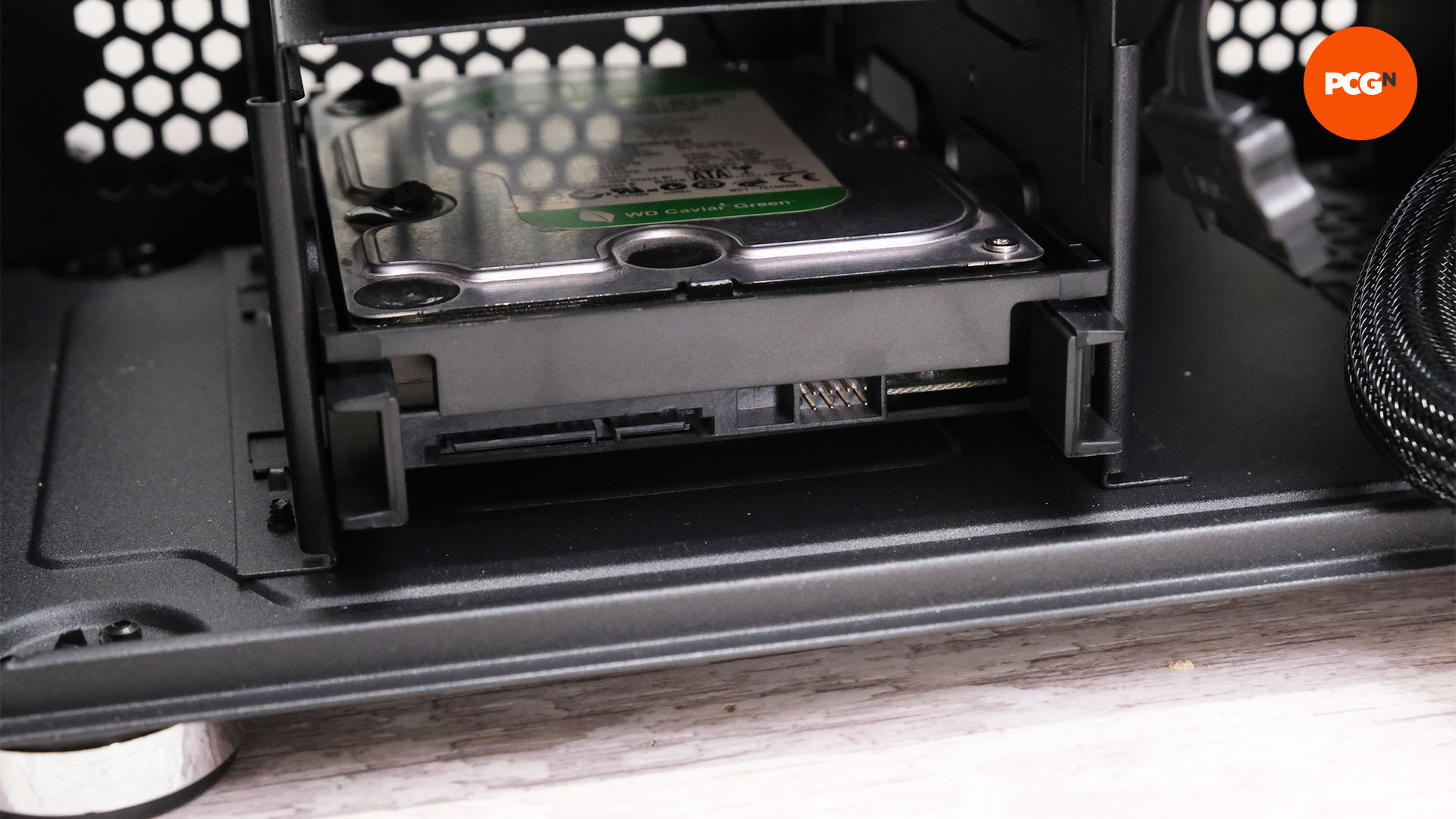
The tip with the connectors almost all the time wants to sit down dealing with the motherboard tray facet of the case, so cables might be routed out of sight and the drive might be simply eliminated, usually by sliding it out. Attempt to mount your drives as near your motherboard’s SATA connectors as attainable, as this will provide you with a better time when cable tidying.
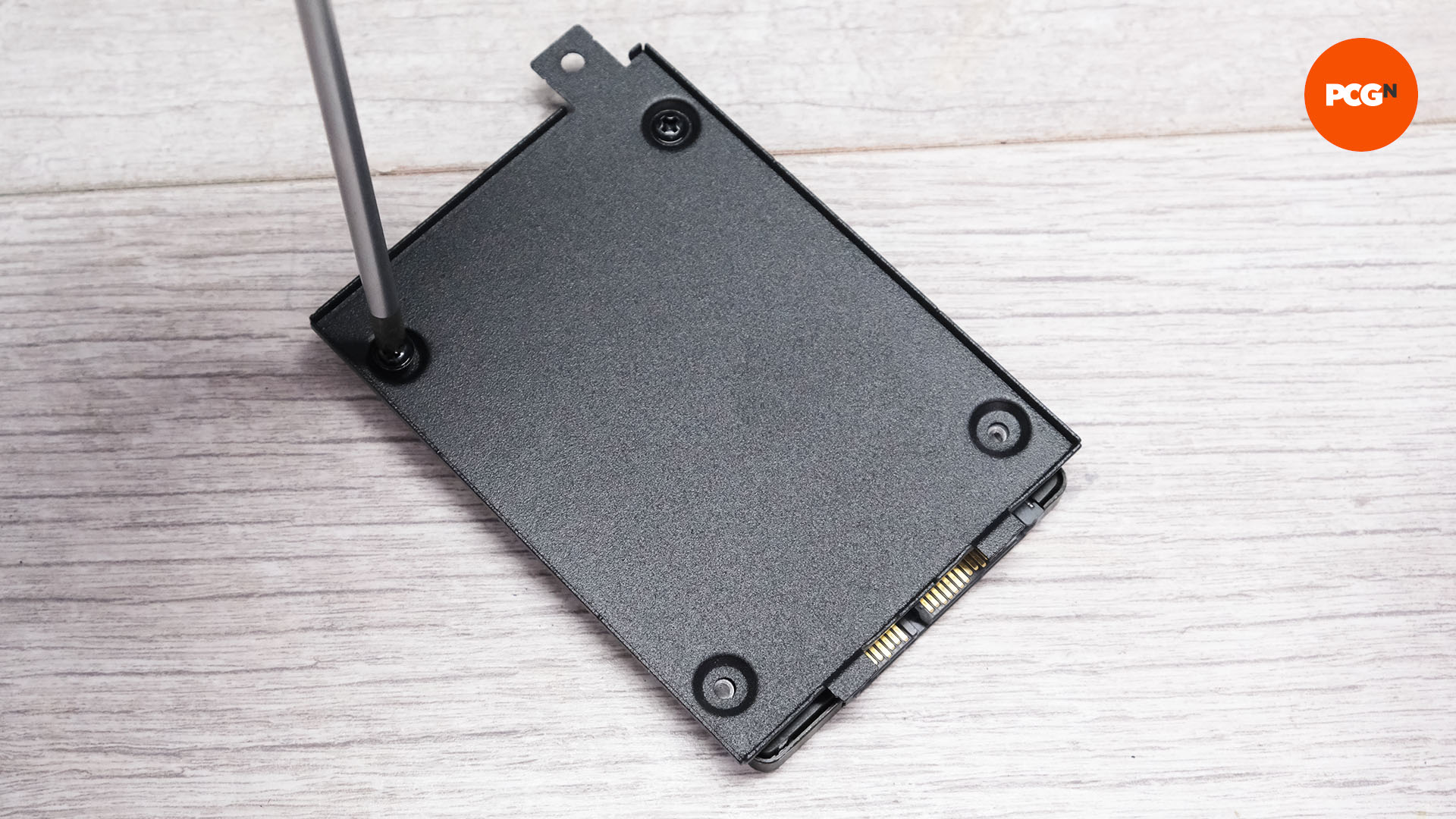
SSDs are extra versatile than 3.5-inch exhausting drives and have mounts in all method of positions, however they’re often secured to the mount utilizing screws in both the perimeters or underside of the drives.
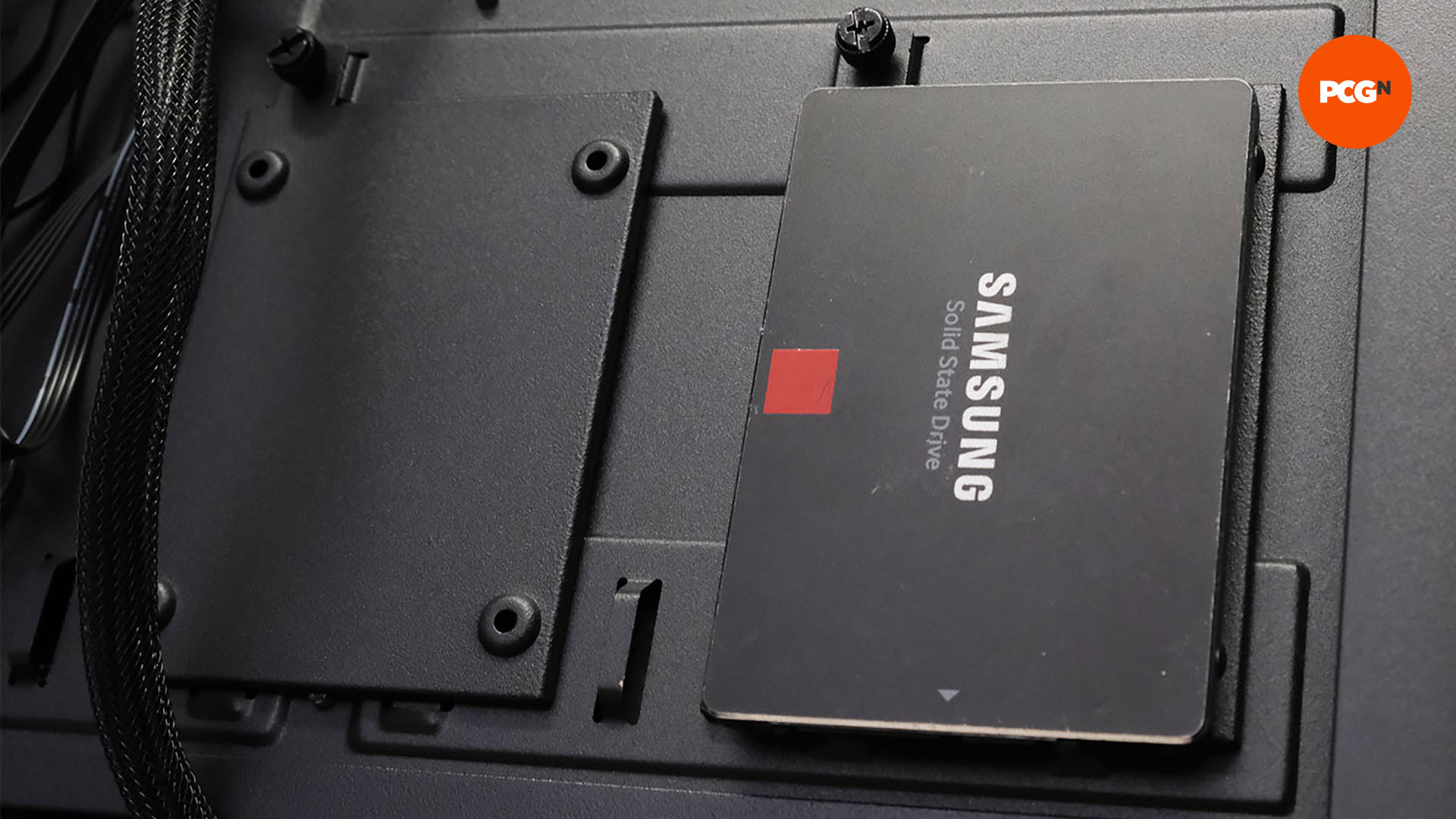
A number of circumstances have 2.5-inch SSD mounts behind the motherboard tray, which is our most popular location for them, because it retains the drives out of sight and makes cable tidying straightforward.
Take away enlargement slot covers
To stop mud ingress, your case’s rear slots, the place the rear panels for PCIe enlargement units similar to graphics playing cards sit, are lined by blanking plates.
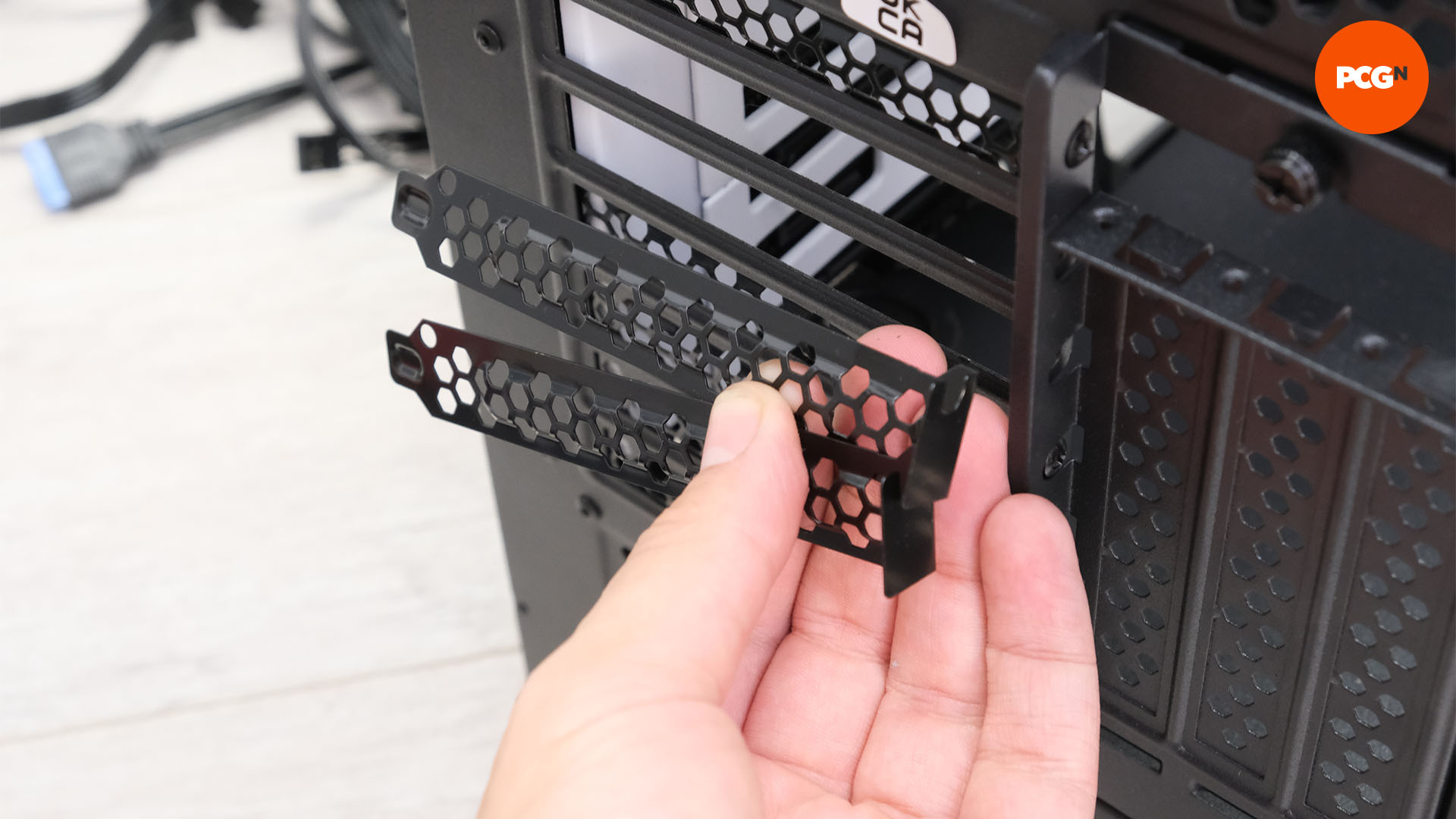
You’ll must take away those that sit the place your graphics card must go, as it would have its ports and cooling vents there. These often unscrew and slide out, however sometimes you’ll must pry out metallic sections utilizing pliers – don’t use your fingers as they will get scraped.
Set up additional followers
You probably have any additional followers to put in, take a look at your case’s airflow out of the field and intention to enrich it. If there’s no rear fan, however there’s a fan mount, this is a perfect place for an additional fan, as are any vacant entrance fan mounts.
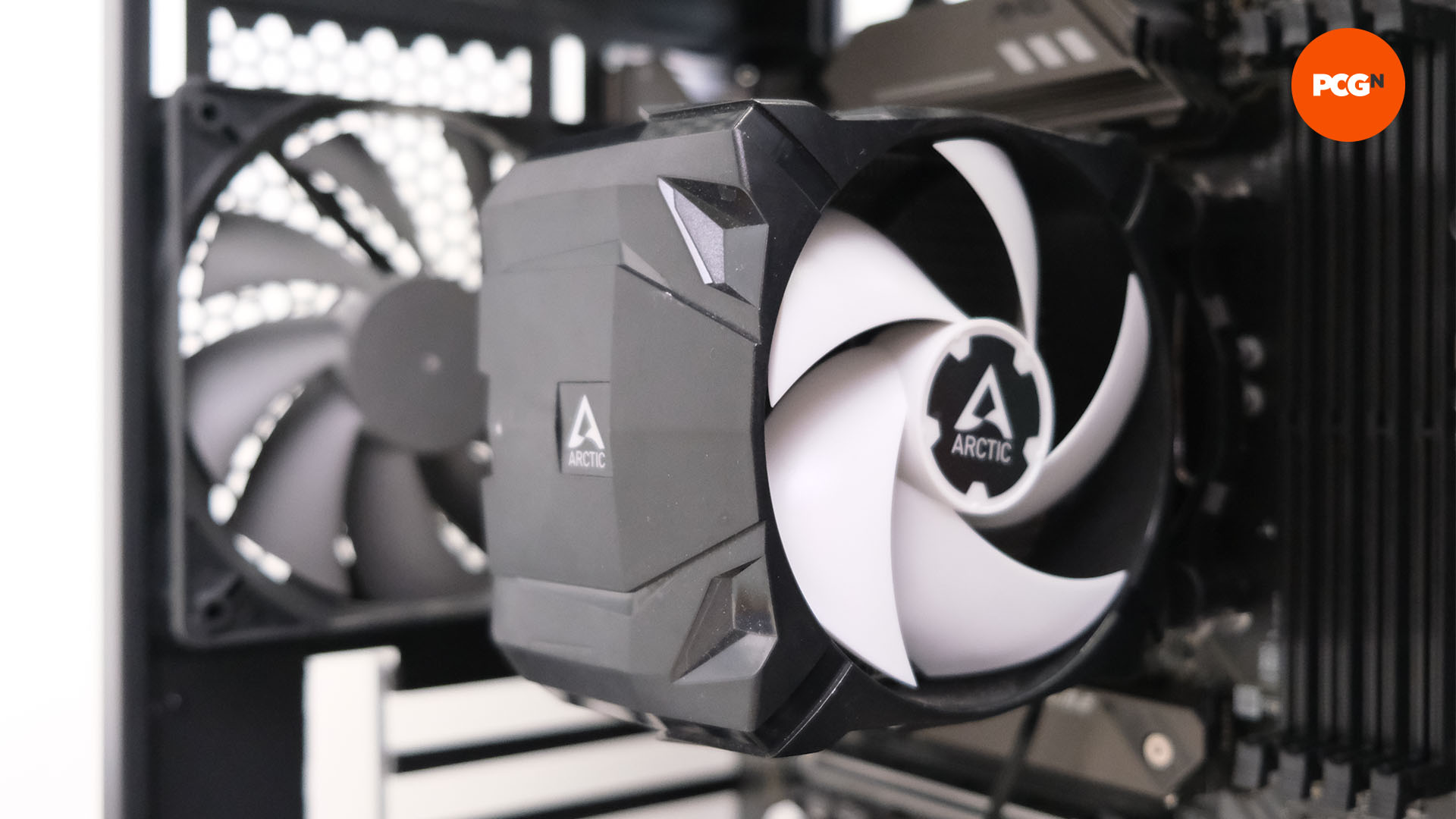
The previous needs to be put in so it’s consistent with your CPU cooler’s fan, whereas entrance followers are finest positioned, so no less than one is consistent with your graphics card, with most of its depth sitting beneath the cardboard to feed its cooling followers.
Tidy your cables
With all of your cables put in and related, it’s time to tidy them up behind the motherboard tray. This would possibly appear to be a waste of time, however a mass of spaghetti appears hideous and might truly hinder airflow and make your PC run hotter too, in addition to rising the chance of cables discovering their means into uncovered followers and blocking entry to parts.
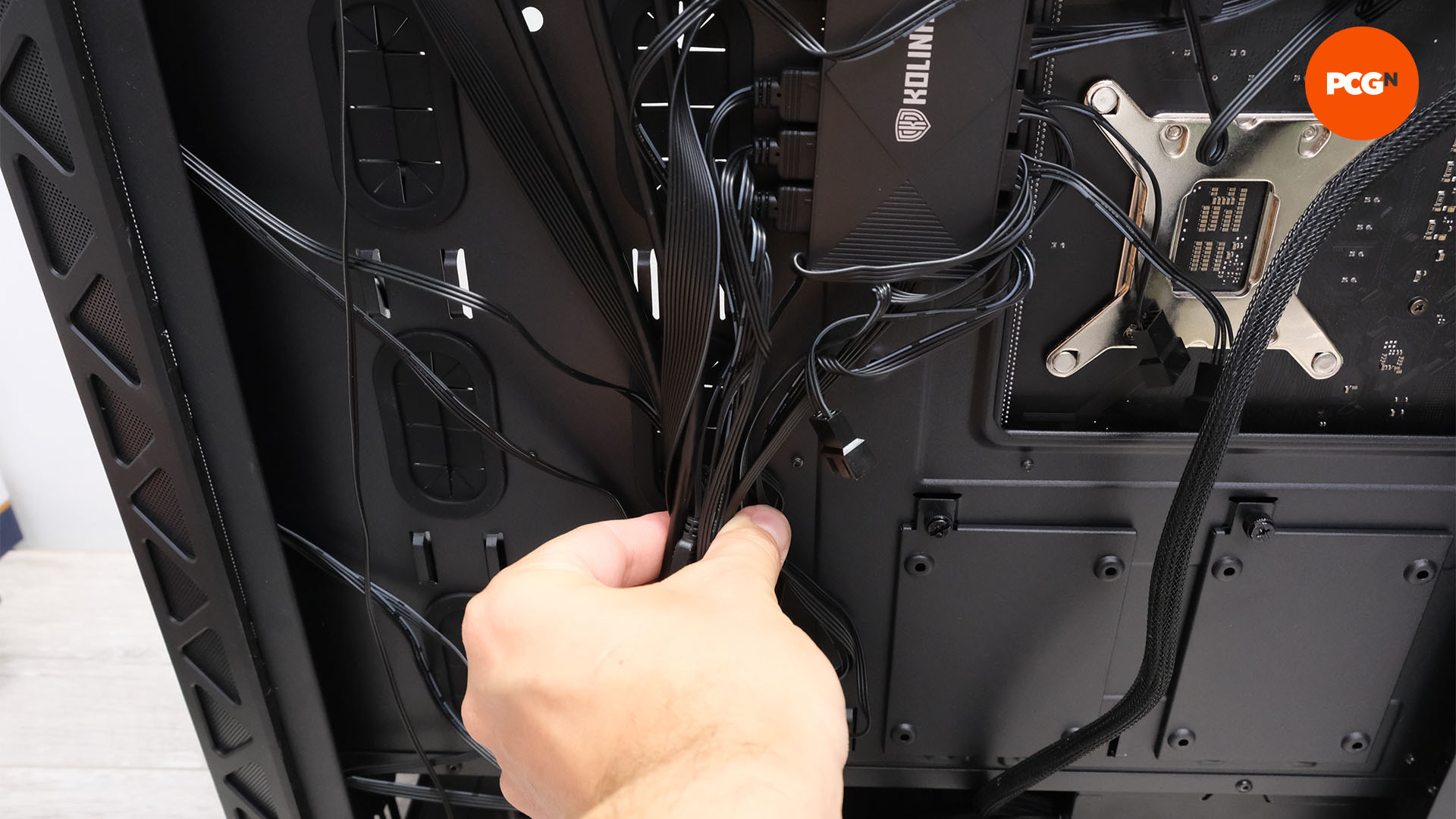
In case your case has any pure channels to which you’ll be able to anchor cables, undoubtedly use them, however the bottom line is consistency. Pull any slack from the motherboard space via the cable routing holes to the again, collect bunches of cables collectively, and do a take a look at match to see which anchor factors make sense and that are out of vary of some cables.
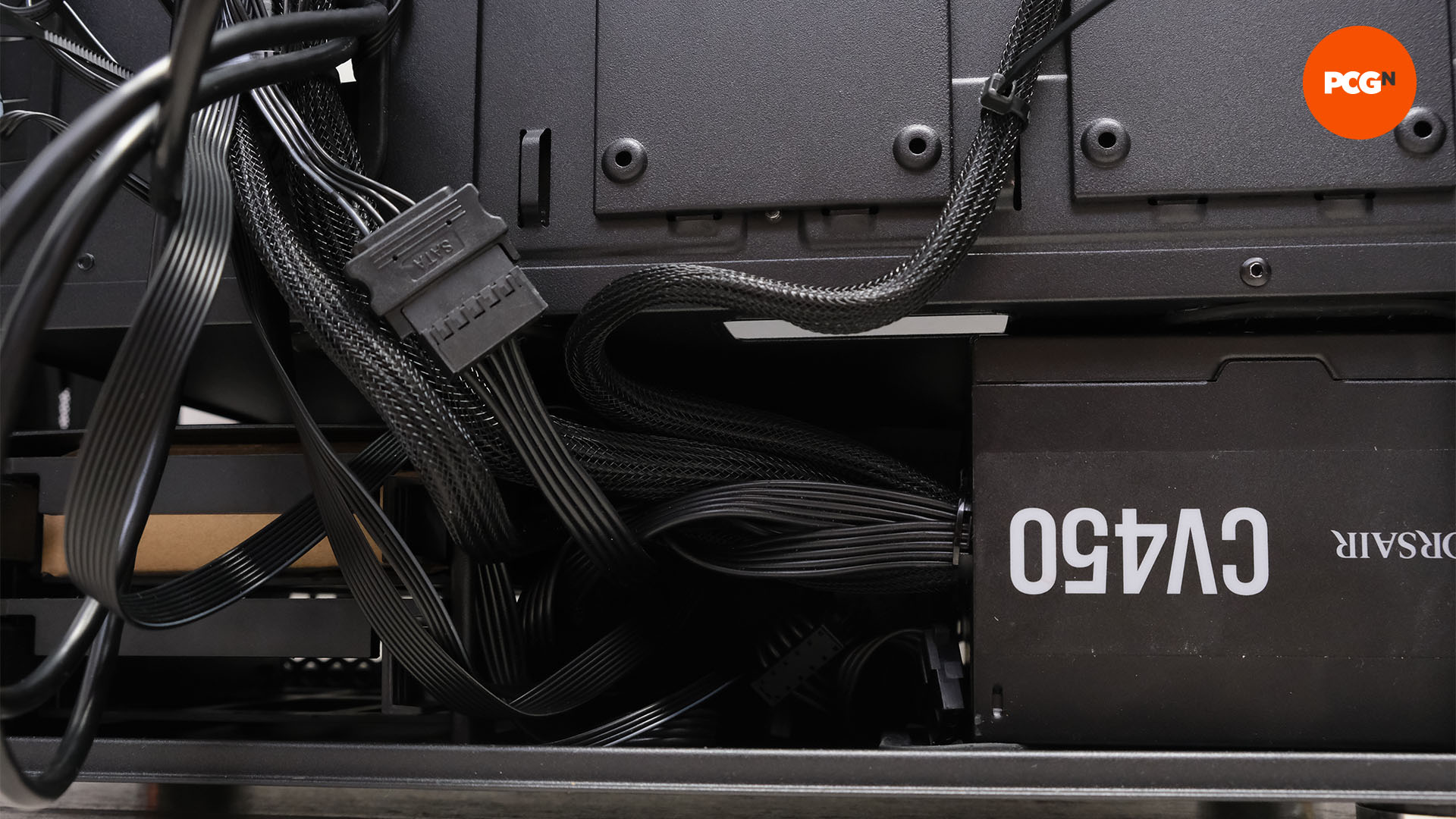
You’ll be able to then use cable ties to safe the cables in bunches to the case’s anchors. Run the ties beneath the bunches of cables, thread the cable ties via your case’s anchors, put the skinny finish of the tie via the buckle, and pull it tight. Don’t be afraid to collect giant bunches of cables collectively and stow them beneath the PSU cowl in case your case has one.
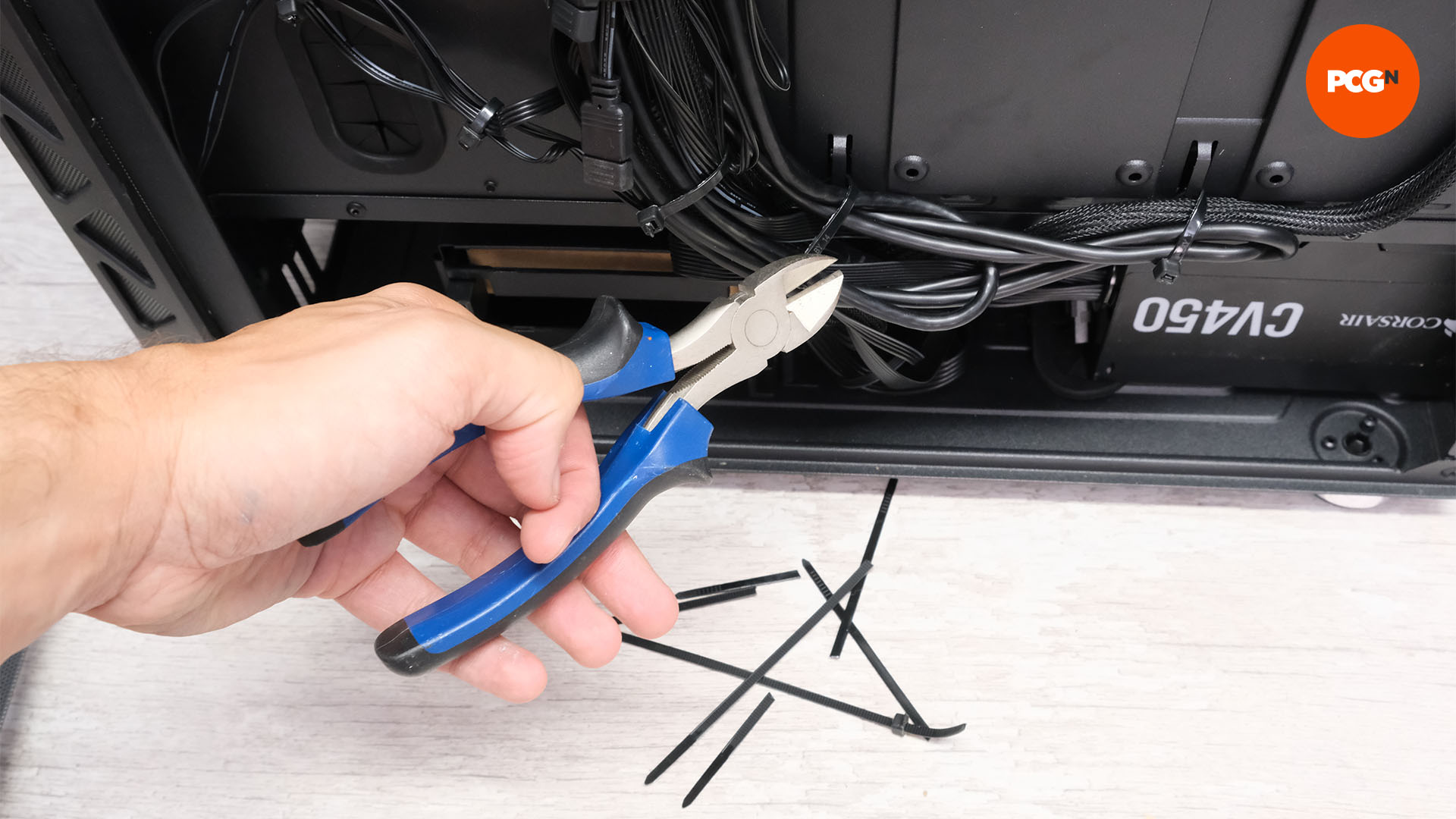
It’s going to have minimal impression on airflow down there and preserve all of it out of sight. When you’ve completed your cable tidying, it’s time to make use of your facet cutters to trim the ends, leaving a neat line of cable ties. Do not forget that you must put your case’s facet panel again, so attempt to preserve bunches of cables as flat as attainable, with out bulging outwards. Your cable tidying doesn’t must look immaculate, nevertheless it does have to be safe.
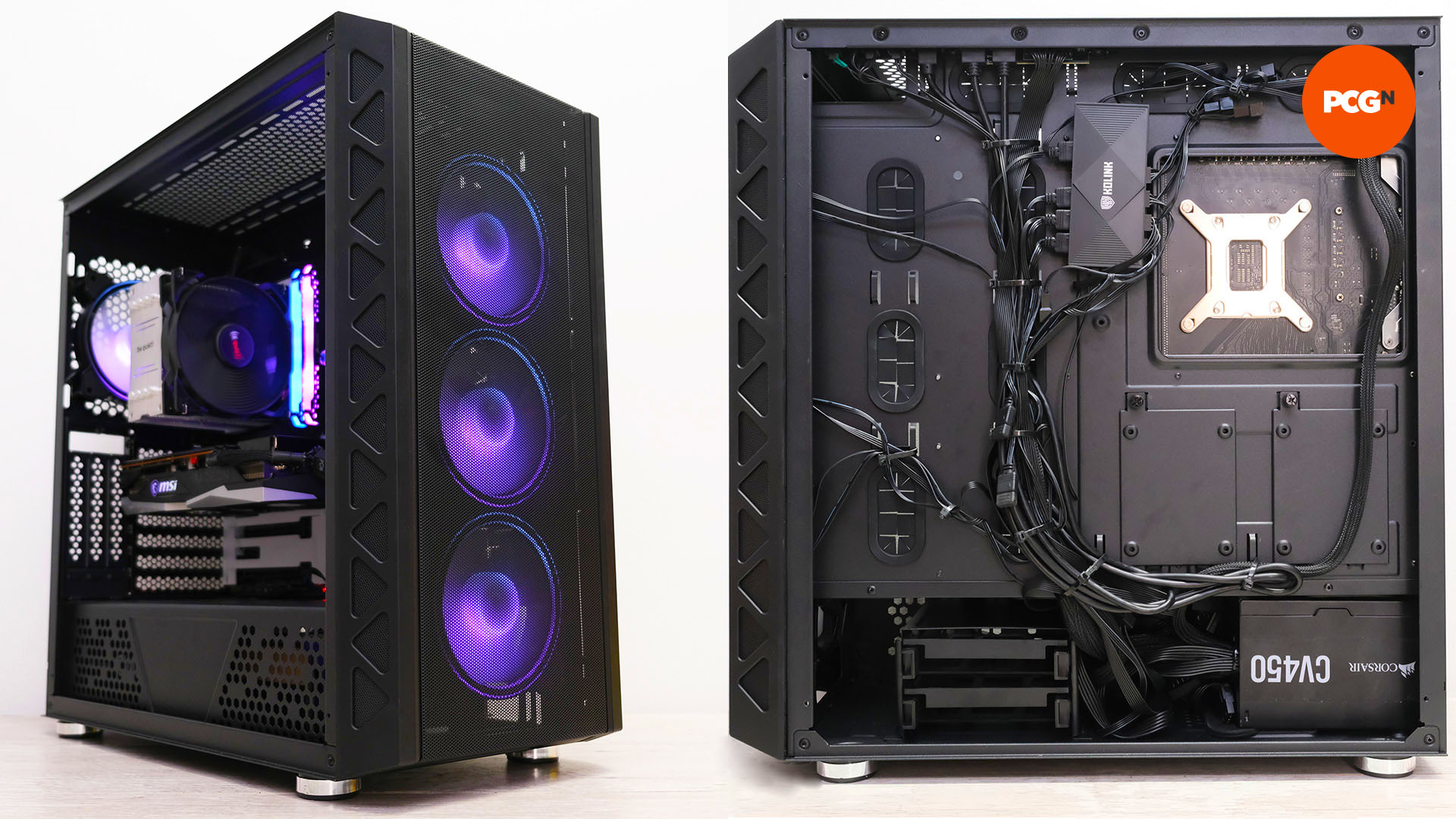
At this level, you’re principally accomplished with the {hardware} facet. You’ll be able to join your keyboard, mouse, and monitor, plug in an influence cable, swap in your PSU, and hit your case’s energy button prepared for the subsequent stage.
If it doesn’t fireplace up, double-check all of your energy cables, in addition to the cables for the case entrance panel – you already know your core PC works from the primary take a look at, so it needs to be straightforward to search out the issue.
14. Arrange your motherboard BIOS
Energy up your PC and hit the Del key to enter the EFI system so you’ll be able to carry out some remaining tweaks. First, head to the EFI’s fan management part and familiarise your self with it. If any followers in your case are annoyingly loud, you’ll be able to establish them and choose a much less aggressive pace profile, and even create your individual fan curve.
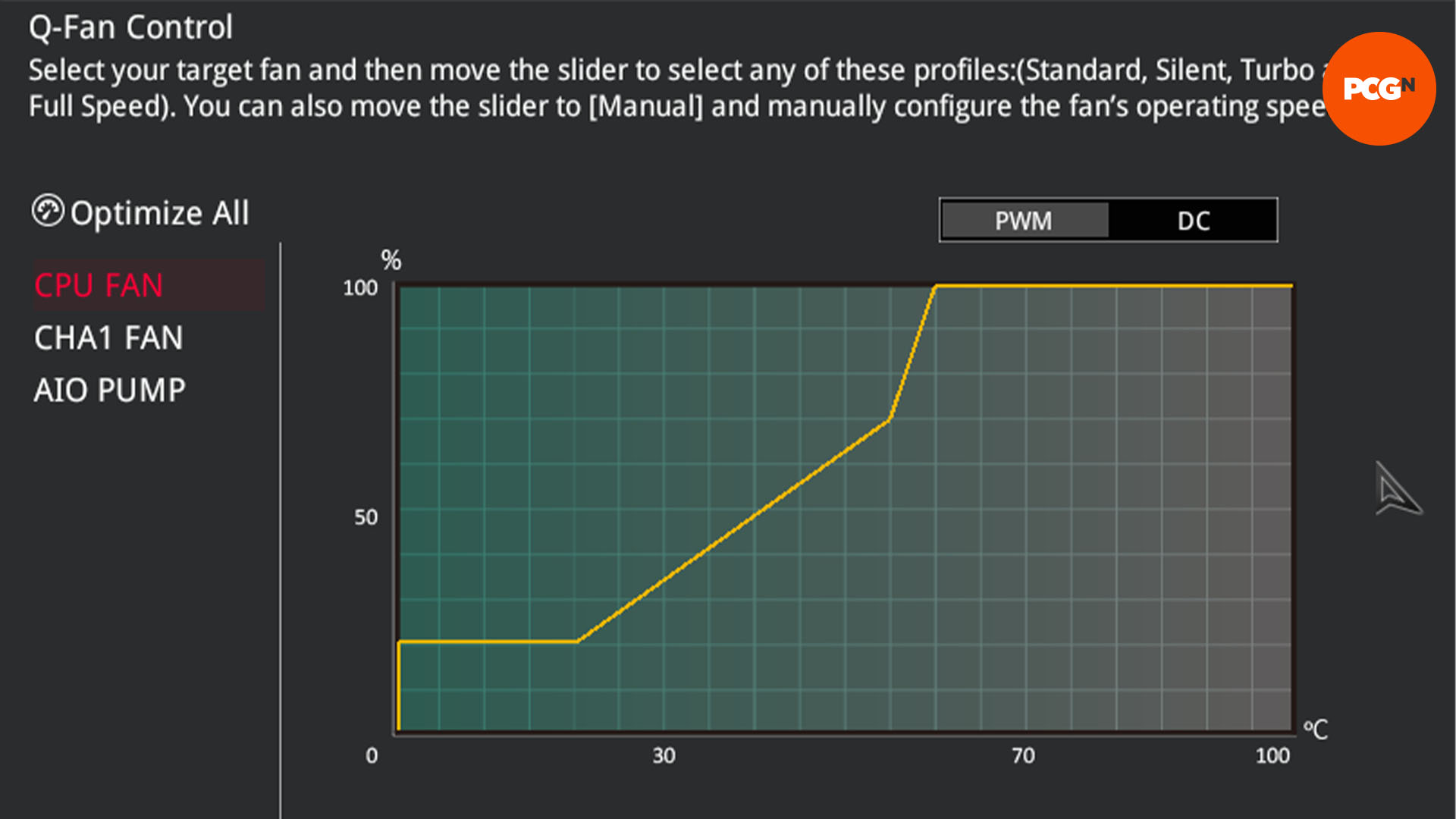
Watch out for limiting fan speeds an excessive amount of, although, as prolonged gaming periods on scorching days may see your PC stifled – all the time enable your followers to hit most pace in case your CPU temperature tops 90°C.
In case your graphics card helps Resizable BAR (known as Good Entry Reminiscence by AMD), you’ll want to make sure it’s enabled within the EFI as it may well enhance efficiency in some video games. That is positioned in other places relying in your motherboard producer. First, find the choice for CSM, which is often positioned within the boot menu, and disable it.
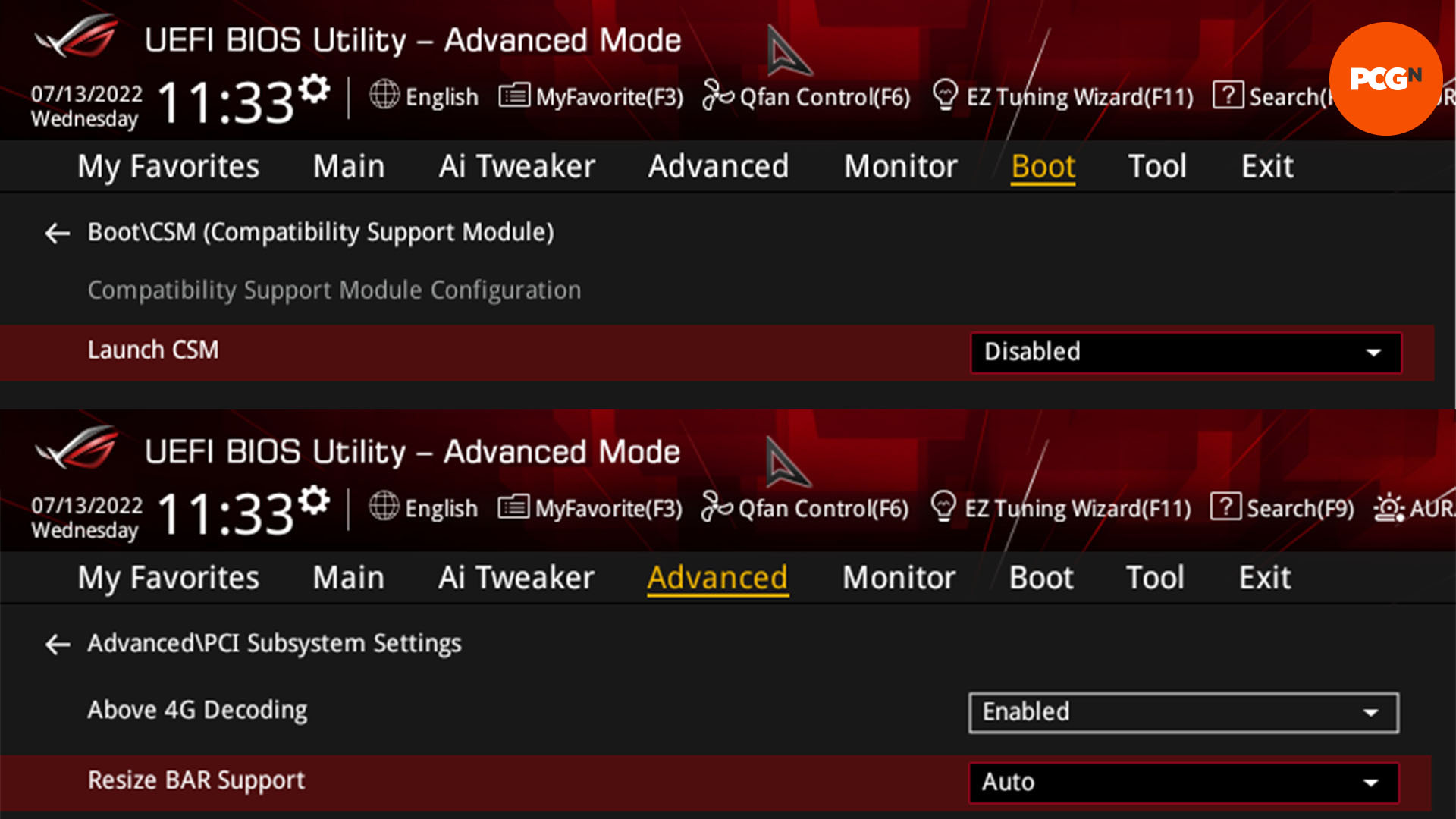
Subsequent, you must allow Resizable BAR. Gigabyte boards have the choice for BAR beneath the Settings menu, whereas Asus and MSI boards have it beneath the Superior tab in PCIe Subsystem Settings. ASRock motherboards put it within the Superior menu, and it’s generally known as Good Entry Reminiscence. When you’ve discovered it, allow it. Try our full information on the way to allow resizable BAR for extra element about this course of.
15. Set up Home windows
You probably have entry to a different PC or laptop computer, you’ll be able to obtain the Microsoft Media Creation Device software program, which lets you create a bootable Home windows set up USB flash drive and makes the method of putting in Home windows straightforward.
This device will seize the most recent model and assist you to set up the working system, that means you simply must get hold of an official license code to enter later. Your USB stick must have a capability of no less than 8GB, and the method will wipe all the pieces on the drive, so again up any information you need to preserve. 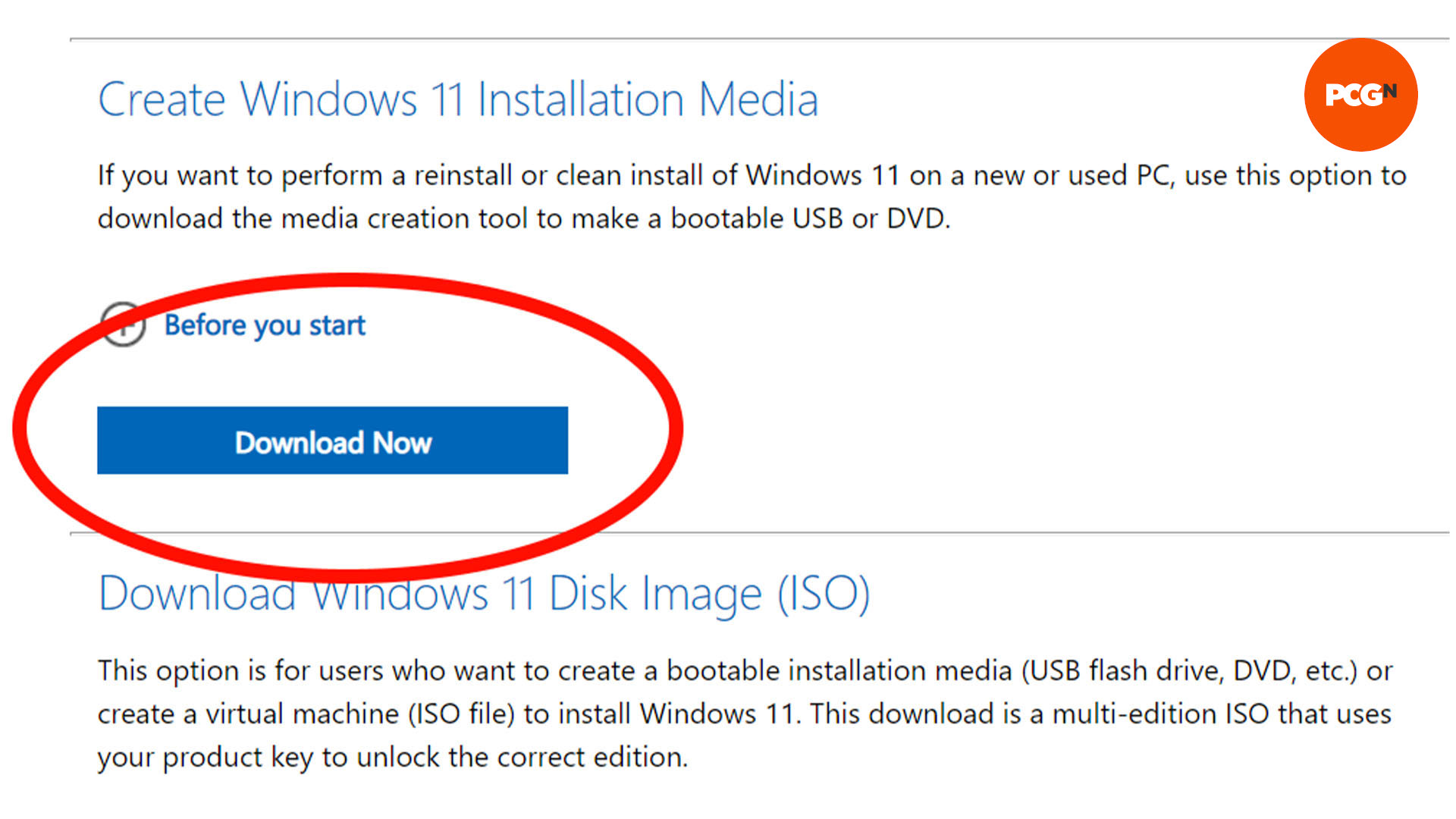
In the event you don’t have entry to a different laptop, however have already got a license for a real copy of Home windows, USB flash drives can be found on eBay pre-loaded with the identical installer for as little as $7. Microsoft itself now presents Home windows 11 on USB flash drives too, so seize a type of when you’re beginning afresh and don’t have one other PC.
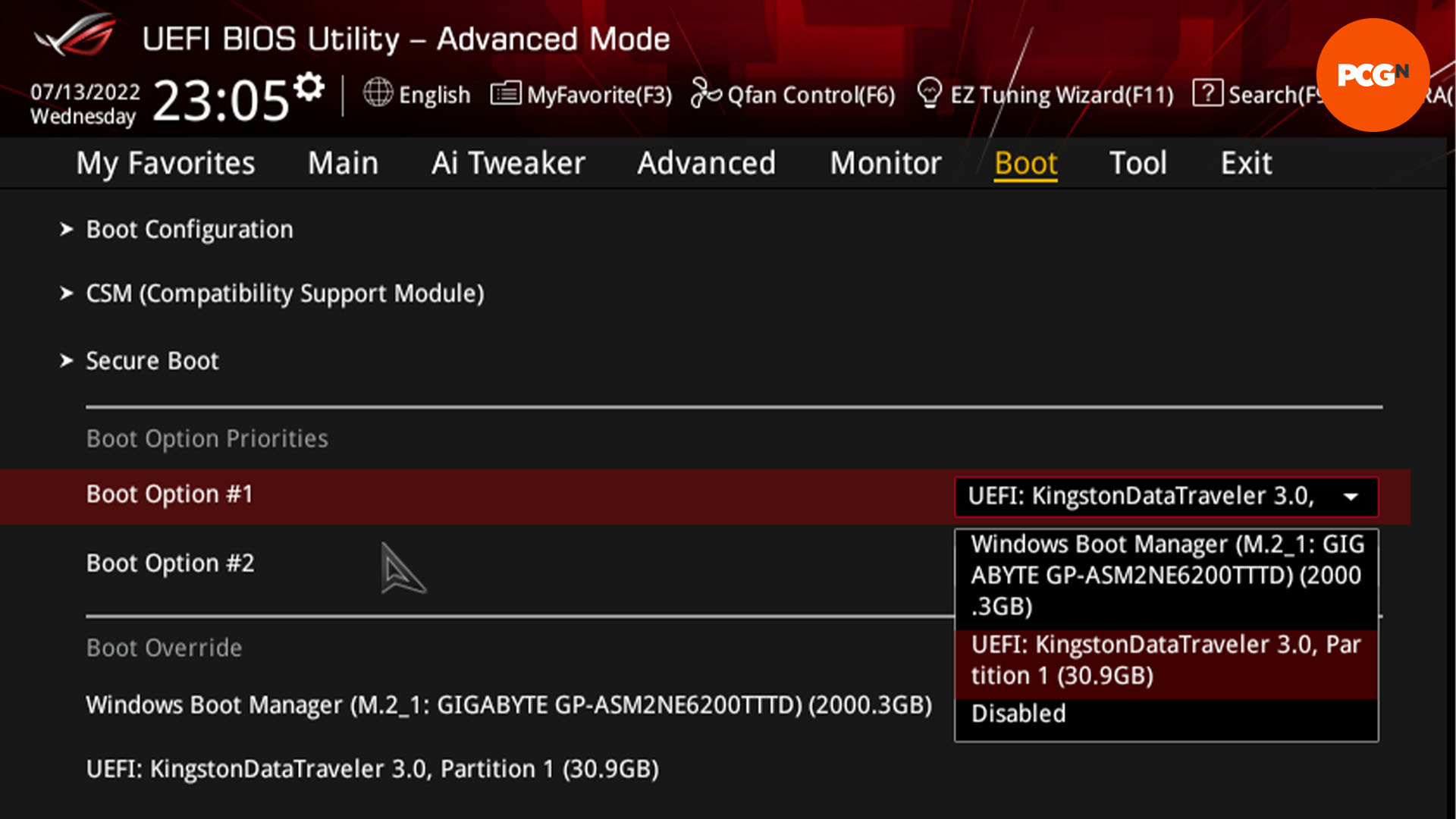
Upon getting your bootable USB flash drive, head to the EFI and discover the boot menu. Choose boot choices and find your USB flash drive, which can point out it has a Home windows set up on it, then choose it as your first boot choice. You then want to avoid wasting and exit your settings and restarting the PC will see it enter the Home windows set up.
Head via the installer’s menus till you get to the half the place you choose the drive and partitions on which to put in Home windows. Right here, it’s best to be capable to establish the storage system onto which you need to set up Home windows, but when not, it’s safer to modify off your PC, disconnect all different storage units other than this drive and your set up USB flash drive, and check out the method once more.
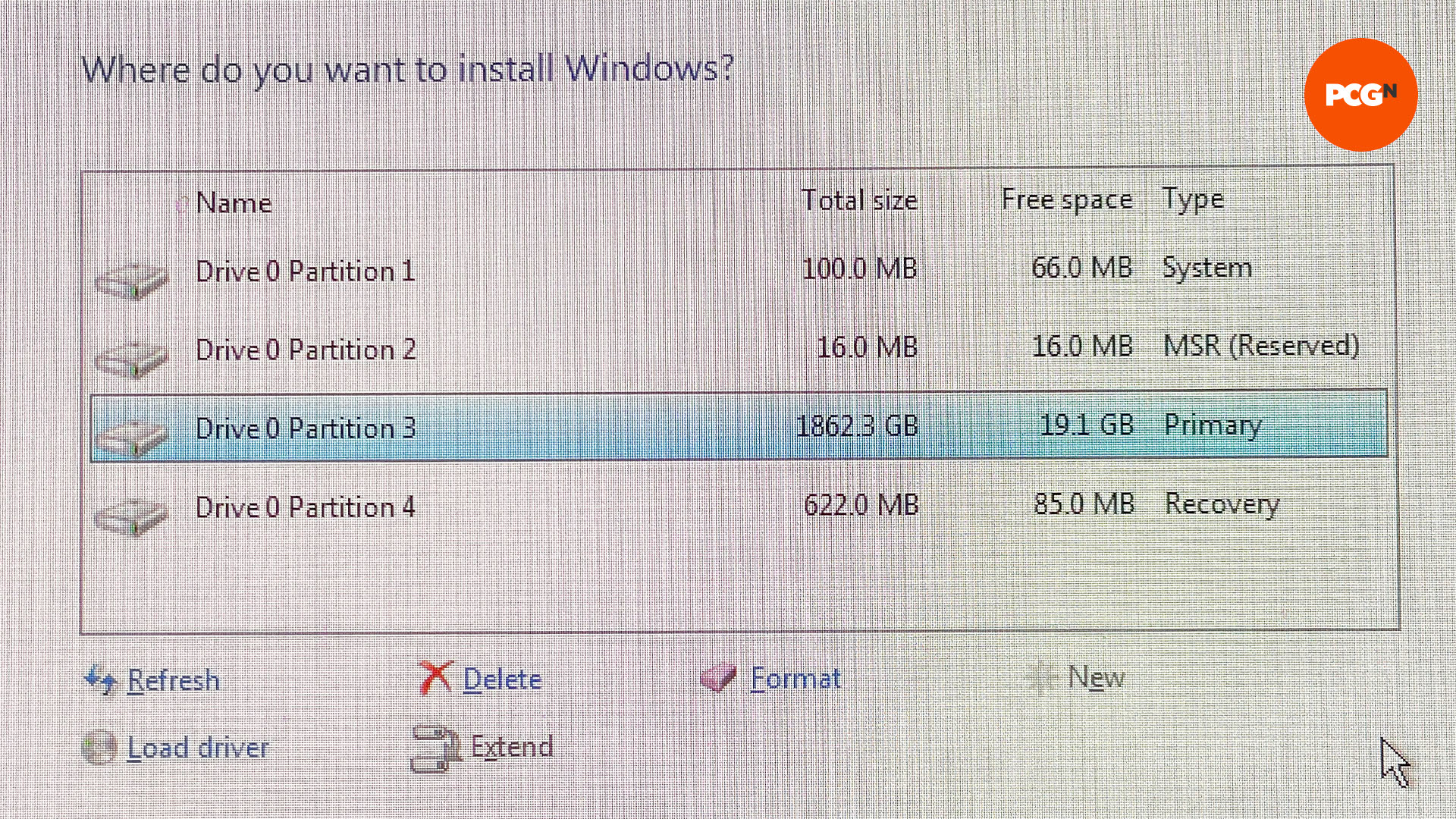
If there are any partitions in your SSD, they’ll present up just like the picture above and you’ll delete them when you not need any recordsdata on the drive when you’re reusing one.
Enable Home windows to do the remainder of the method by clicking on the drive and choosing Set up. When the PC reboots, you’ll be free to enter the EFI once more and swap the first boot system to your SSD moderately than the USB thumb drive – by now, your SSD will point out that it has the beginnings of a Home windows set up on it.
16. Set up your drivers
When you’ve put in Home windows, hopefully, you’ll have entry to the Web, at which level you’ll be able to obtain your motherboard’s chipset drivers from its product internet web page, and seize the most recent networking and sound drivers too.
In case your motherboard’s Wi-Fi or Ethernet adaptors aren’t acknowledged while you first boot into Home windows, and also you don’t have entry to a different PC, it’s finest to get an affordable 802.11ac USB Wi-Fi adaptor from a web-based retailer similar to Amazon.
This primary, old-standard Wi-Fi adaptor can be extra prone to be acknowledged by Home windows than a number of the newest built-in Wi-Fi adaptors, and assist you to connect with your Wi-Fi router and entry the most recent drivers to your {hardware}.
When you’re on-line and in a position to entry your motherboard producer’s web site to obtain the drivers to your particular motherboard, begin by putting in the chipset driver first, then your networking and sound drivers. You additionally must obtain the most recent driver to your graphics card, both from Nvidia or AMD. You’ll be able to then fireplace up Home windows Replace and let it examine for updates and set up any it finds for itself and your {hardware}.
17. Set up your software program
A fast method to set up a number of applications directly mechanically is to make use of Ninite. This lets you choose from a number of installers, similar to Chrome, Firefox, Steam, Skype, Discord and iTunes, and it’ll set up all of them with out you needing to do something.
Some additional bits of software program to seize are CoreTemp, GPU-Z, CPU-Z and Cinebench R23. CoreTemp will present you the CPU temperature and Cinebench R23 can run a ten-minute stress take a look at in your CPU.
So long as the CPU temperature doesn’t prime 90°C you’ll be high-quality. In the meantime, GPU-Z does the identical to your graphics card, besides it’s value taking part in your standard video games for half-hour and recording the height GPU temperature. So long as it isn’t topping 80°C regularly then it’s high-quality.
And that’s all the pieces you must find out about constructing a PC – we hope you get pleasure from taking part in along with your new gaming rig. If you wish to know which merchandise you must purchase to construct the most effective gaming PC, be sure to additionally take a look at our full information to the most effective PC case, in addition to our greatest SSD for gaming information.

